Vùjá de – Paper Thresholds
November 30, 2024 – February 01, 2025
Galerie Barbara Wien, Berlin, Germany
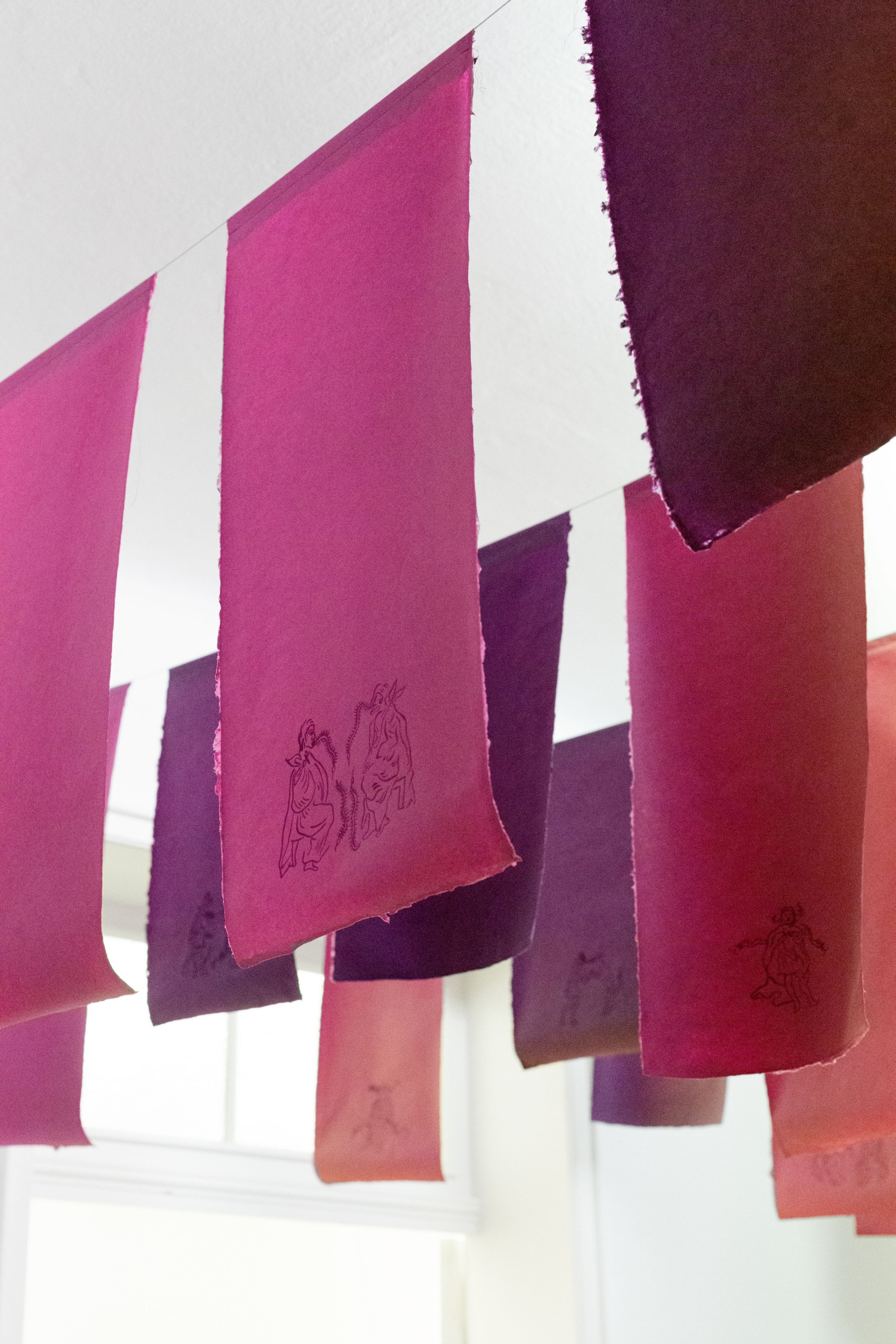
Paper Portal, 2024
Site-responsive installation, Watercolour on handmade paper
Galerie Barbara Wien, Berlin, DE, November 30, 2024 – February 1, 2025
Photograph courtesy of Barbara Wien and Mariana Castillo Deball © Barbara Wien
As I frequently study documents which have been altered, destroyed or stored in distant and inaccessible libraries and museums, I often work with printed copies, facsimiles and digital reproductions. From a Western, art historical point of view, these copies are mere supplements of the original object, without any value of their own. Yet, it was the ravages of colonisation and looting that caused us to produce such copies in the first place, as a means of holding and protecting; if one goes missing, we will still have multiple versions. I would therefore like to think of this genealogy of copies as a dissonant polyphony, a collective yet anonymous heritage. We can think of these documents as objects that have experienced a trauma shared by the group protecting their memory. The Nahua concept of ixiptlacan account for this multilayered approach. Translating to "representation," "impersonation," or "substitute," it encompasses all these different versions, representations, and echoes, as part of the original, even if such an original no longer exists.
The title of the exhibition is inspired by Roy Wagner‘s book Coyote Anthropology (2010), in which the US-American anthropologist explores the concept of vùjá de – an inversion of the more familiar notion of déjà vu. Wagner critically discusses the role of the anthropologist and the object of anthropological study, looking at how the presence of anthropologists alters the environments in which they work. In this context, vùjá de refers to encountering something familiar but seeing it in a completely new, unexpected way – as if for the first time. Wagner suggests that vùjá de is a crucial aspect of anthropological thinking, encouraging defamiliarisation of the taken-for-granted aspects of culture. By seeing the familiar as unfamiliar, it becomes possible to understand and reinterpret it in innovative ways. When I read Coyote Anthropology, I felt that translating it into Spanish would be the only way to encapsulate the text. I contacted Wagner in 2010 and proposed a collaboration involving his words and my drawings. We kept up a correspondence that lasted several years and resulted in the publication of the book Antropología del Coyote: Una conversación en palabras y dibujos in 2018.
Entering the gallery, visitors pass under Paper Portal , an installation consisting of handmade sheets of paper suspended below the ceiling. When we think about paper, we often relate it to a volume in which many pages are bound to form a book. However, as artist Dorothy Field explores in her publication Paper and Threshold (2007), paper has been extensively used in public space to create portals and transitory spaces. In this form, handmade paper carries a spiritual and cultural significance, transcending its practical use to act as a bridge between the human and spiritual realms in cultures such as Japan, Korea, Burma, Nepal, and India.
The paper used for Paper Portal was hand-made in Berlin by Gangolf Ulbricht, who I have been working with since 2022. He is a specialised paper maker who uses traditional techniques and further develops them through collaborative experiments with artists and other paper enthusiasts. The paper pulp was dyed using cochineal – a natural, red dye which can also create hues of pink and purple depending on the pH level of its mixture. Cochineal originated in the Americas and is derived from the cochineal insect (Dactylopius coccus), a type of scale insect that lives on cacti and is native to Central and South America. Developed for textiles and art by the Indigenous peoples of the Americas, primarily by the Aztecs and Maya in what is now central Mexico, cochineal was closely tied to colonial trade. It became a valuable export during the 16th century and highly sought after in Europe. Because it was far superior in colour and stability to red dyes from Europe, colonial Spain closely guarded the source of cochineal, treating it as a state secret to maintain their monopoly. I added drawings onto some of the suspended sheets of Paper Portal which refer to Diego de Valadés‘ Retórica Cristiana (1579). Valadés was a Tlaxcalan-Spanish friar who sought to evangelise native peoples and teach them how to read and write. These specific drawings address the censorship imposed by the colonial state, prohibiting native languages and ceremonies. The “forbidden” native words and actions are depicted as insects and snakes emerging from the characters.
Using the leftover pulp from the paper-making process, we created a series of papier-mâché reliefs at the studio. In the exhibition, I am showing both the ceramic moulds we used to create these reliefs, titled Vùjá de, and the papier-mâché works themselves, Déjà vu, thus blurring the Western hierarchy of original and copy in the spirit of ixiptla.
I have been working with natural pigments from Mexico, like cochineal, and their history since 2018 when I collaborated with researcher Tatiana Falcón on the exhibition In Tlilli in Tlapalli, Imágenes de la nueva tierra: Identidad indígena después de la Conquista at the Museo Amparo in Puebla, Mexico to create pigments. We planted a garden for trees, wild seasonal plants, bushes, insects, and lichens named in the Florentine Codex (ca. 1540–1569) as the ingredients necessary to make the most important coloured pigments and dyes used by the Nahua, one of the Indigenous peoples of Mexico.
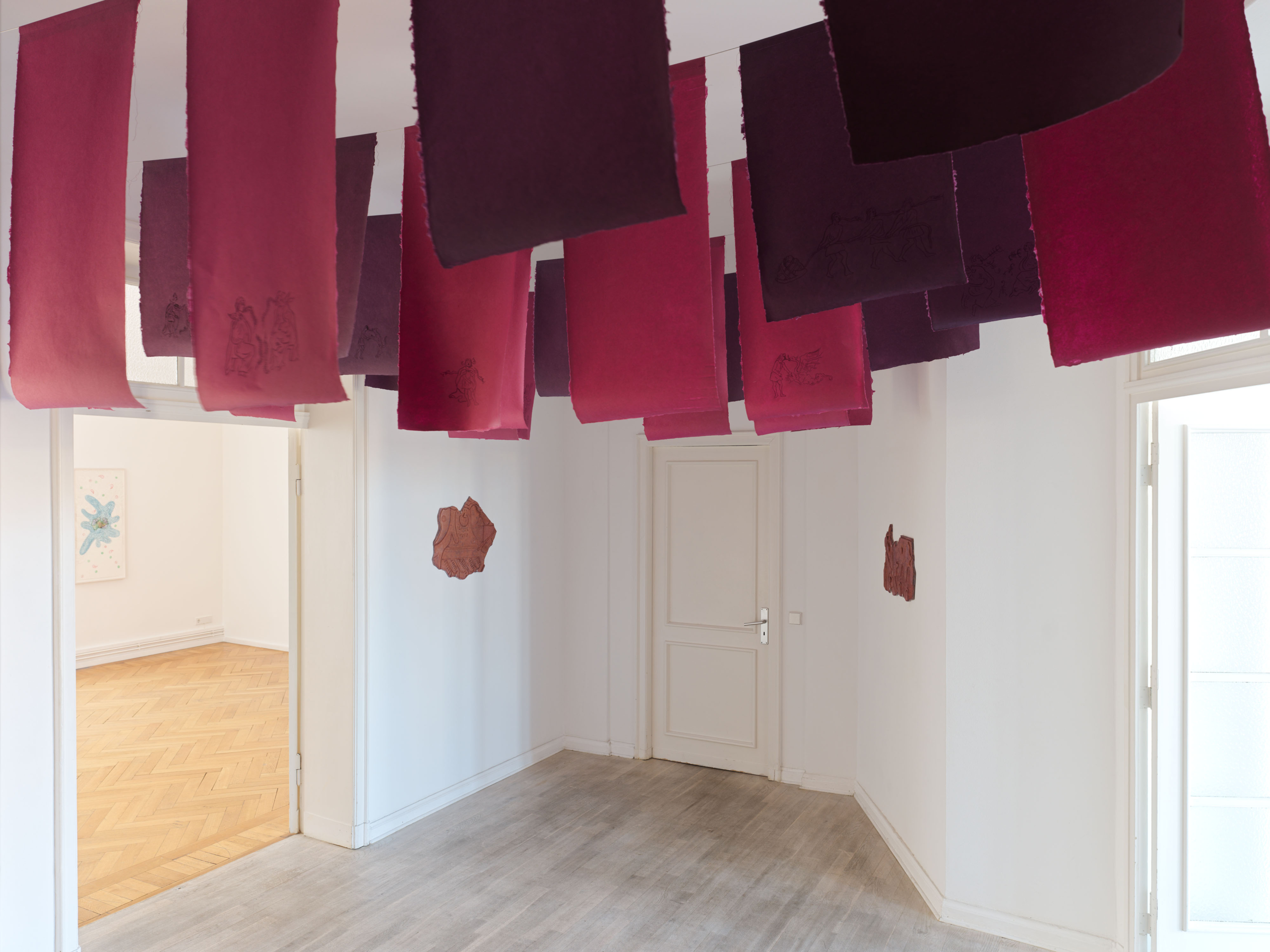
Paper Portal, 2024
Site-responsive installation, Watercolour on handmade paper, 18 m
Galerie Barbara Wien, Berlin, DE, November 30, 2024 – February 1, 2025
Photograph courtesy of Barbara Wien and Mariana Castillo Deball © Barbara Wien
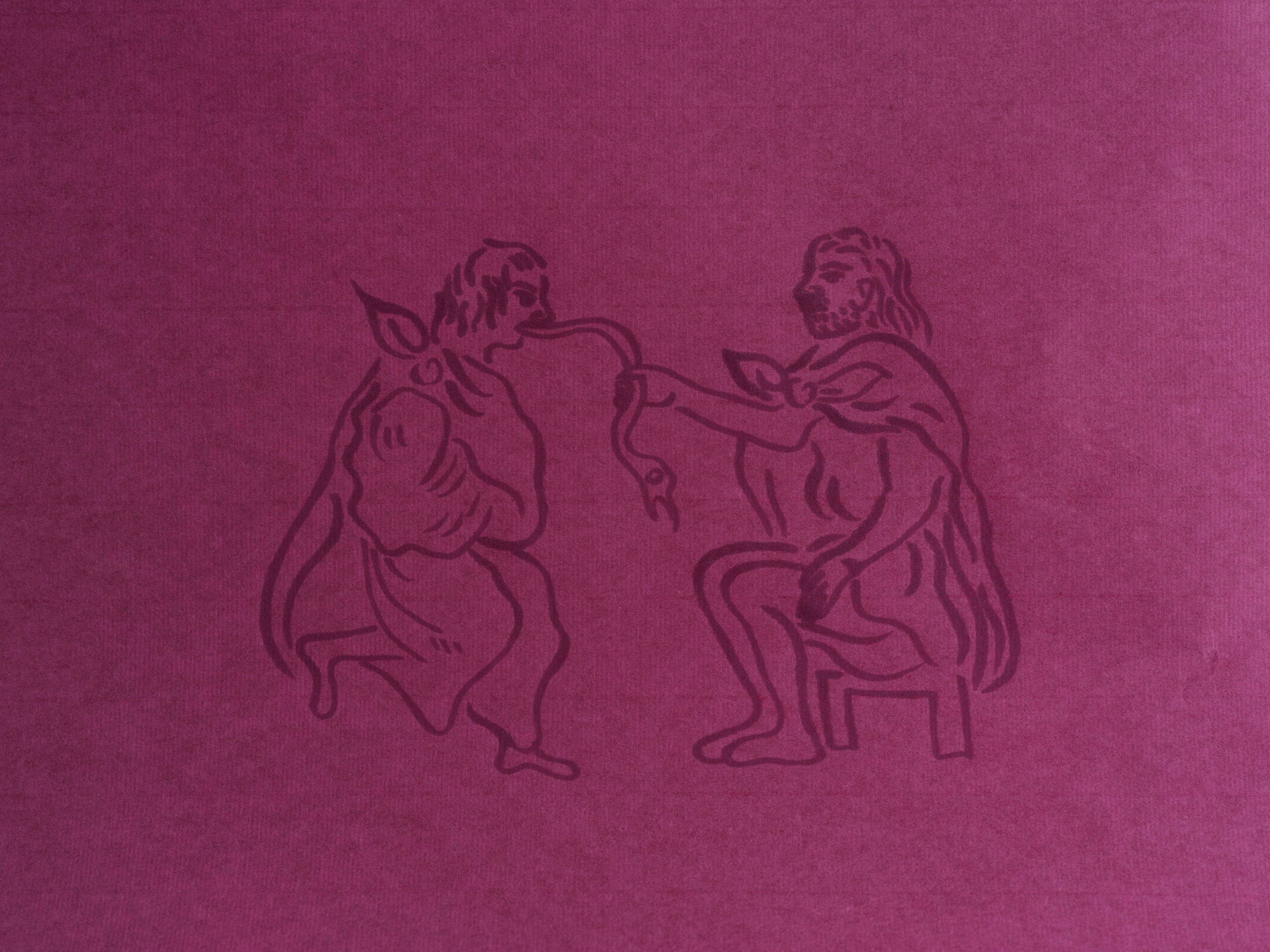
Forbidden conversations, 2024
Watercolour on handmade paper
Galerie Barbara Wien, Berlin, DE, November 30, 2024 – February 1, 2025
Photograph courtesy of Barbara Wien and Mariana Castillo Deball © NickAsh
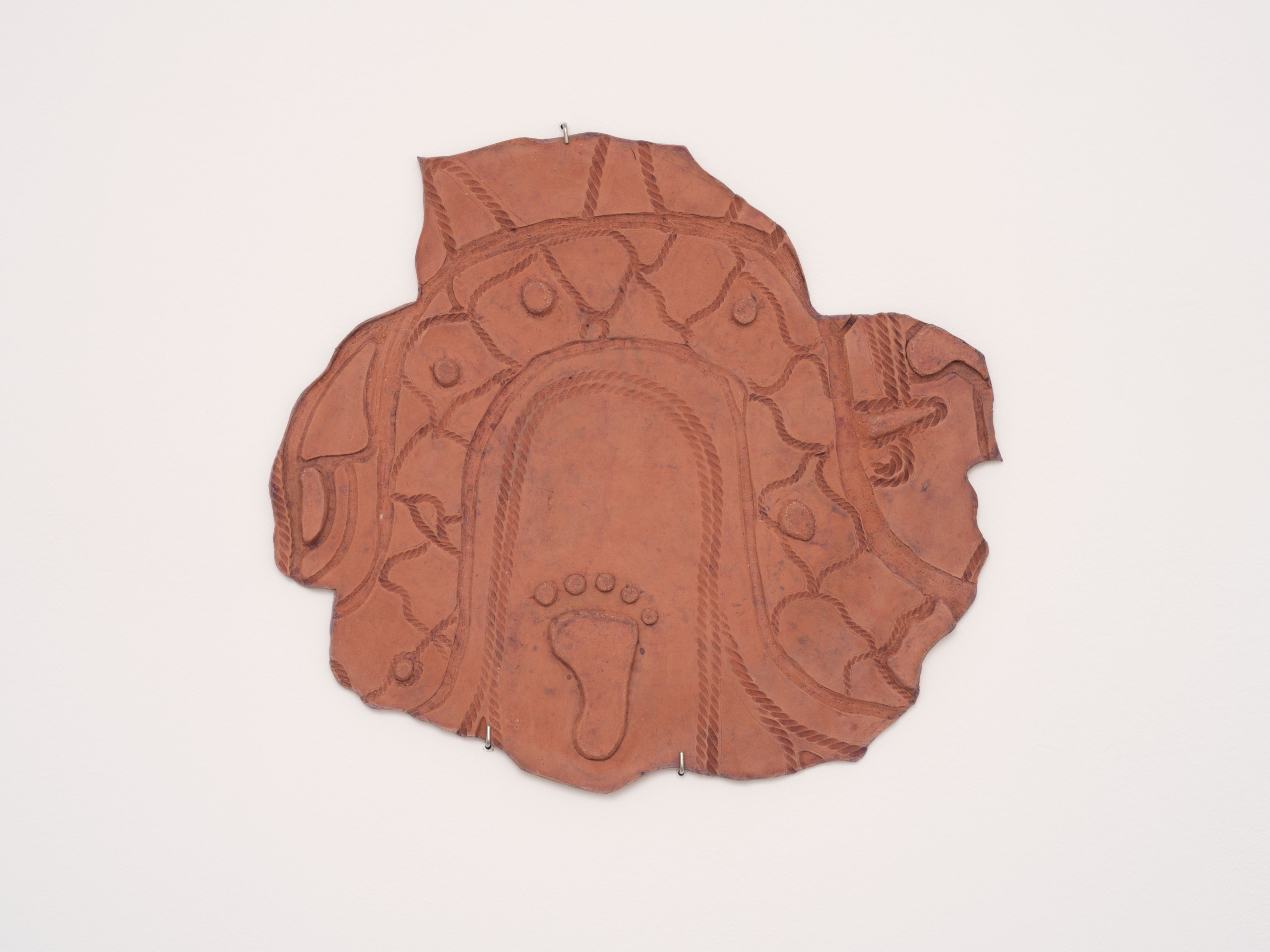
Vùjá de 6, 2024
Ceramic relief, 54 x 60 cm
Galerie Barbara Wien, Berlin, DE, November 30, 2024 – February 1, 2025
Photograph courtesy of Barbara Wien and Mariana Castillo Deball © NickAsh
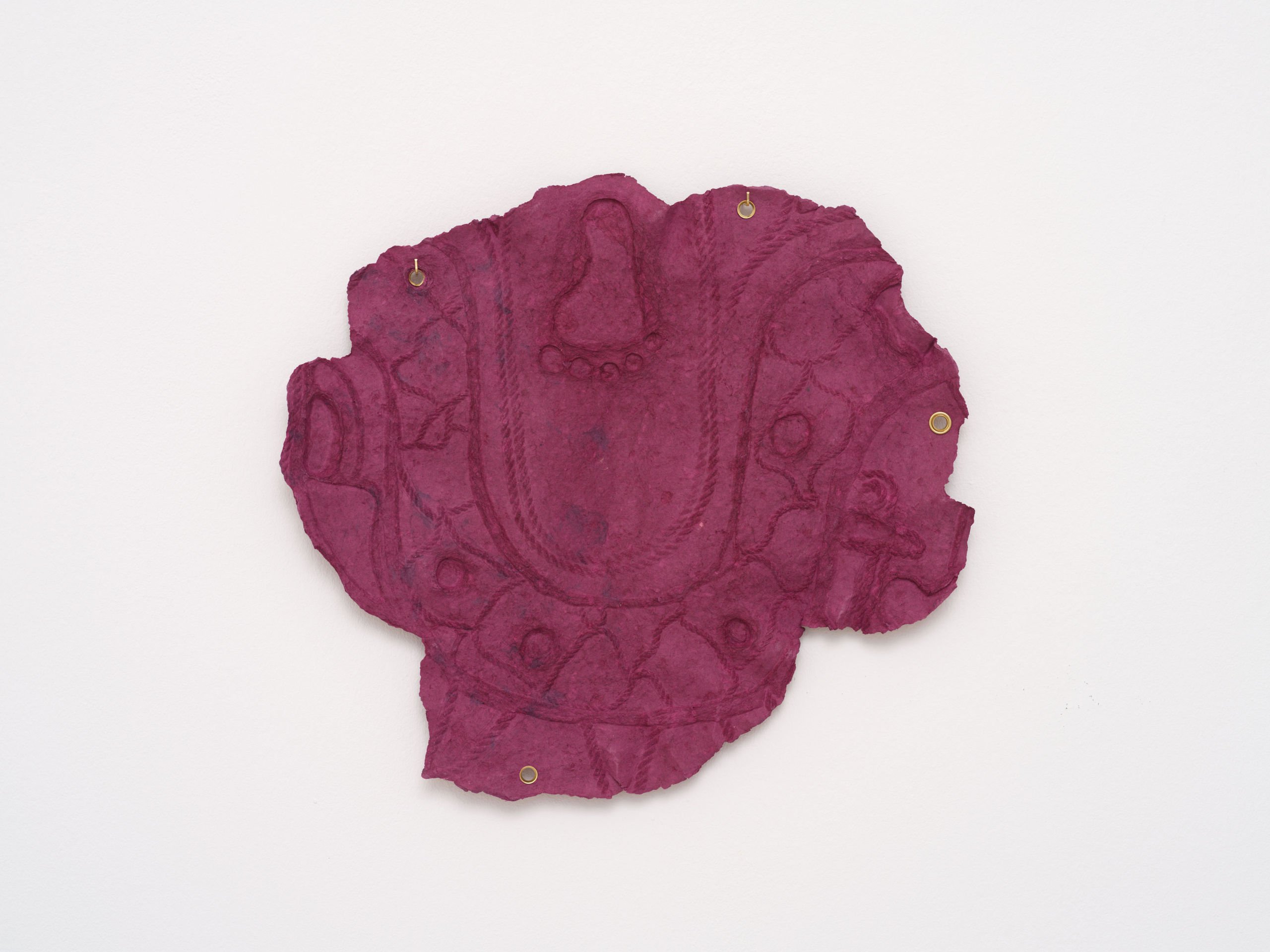
Déjà vu 1, 2024
Papier-mâché relief, 50 x 55 cm
Galerie Barbara Wien, Berlin, DE, November 30, 2024 – February 1, 2025
Photograph courtesy of Barbara Wien and Mariana Castillo Deball © NickAsh

Déjà vu 3, 2024
Papier-mâché relief, 49 x 47 cm
Galerie Barbara Wien, Berlin, DE, November 30, 2024 – February 1, 2025
Photograph courtesy of Barbara Wien and Mariana Castillo Deball © NickAsh
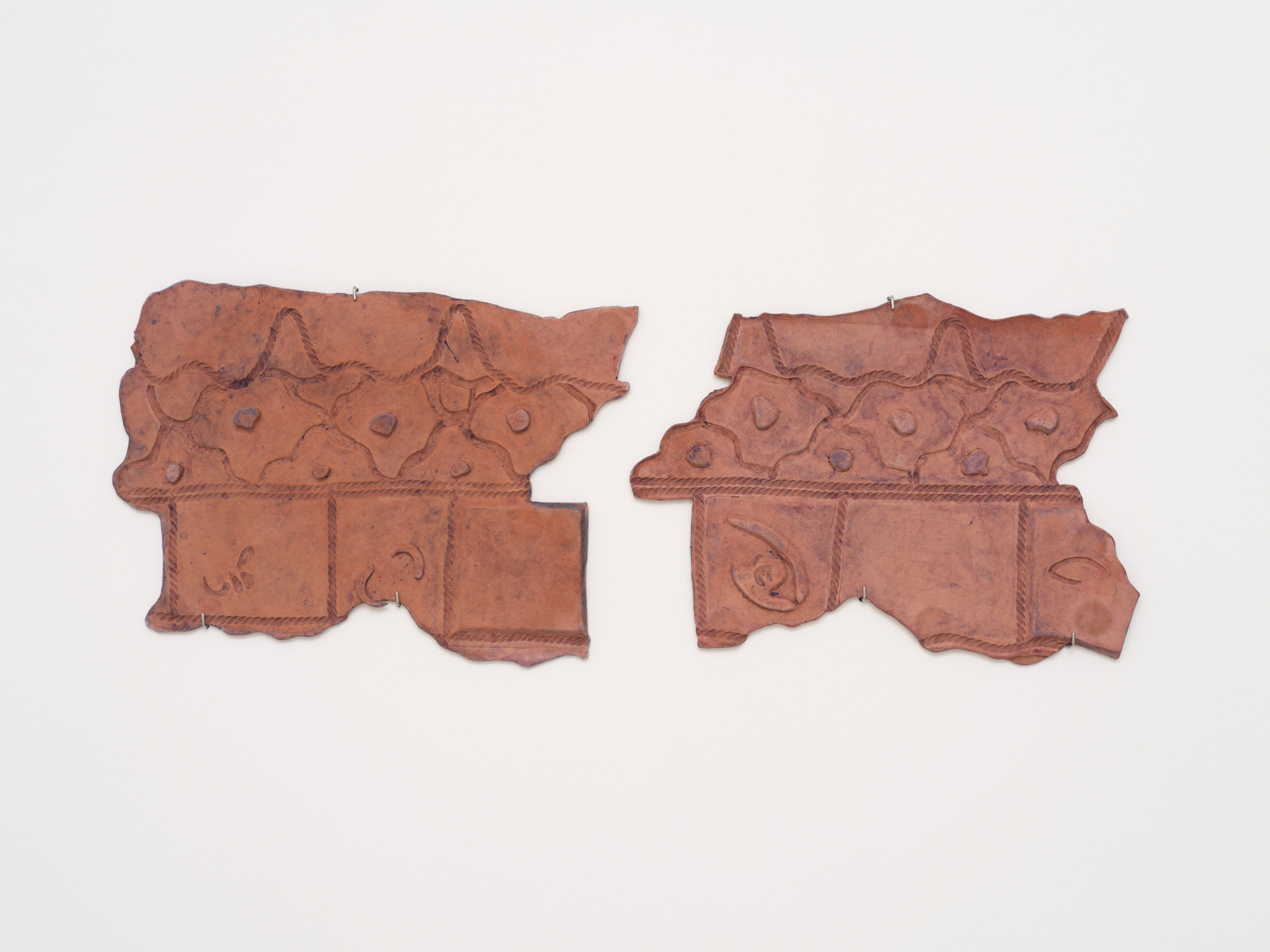
Installation view of Vùjá de – Paper Thresholds
Galerie Barbara Wien, Berlin, DE, November 30, 2024 – February 1, 2025
Photograph courtesy of Barbara Wien and Mariana Castillo Deball © NickAsh
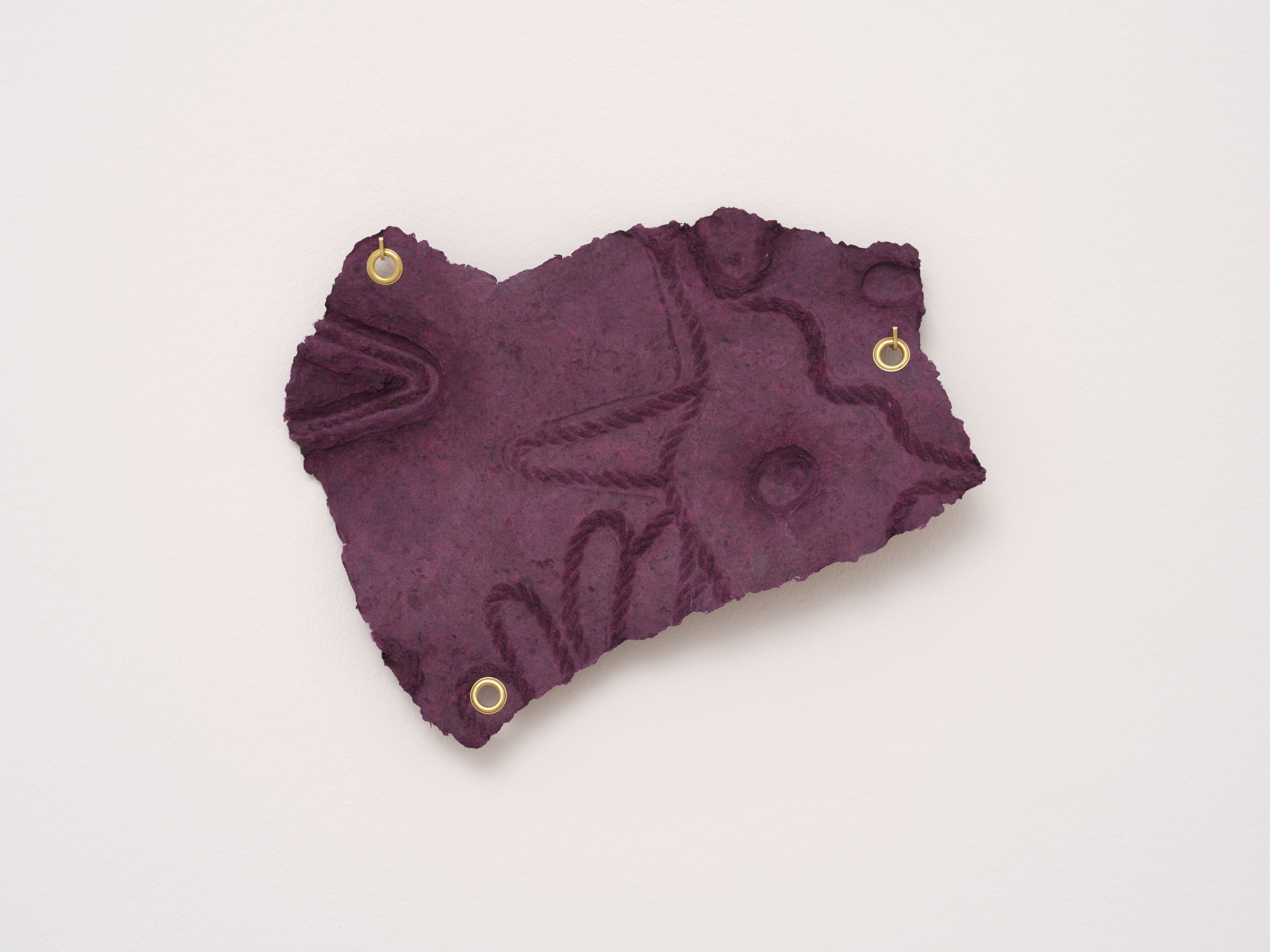
Déjà vu 4, 2024
Papier-mâché relief, 22 x 33 cm
Galerie Barbara Wien, Berlin, DE, November 30, 2024 – February 1, 2025
Photograph courtesy of Barbara Wien and Mariana Castillo Deball © NickAsh
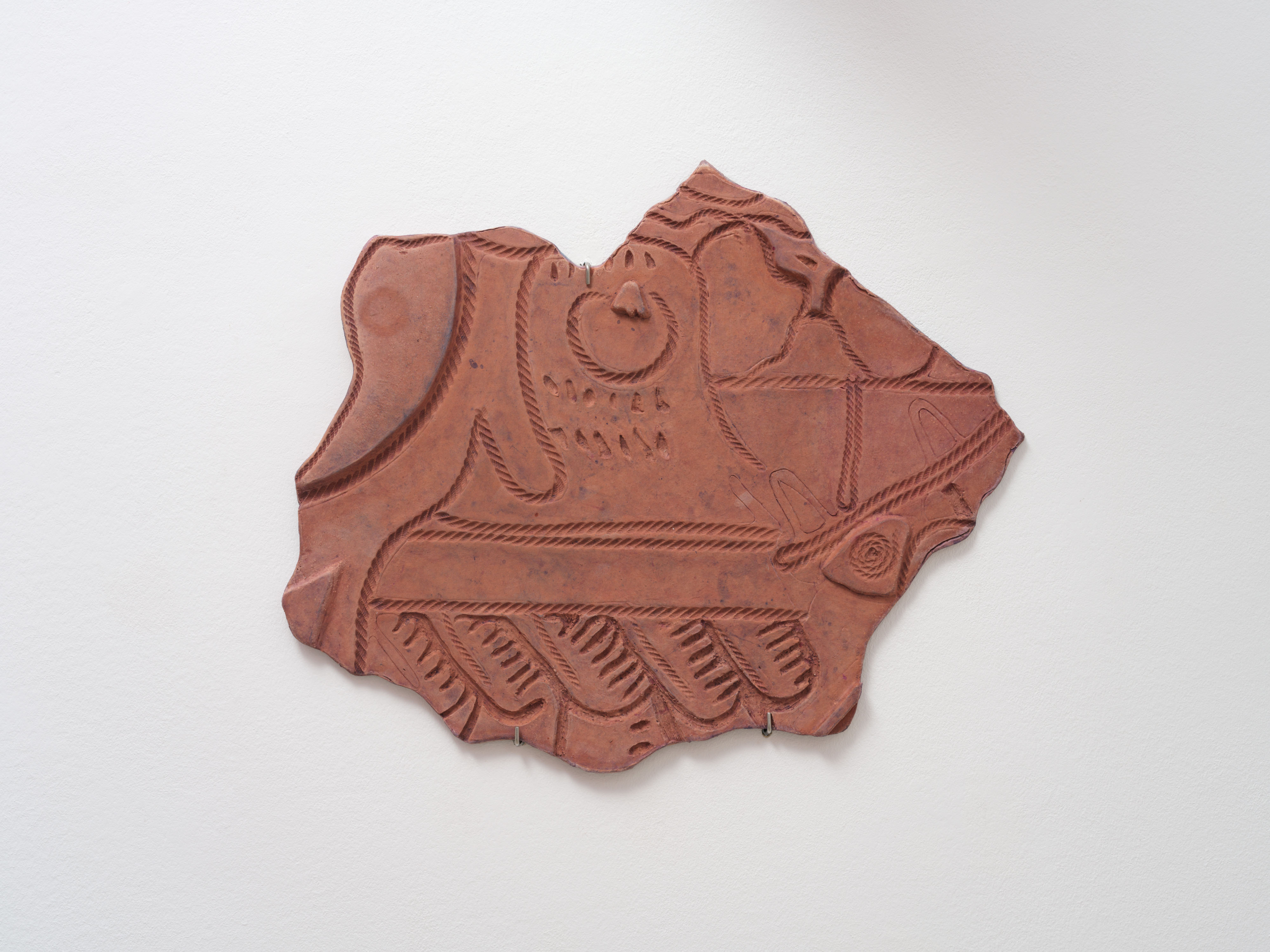
Vùjá de 1, 2024
Ceramic relief, 52 x 63 cm
Galerie Barbara Wien, Berlin, DE, November 30, 2024 – February 1, 2025
Photograph courtesy of Barbara Wien and Mariana Castillo Deball © NickAsh
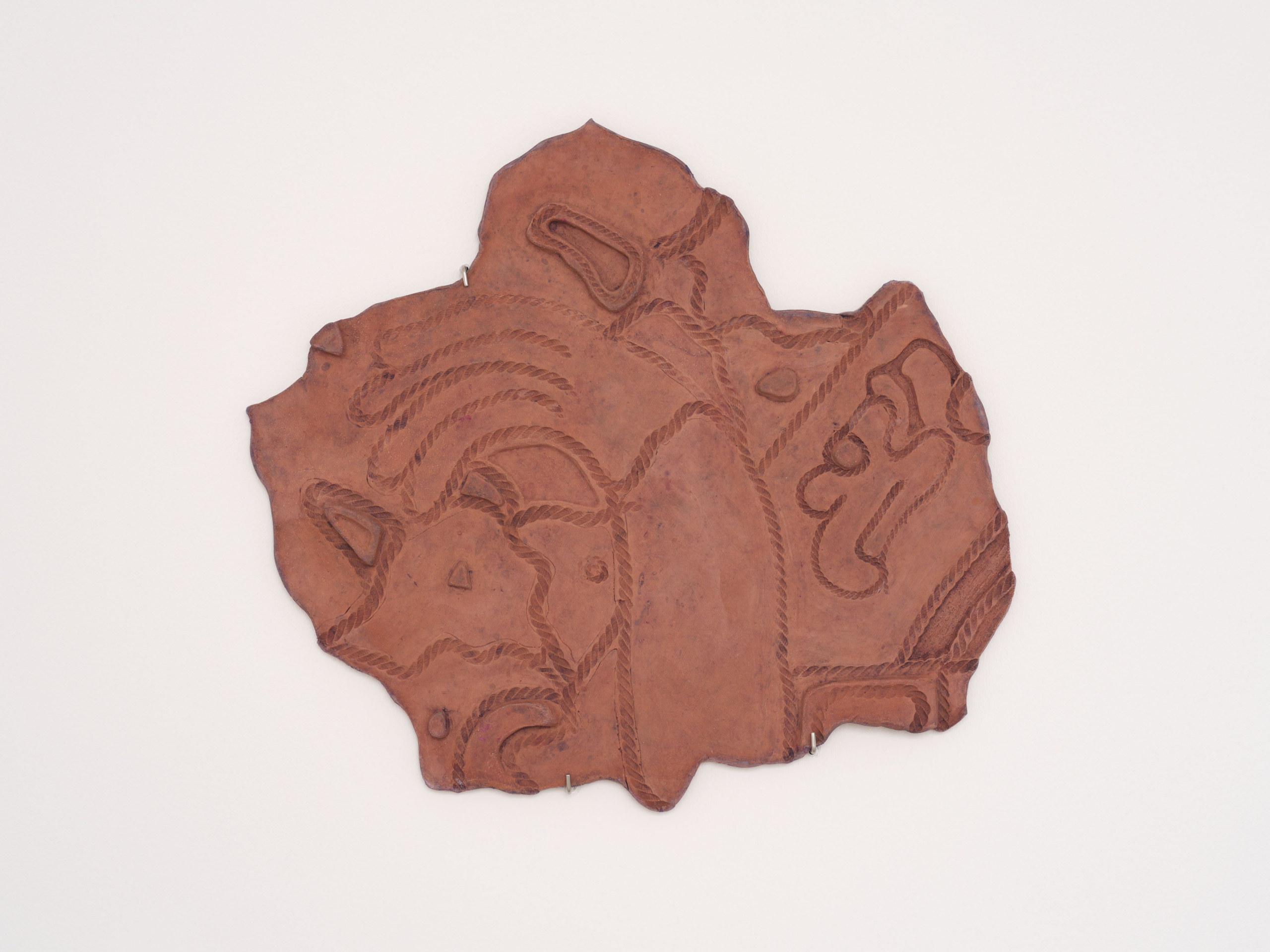
Vùjá de 5, 2024
Ceramic relief Keramik-Relief, 54 x 56 cm
Galerie Barbara Wien, Berlin, DE, November 30, 2024 – February 1, 2025
Photograph courtesy of Barbara Wien and Mariana Castillo Deball © NickAsh
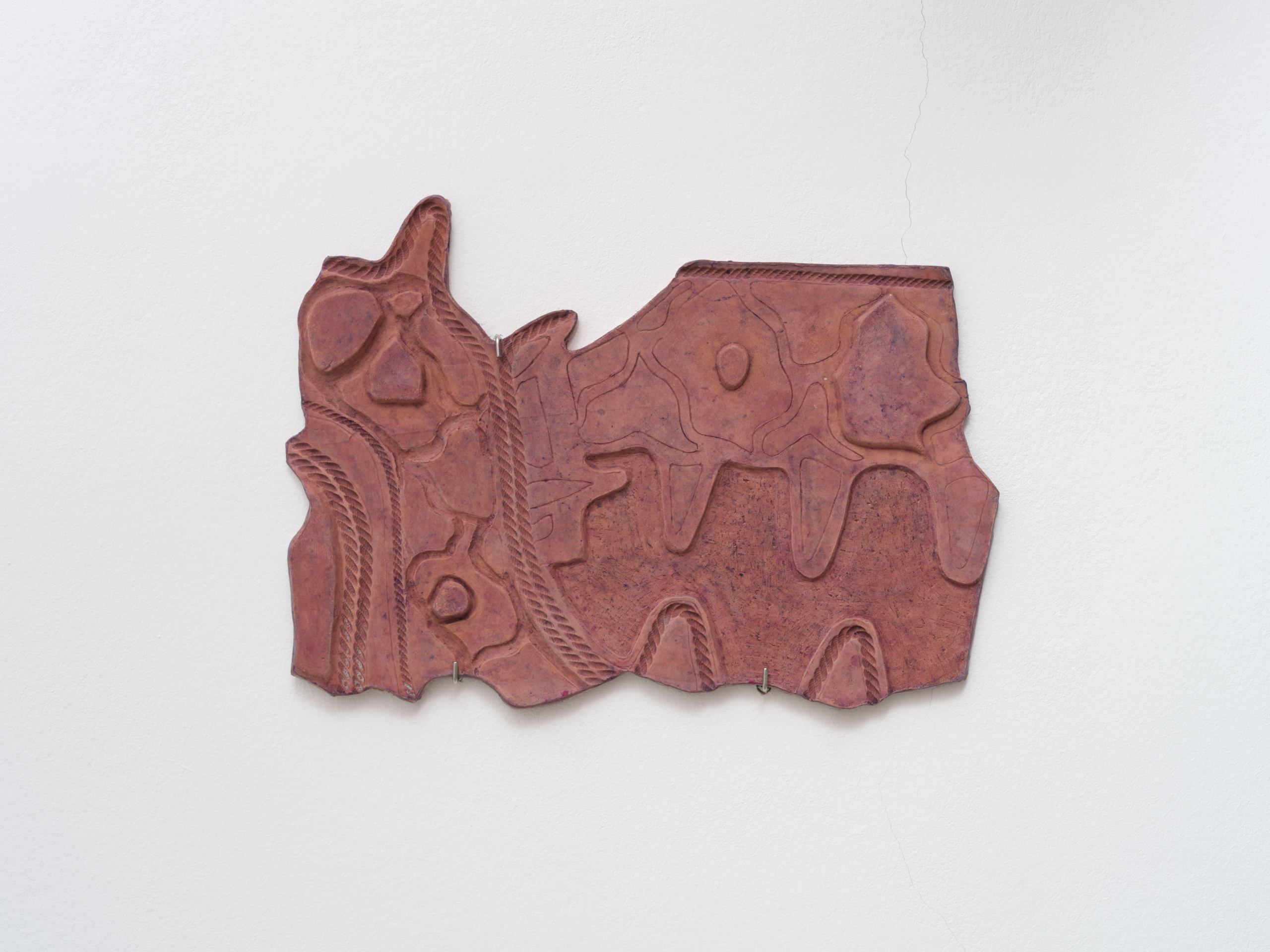
View of Vùjá de 2, 2024
Ceramic relief, 38 x 53 cm
Part of Vùjá de – Paper Thresholds Exhibition
Galerie Barbara Wien, Berlin, DE, November 30, 2024 – February 1, 2025
Curator: Barbara WIen
Photograph courtesy of Barbara Wien and Mariana Castillo Deball © NickAsh
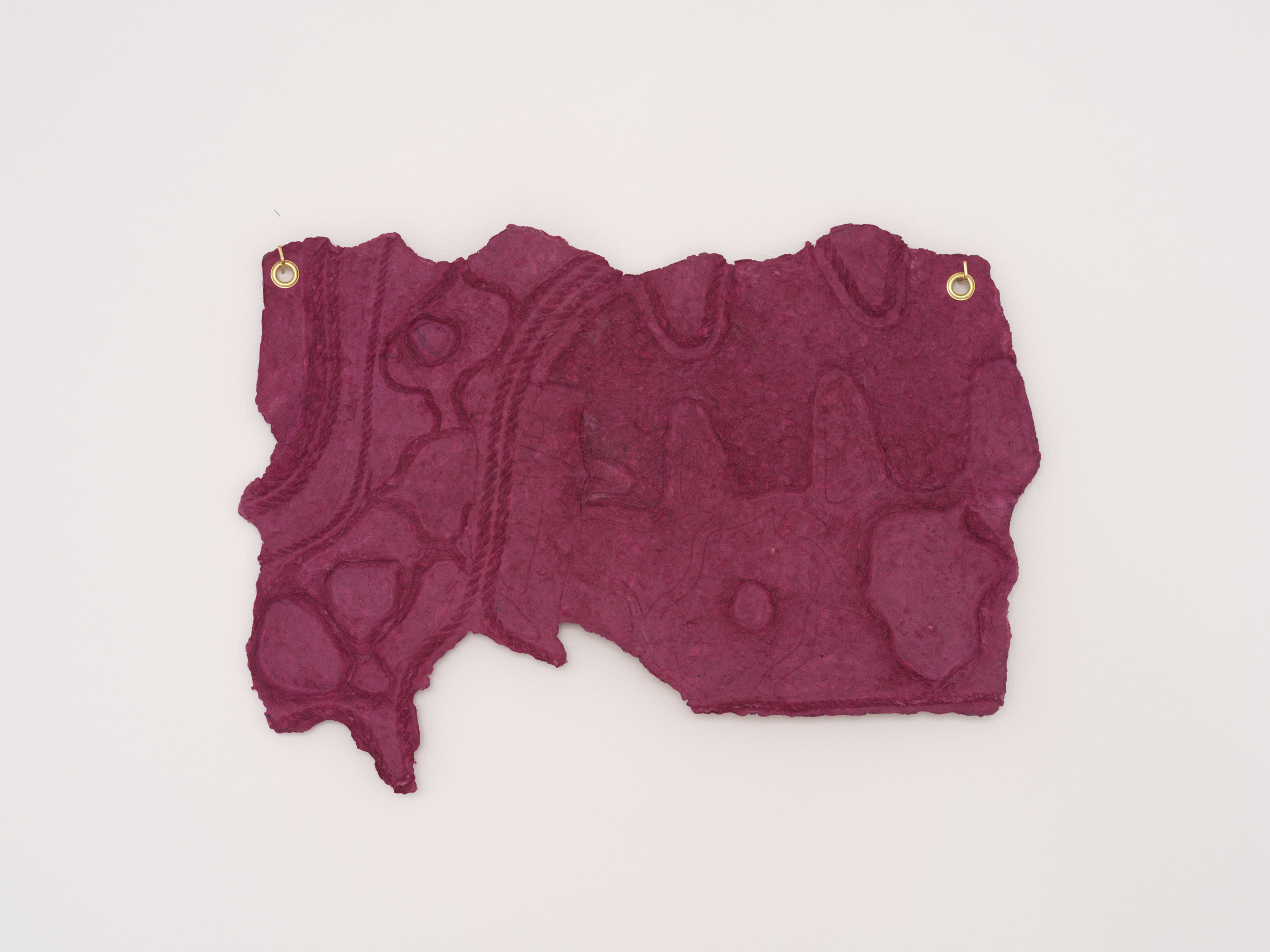
Déjà vu 2, 2024
Papier-mâché relief, 34 x 47 cm
Galerie Barbara Wien, Berlin, DE, November 30, 2024 – February 1, 2025
Photograph courtesy of Barbara Wien and Mariana Castillo Deball © NickAsh
The series of framed watercolour drawings in the south room, titled Contra Infantium Adustione, is also made with pigments that Falcón elaborated. This time, the pigments and the drawings’ motifs are based on the plants depicted in the Codex Cruz-Badiano. This codex, written in 1552, contains Nahua medicinal recipes compiled by Indigenous scholars of the College of Santa Cruz de Tlatelolco. I began by making sketches based on a drawing from plate 53 of the Codex Cruz-Badiano. I liked this drawing in particular because the roots of the plant grow out of and around a stone, with water coming out of its centre. I tried to imagine what it would be like to get into the centre of that stone – root – water and draw the plant from there. I liked this exercise because it was no longer about the repetition or copy of the original drawing, but about finding a new place from which to feel the growth of the plant. After many sketches, I finally dared to start painting with Tatiana‘s pigments, which took some time getting used to since I had to understand how and with what to mix them. The drawings gradually escaped from their original referent, the Codex Cruz-Badiano, and became a means to spread the precious luminous liquid as the pigments, their brilliance and materiality became the protagonists.
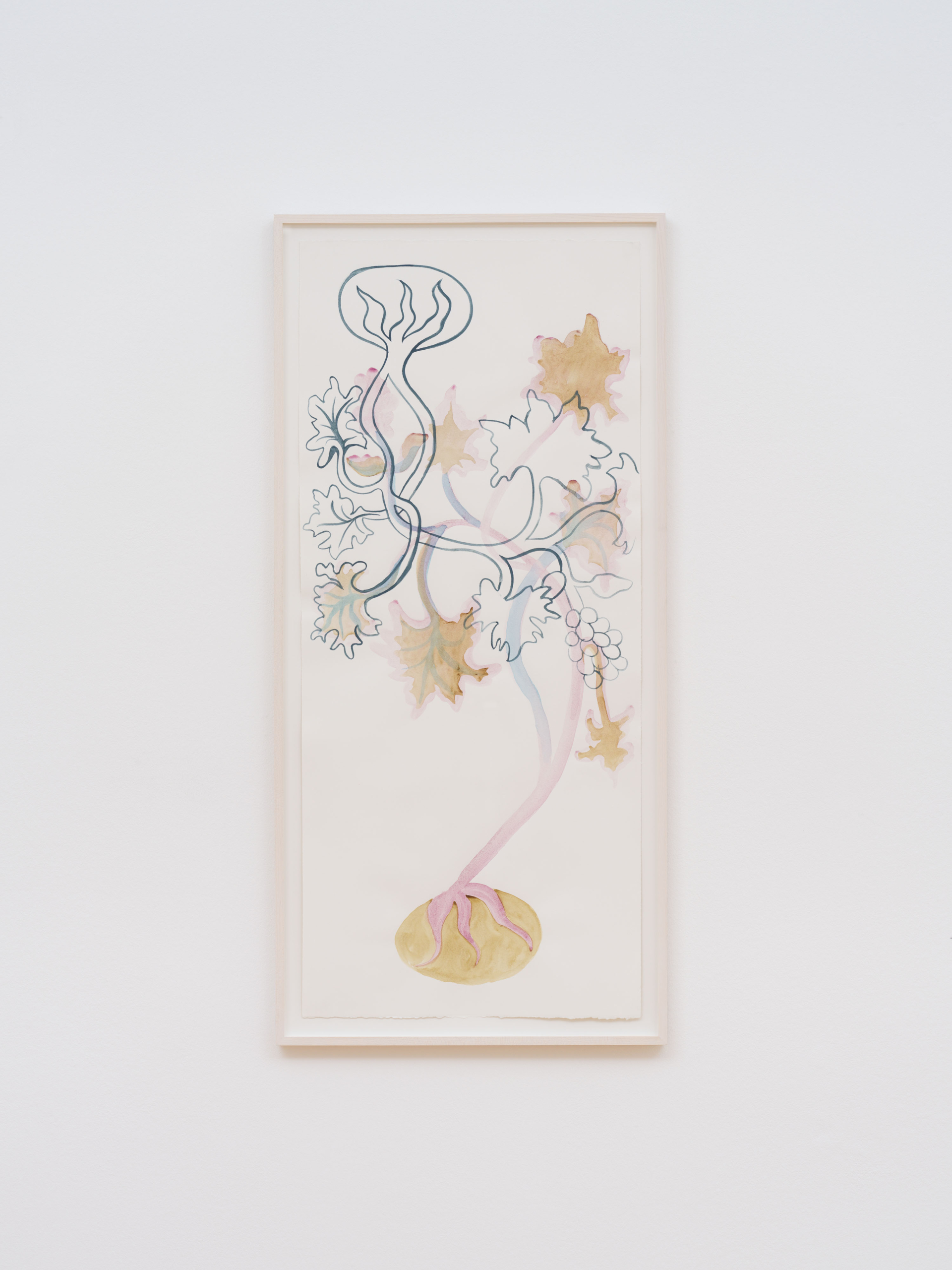
Contra Infantium Adustione 3, 2024
Watercolour on paper, 114 x 50 cm
Galerie Barbara Wien, Berlin, DE, November 30, 2024 – February 1, 2025
Photograph courtesy of Barbara Wien and Mariana Castillo Deball © NickAsh
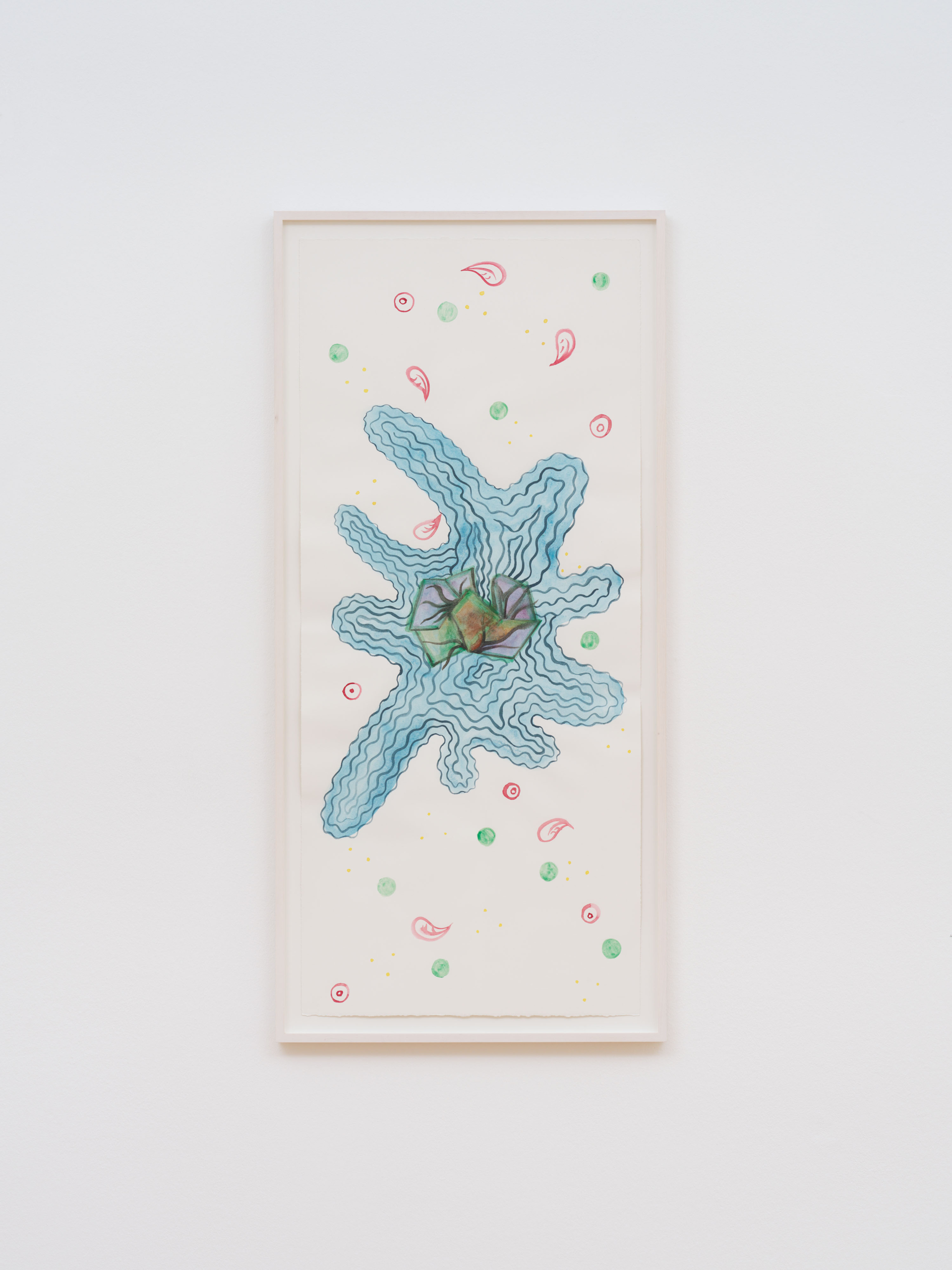
Contra Infantium Adustione 1, 2024
Watercolour on paper, 114 x 50 cm
Galerie Barbara Wien, Berlin, DE, November 30, 2024 – February 1, 2025
Photograph courtesy of Barbara Wien and Mariana Castillo Deball © NickAsh
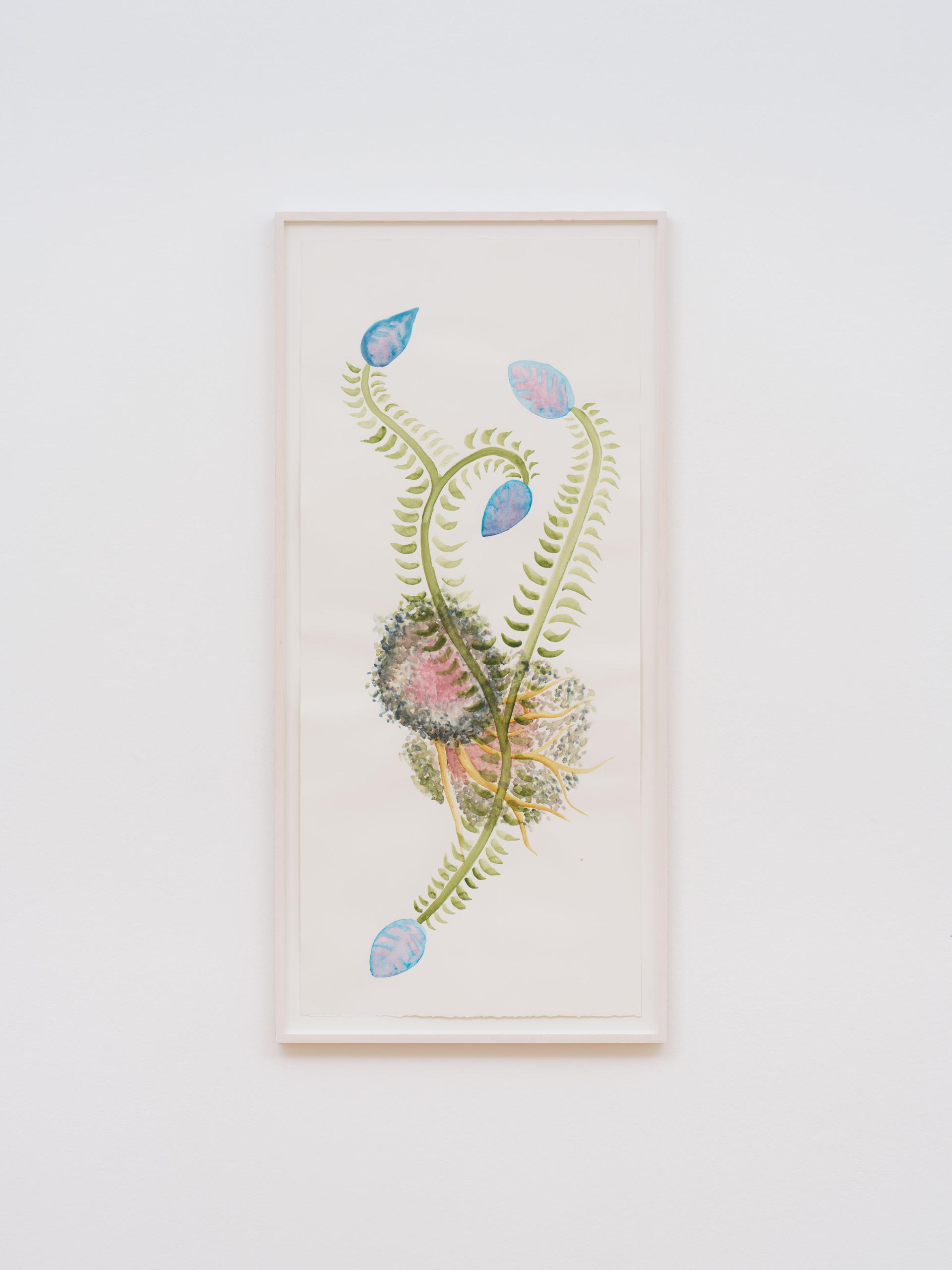
Contra Infantium Adustione 4, 2024
Watercolour on paper, 114 x 50 cm
Galerie Barbara Wien, Berlin, DE, November 30, 2024 – February 1, 2025
Photograph courtesy of Barbara Wien and Mariana Castillo Deball © NickAsh
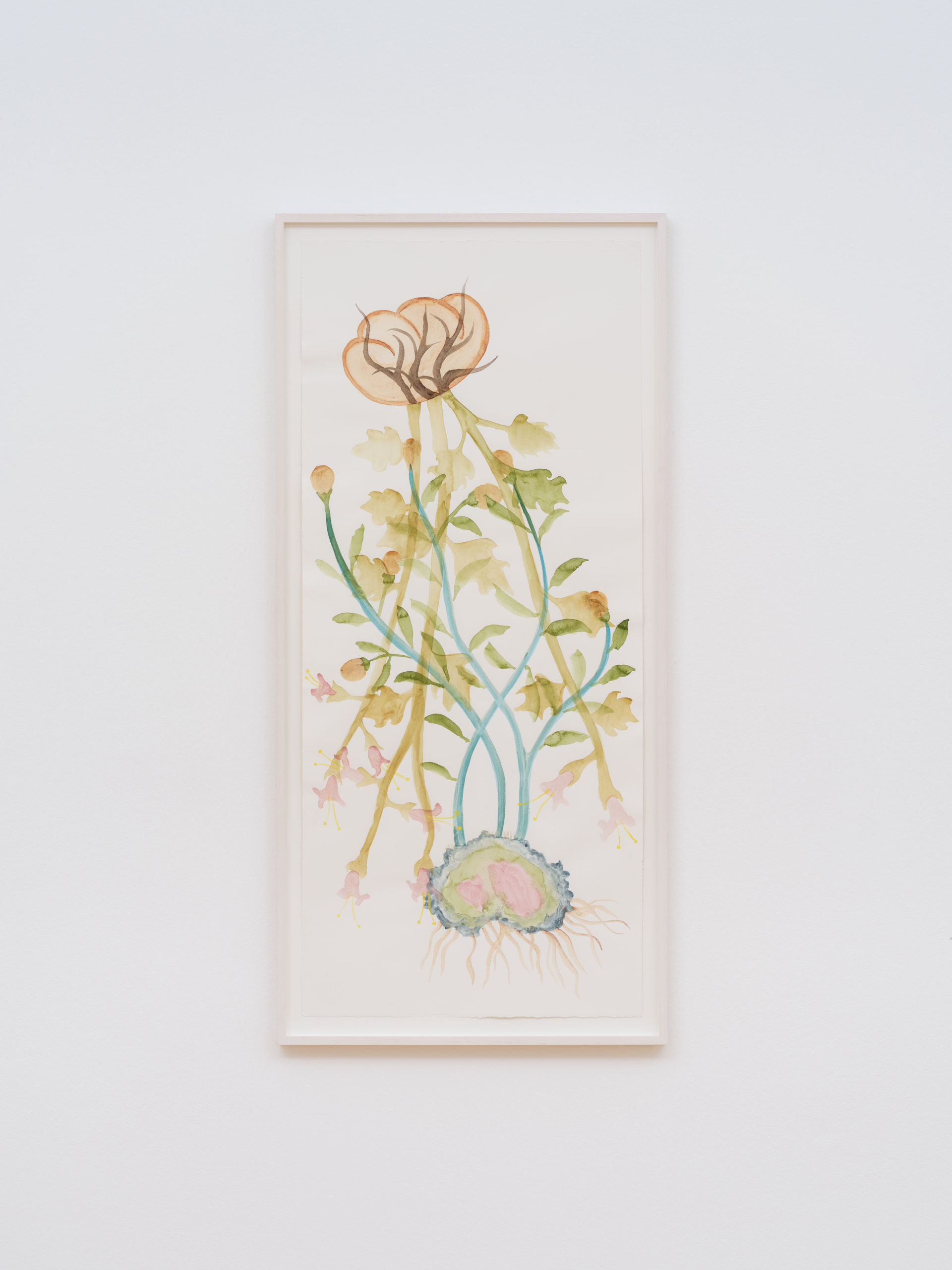
Contra Infantium Adustione 2, 2024
Watercolour on paper, 114 x 50 cm
Galerie Barbara Wien, Berlin, DE, November 30, 2024 – February 1, 2025
Photograph courtesy of Barbara Wien and Mariana Castillo Deball © NickAsh

Burning of Idols, 2024
Site-responsive mural, 330 x 260 cm
Galerie Barbara Wien, Berlin, DE, November 30, 2024 – February 1, 2025
Photograph courtesy of Barbara Wien and Mariana Castillo Deball © NickAsh
The two murals in the gallery‘s south and north room also refer to manuscripts from the region that is now Mexico.
The wall painting, Burning of Idols, in the south room is based on a drawing of the same name from the historical manuscript Description of the City and Province of Tlaxcala (1581–1584) written by Diego Muñoz Camargo, a Mestizo (meaning of Indigenous American and Spanish ancestry) historian from New Spain. The manuscript emphasises Tlaxcala‘s role as a loyal ally to Spain and its contribution to the fall of the Aztec Empire, blending traditional Mesoamerican pictorial styles with European influences. This specific drawing depicts the destruction of images, masks, and religious paraphernalia of Nahua deities at the hands of Catholic friars in the 16th century, shortly after the Spanish conquest. As a Catholic and a loyal servant of the Spanish crown, Muñoz Camargo supported the destruction of these "idols," yet he meticulously rendered the masks of specific Nahua deities, like Quetzalcoatl and Ehecatl, above the flames. Muñoz Camargo‘s account thus preserves the pre-colonial past, records its destruction and depicts the dawn of a new Christian age.
The second wall painting, Crocodile Skin of the Days, which runs along one of the walls in the north room, refers to plates 39 and 40 of a Tonalamatl (Nahuatl, meaning "book of days") known as the Codex Borgia (ca 1300–1500). The Tonalamatl is one of the few pre-colonial calendars of Indigenous peoples in Mexico which survived the destruction of colonisation. Crocodile Skin of the Days (2024) focuses on the image of a reptile skin found in the ancient calendar, onto which glyphs and symbols representing the 20 day signs and 13 numbers are inscribed, combining them in various ways to create a 260-day cycle. I have been working with different iterations of this drawing for some years now. The first version was a small watercolour drawing, which was part of a previous exhibition at Galerie Barbara Wien in 2018, titled das Haut-Ich. Afterwards, I developed the motif into a wooden floor piece for the exhibition Amarantus in Mexico City, and a floor painting in the current exhibition Forgive Us Our Trespasses at Haus der Kulturen der Welt (HKW) in Berlin. In the north room of Galerie Barbara Wien, Crocodile Skin of the Days appears in three different ways, as paper kites, in a fragmented manner through the ceramic moulds and the papier-maché reliefs (2; 8), and lastly, as a wall painting.

Installation view of Vùjá de – Paper Thresholds
Galerie Barbara Wien, Berlin, DE, November 30, 2024 – February 1, 2025
Photograph courtesy of Barbara Wien and Mariana Castillo Deball © NickAsh

Crocodile Skin of the Days, Edition 12, 2021
Silkscreen on Pergamin paper, wood sticks, 71 x 61 cm
Galerie Barbara Wien, Berlin, DE, November 30, 2024 – February 1, 2025
Photograph courtesy of Barbara Wien and Mariana Castillo Deball © NickAsh
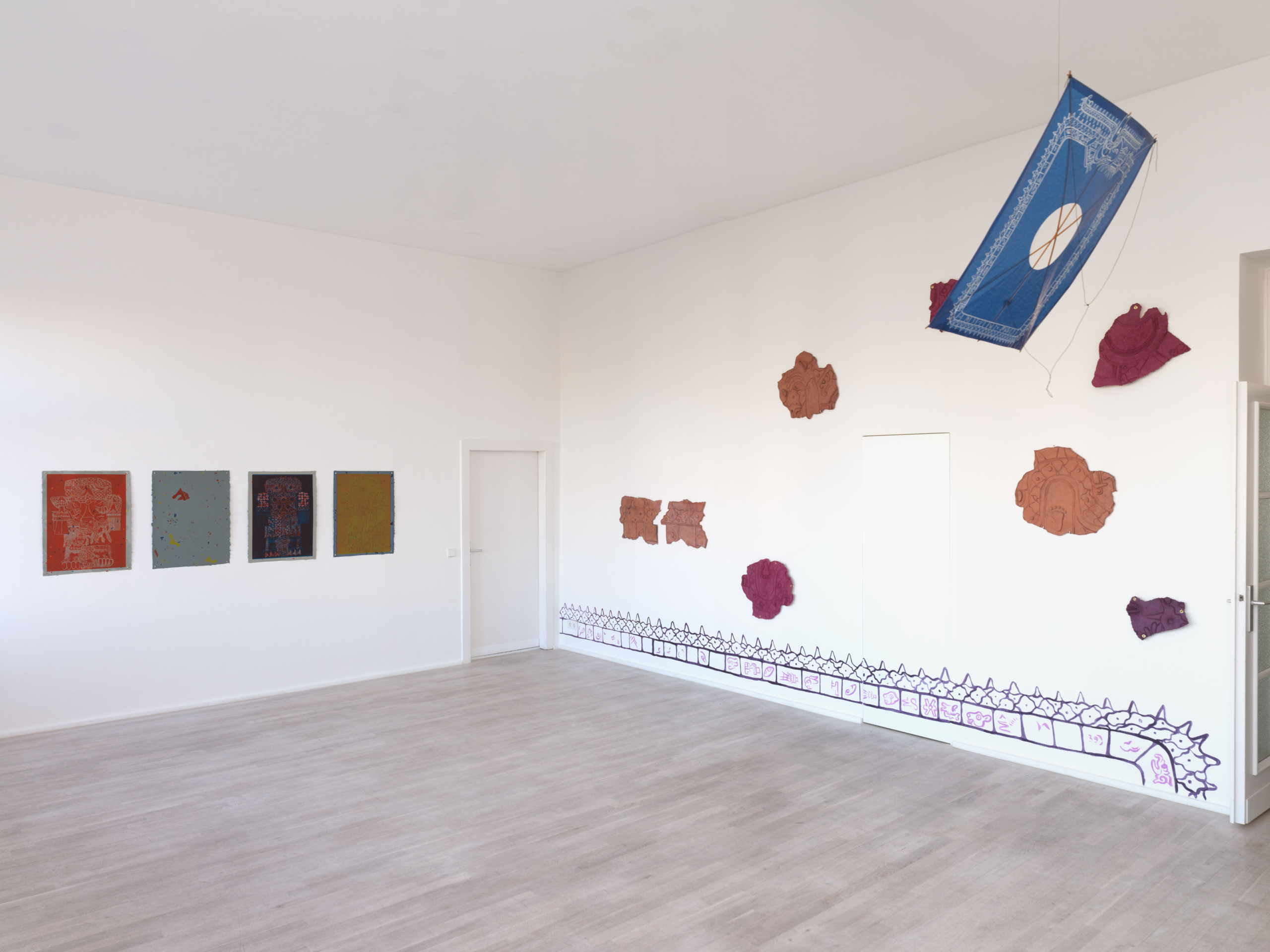
Installation view of Vùjá de – Paper Thresholds
Galerie Barbara Wien, Berlin, DE, November 30, 2024 – February 1, 2025
Photograph courtesy of Barbara Wien and Mariana Castillo Deball © NickAsh
A selection of prints, from the series She Bends to Catch a Feather of Herself as She Falls, is also on view in the north room. I originally developed these prints for the exhibition Ceremony (Burial of an Undead World) 2022 at HKW in Berlin and worked together with the paper producers Gangolf Ulbricht and Ulrich Kühle at Keystone Editions printing workshop in Berlin. It was a very interesting process comprising different steps in which I printed the motifs in blue, red and yellow, on three different papers developed by Gangolf Ulbricht. Once these prints were ready, I ripped them apart into small pieces and blended them into tiny particles. These crushed prints were added back into the paper pulp to make new sheets. Afterwards, I returned to Keystone Editions and we printed on top of the new paper sheets. The printed motif reworks shapes from a series of prints I did in 2010 titled Coatlicue #1–3. They refer to a monolithic statue of Coatlicue, the Aztec mother of the deities. This statue is believed to have been created a few decades before the Spanish invasion and is an important piece in the collection of Mexico City‘s National Museum of Anthropology. In She Bends to Catch a Feather of Herself as She Falls, Coatlicue appears as a fragmented yet majestic figure. The fractal appearance of a multiplied deity recalls her central and fertile position within the cosmological matrix of the Aztec belief system and social order.
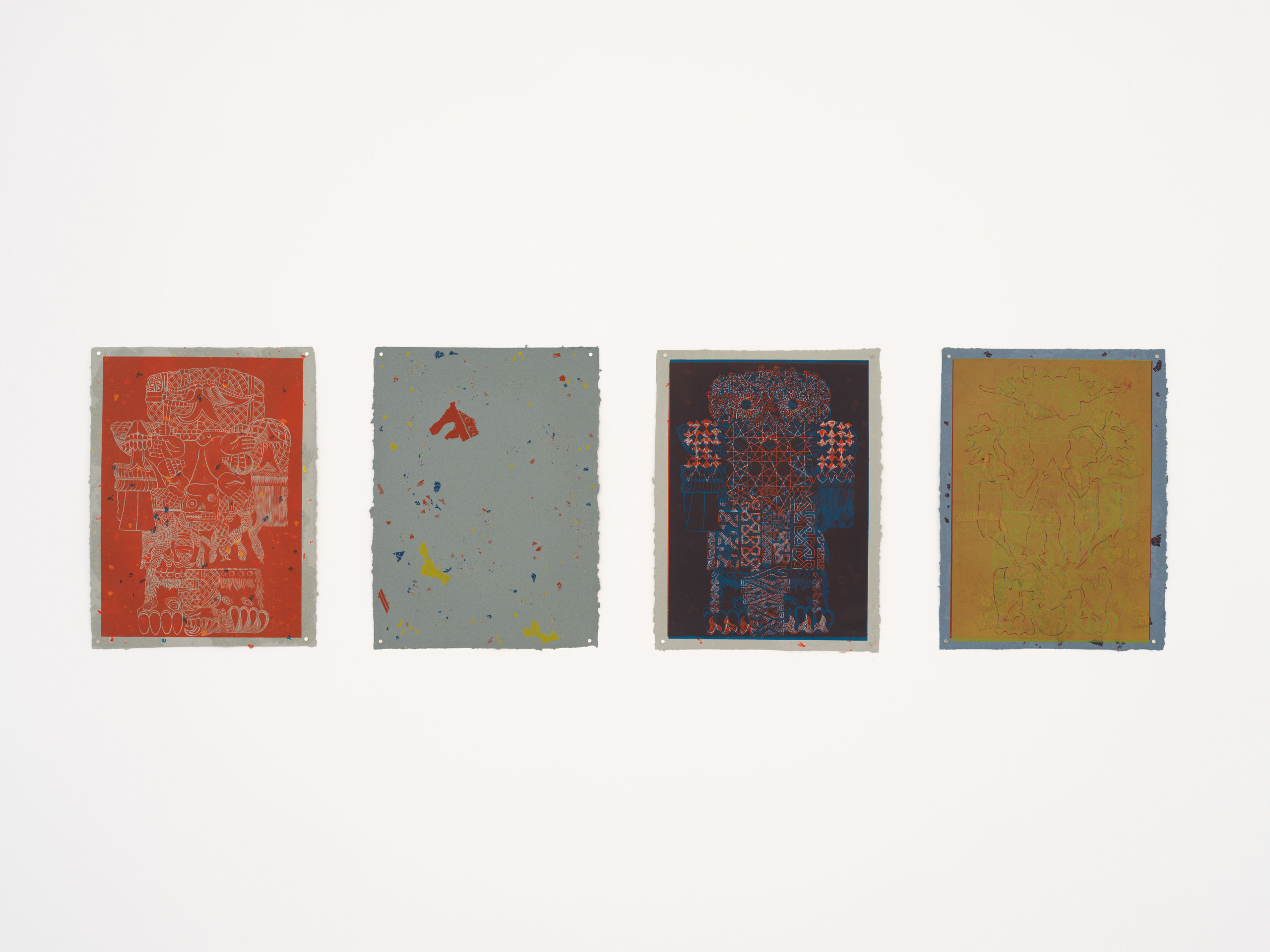
Installation view of Vùjá de – Paper Thresholds
Galerie Barbara Wien, Berlin, DE, November 30, 2024 – February 1, 2025
Photograph courtesy of Barbara Wien and Mariana Castillo Deball © NickAsh
Cada cosa es Babel
November 4, 2023 – February 10, 2024
Mendes Wood DM, Brussels, Belgium
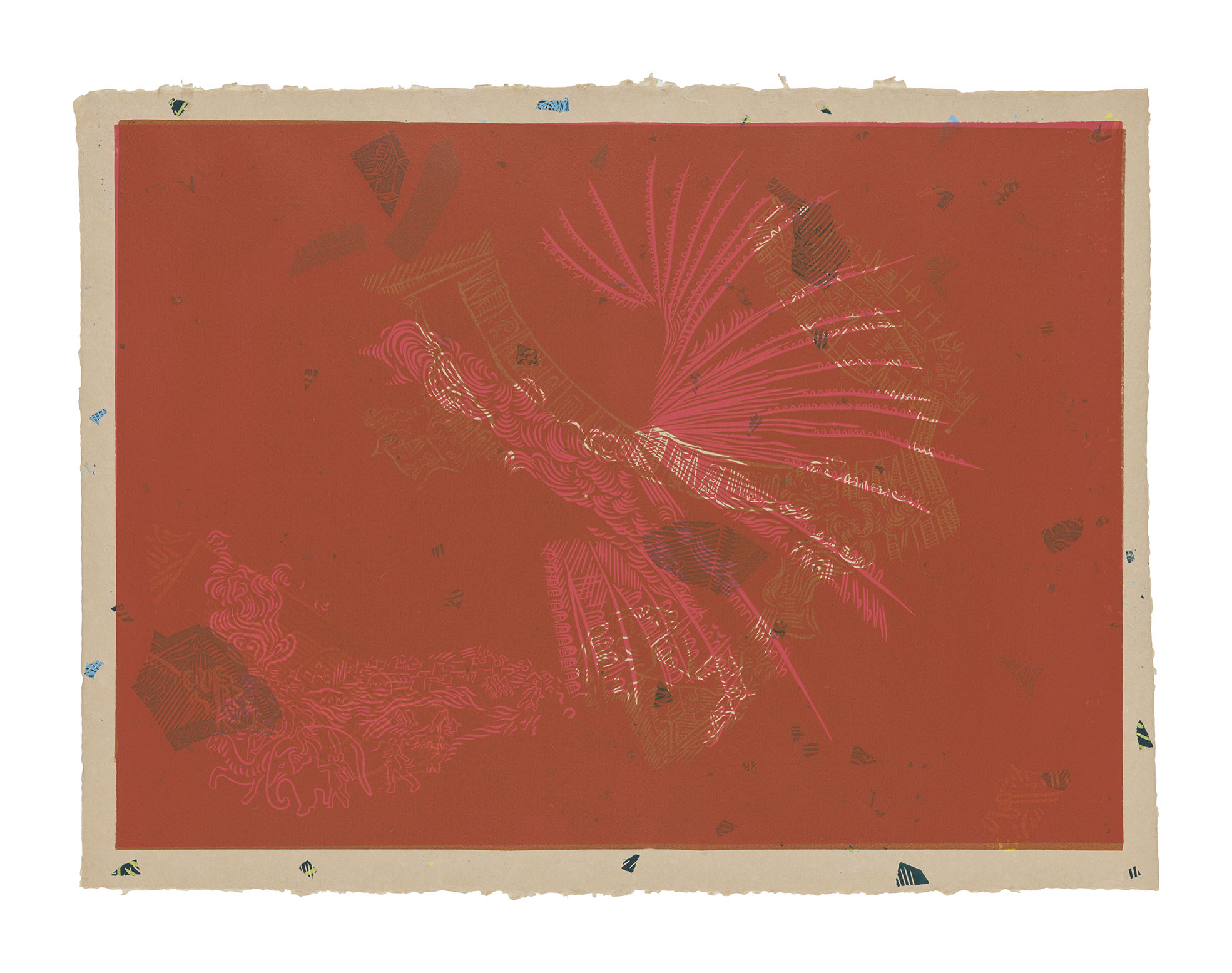
from the series Cada cosa es Babel 3, 2023
unique print on handmade paper 56.5 x 76.5 cm
“And what happens if we look the other way around, if we read contemporary art as future archaeology?”
— Mariana Castillo Deball
An object, eroded by time, crumbles in the palm of a hand. A tower collapses. A stonemason is hammering, chiseling stones. In her second solo exhibition at Mendes Wood Brussels, Cada cosa es Babel, Mariana Castillo Deball shows a selection of linocut prints on handmade paper, made in collaboration with paper producer Gangolf Ulbricht and printed at Keystone Editions, both in Berlin. For this series, the artist started by drawing deconstructed fragments of existing imagery of the tower of Babel – details from seventeenth-century engravings and the paintings of Pieter Bruegel the Elder, among others – and remixing these elements into new constellations that make up new layers of stories. As the title of the exhibition suggests: everything is Babel; everything tells a story and leaves a mark, even, or indeed precisely, where it fails and crumbles, leaving behind its origins.
“And it came to pass, as they journeyed from the east, that they found a plain in the land of Shinar; and they dwelt there. And they said one to another, Go to, let us make brick, and burn them thoroughly (…) And they said, Go to, let us build us a city and a tower, whose top may reach unto heaven; and let us make a name, lest we be scattered abroad upon the face of the whole earth” [11:2-4]. This marks the beginning of the story of Babel in the book of Genesis in the Christian Old Testament. The construction of the tower was cut short when god created a confusion of tongues – the multiplication of languages. Some scholars and historians have asked at which point this story begins to make sense to us as a story: in the plotlessness of a universal language, efficiently progressing towards a unified goal, or in its turn of plot, when people stop making sense to each other as they speak, suddenly, in different tongues?1 One interpretation of the story is that Babel has “made its name”, not in spite of the divine spell but because of it. The Hebrew name Babel (בבל) derives from the verb balal, which means to confuse or confound. The Arabic noun بَلْبَلة or balbala refers to disorder, confusion, and chaos.2 It may be the case that the English word babble has its origins in the word Babel, although it could also be an onomatopoeia for the sound that babies make before acquiring linguistic abilities. In either case, Babel, or babble, is what comes before and after a universal language that is set to unite people on earth with the divine knowledge of the heavens.
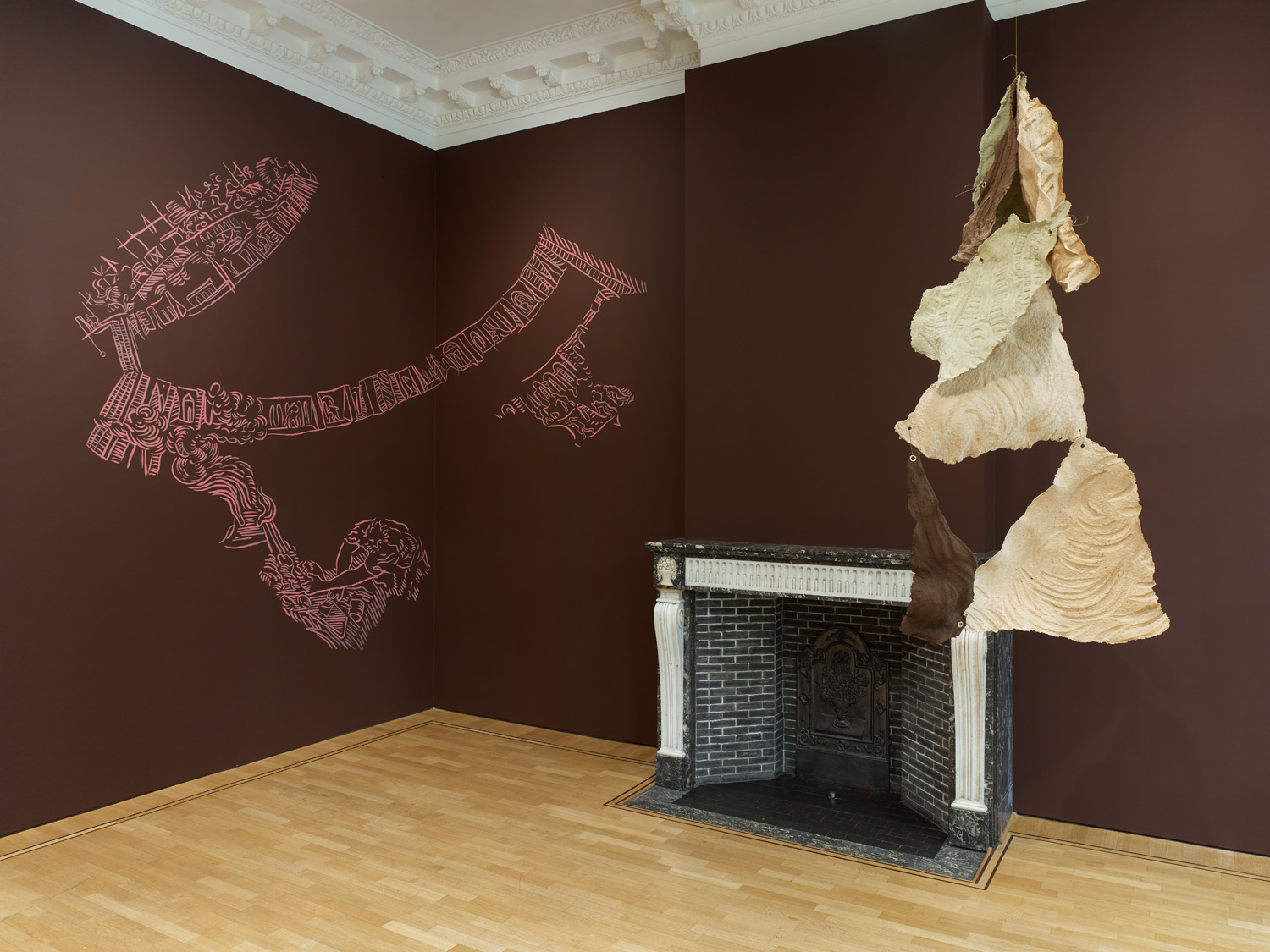
Exhibition view of: Cada cosa es Babel, Mendes Wood DM Brussel, Belgium, 2023
Photo: Kristien Daem
Jacques Derrida writes that “[t]he ‘tower of Babel’ does not merely figure the irreducible multiplicity of tongues; it exhibits an incompletion, the impossibility of finishing, of totalizing, of saturating, of completing something on the order of edification, architectural construction, system, and architectonics.”3 In a recent text in Ixiptla, a research journal edited by Mariana Castillo Deball, she writes that the forum of ancient Greek society is both a physical space and the people who gather in it.4 Something similar can be said about the tower of Babel. It is both architecture and the materialization of a monolithic language, or what such language strives to achieve: the utopian project of absolute (heavenly) knowledge, which is bound to fail. And Babel, as Derrida points out, is also the failure itself, which signifies the event in its trace. Babel in ruins. This failure is told through the scattering of people in different directions “upon the face of the whole earth”, and this scattering also finds its visual echo in the works shown in this exhibition.
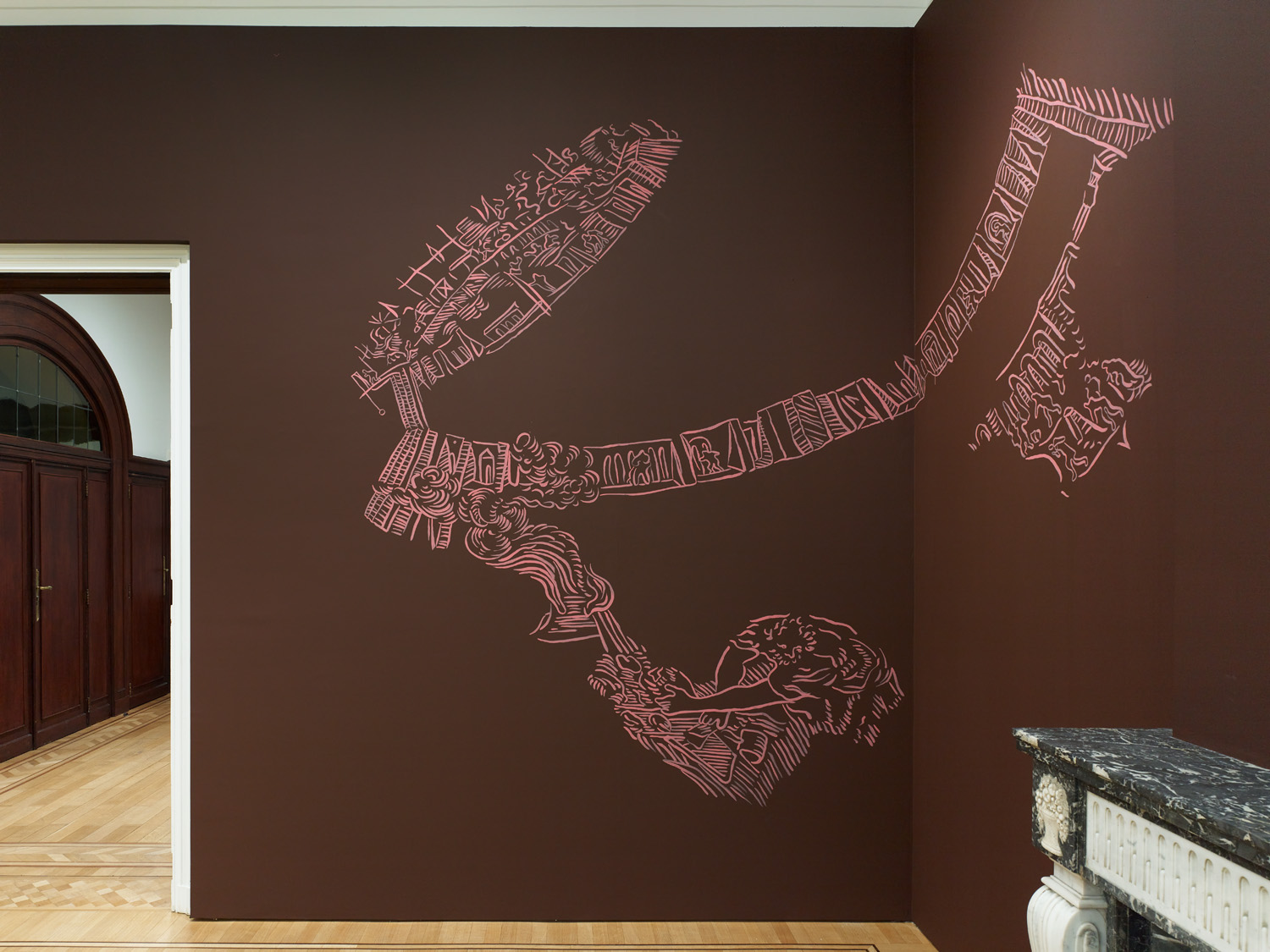
a story, a building, and a ruin, 2023
acrylic paint variable dimensions (MW.MCD.145)
Photo: Kristien Daemv
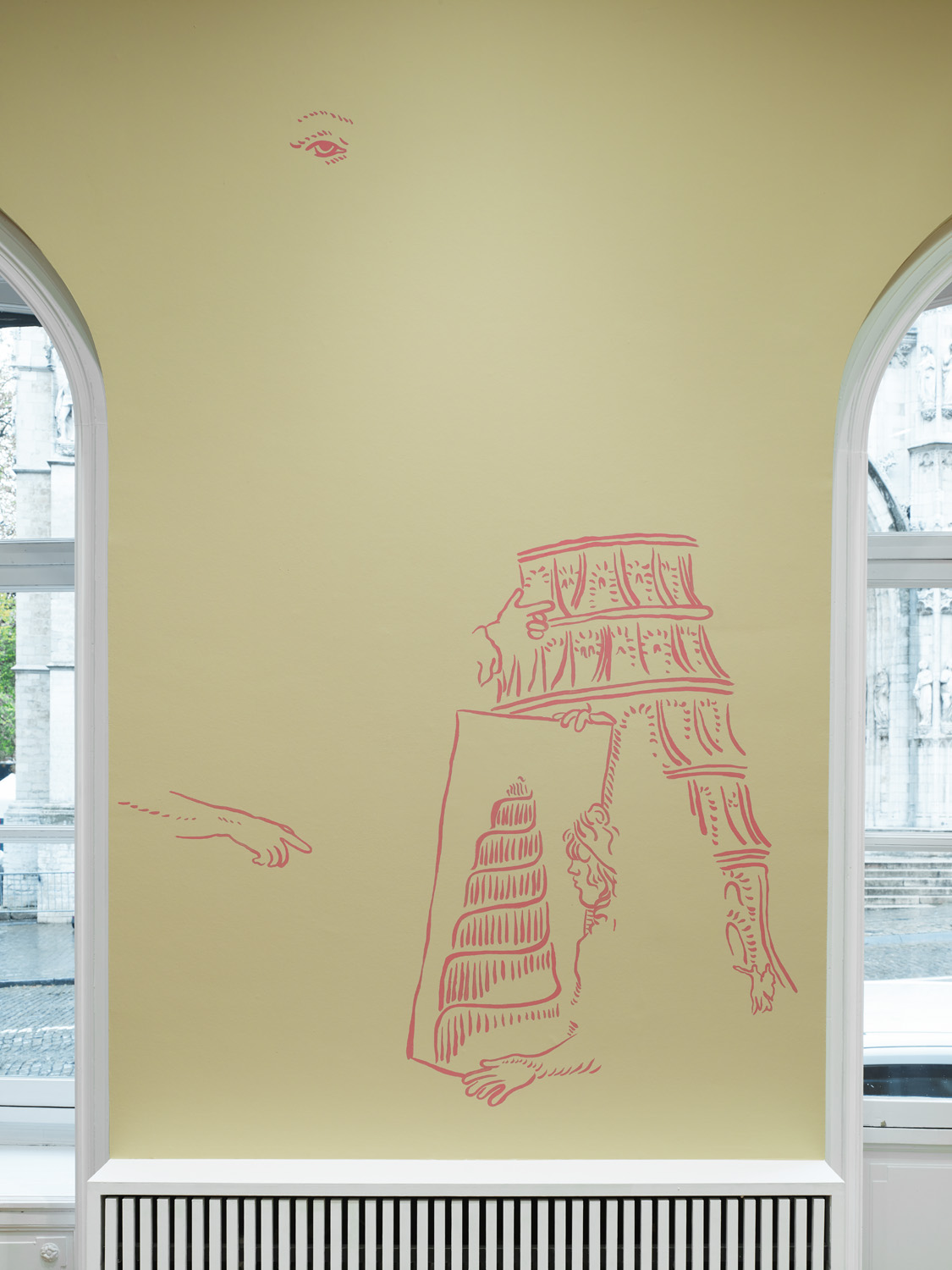
Future Archaeology, 2023
acrylic paint variable dimensions
Photo: Kristien Daem
The drawings by Mariana Castillo Deball show the tower in various stages of building and collapse. In one drawing, a woman is holding the design of the tower, while another portrays a community of builders having set up camp in the vicinity of the tower that is under construction. Another drawing shows Babel in ruins. Deball includes other pictorial elements, such as ethnographic objects from the Museu Nacional in Rio de Janeiro, Brazil, including clay figurines made by the Karajá Indigenous people from Central Brazil, as well as petecas (old shuttlecock-like objects made from straw and feathers for a game similar to present-day badminton).5 These motifs, which have trickled in from other projects the artist worked on simultaneously – just like Babel, as a story, a building, and a ruin – are of ongoing interest to her.
Having transformed these drawings into linocuts, Castillo Deball printed them on paper made by Gangolf Ulbricht, a collaborator with whom she has worked before. From these prints, which she destroyed and tore into snippets of different sizes, she created new sheets of paper in three different colors: grapefruit pink, pistachio green, and chocolate brown. These 56 x 76 cm paper sheets are reminiscent of an archaeological excavation site, with shards of pottery captured in the soil, frozen in time. While some of these papers are kept in this state, others serve as surface and background for a new round of prints, so that the linocut drawings begin to repeat themselves through different layers.
A story progresses through its twists of plot and the passage of time. This also reflects how our relationship with things, human-made things, intensifies over time. Multiple readings are possible as the object is perceived through different eyes; it no longer speaks for itself. More than presenting a single image that emerges from a process, the works featured in this exhibition reveal the ongoing process of the artist at work, the practice of telling through matter and time – story upon story in an ongoing construction aspiring towards perfection but leaving behind fragments in its wake.
— Moosje M Goosen
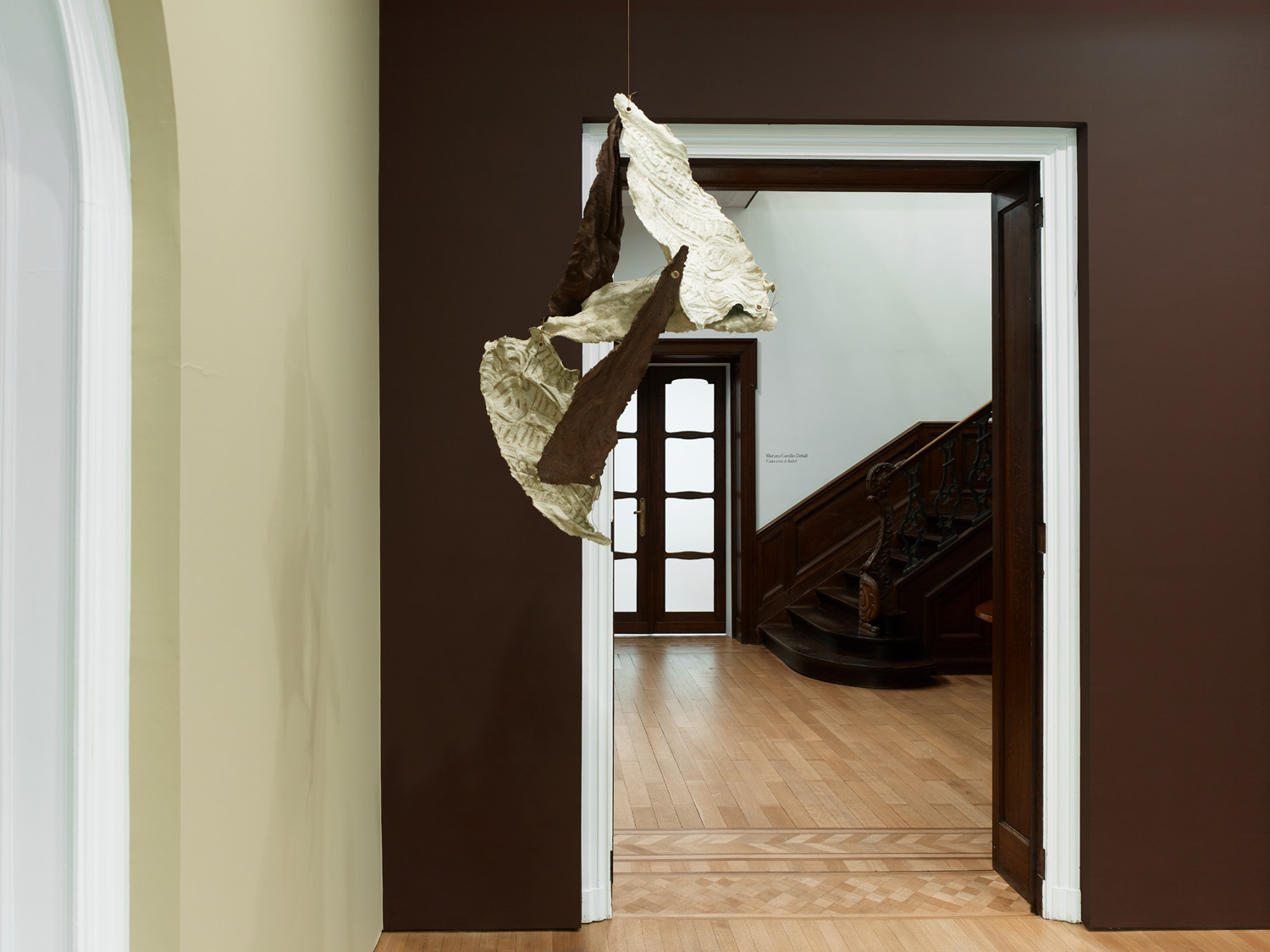
Exhibition view of: Cada cosa es Babel, Mendes Wood DM Brussel, Belgium, 2023
Photo: Kristien Daem
Sculpture: balal, aluminum wire, lino print on hand-made paper , 110 x 76 x 50 cm (approx.)
[1] See for instance: Jean Benet, The Construction of the Tower of Babel. Translated by Adrian Nathan West. Wakefield Press, 2017.
2 For more information about the reception of the Babel myth in Arabic cultures and language, see: Abdelfatah Kilito, The Tongue of Adam. Translated by Robyn Creswell. New Directions, New York: 2016.
3 In: Jacques Derrida, Des Tours de Babel, translated by Joseph F. Graham. In: Graham ed., Difference in Translation. Cornell University Press, 1985.
4 Mariana Castillo Deball, About the Book’s Grid in: Ixiptla, Spring 2023, Vol. V, Amarantus. Bom Dia Boa Tarde Boa Noite, Berlin 2023. pp.7-19.
5 On September 2, 2018, there was a fire at the Museu Nacional in Rio de Janeiro which burned down its entire collection. This is the subject of Castillo Deball’s exhibition at Pivô in São Paulo, A Noite, which opened in September 2023, on the same date as the fire.
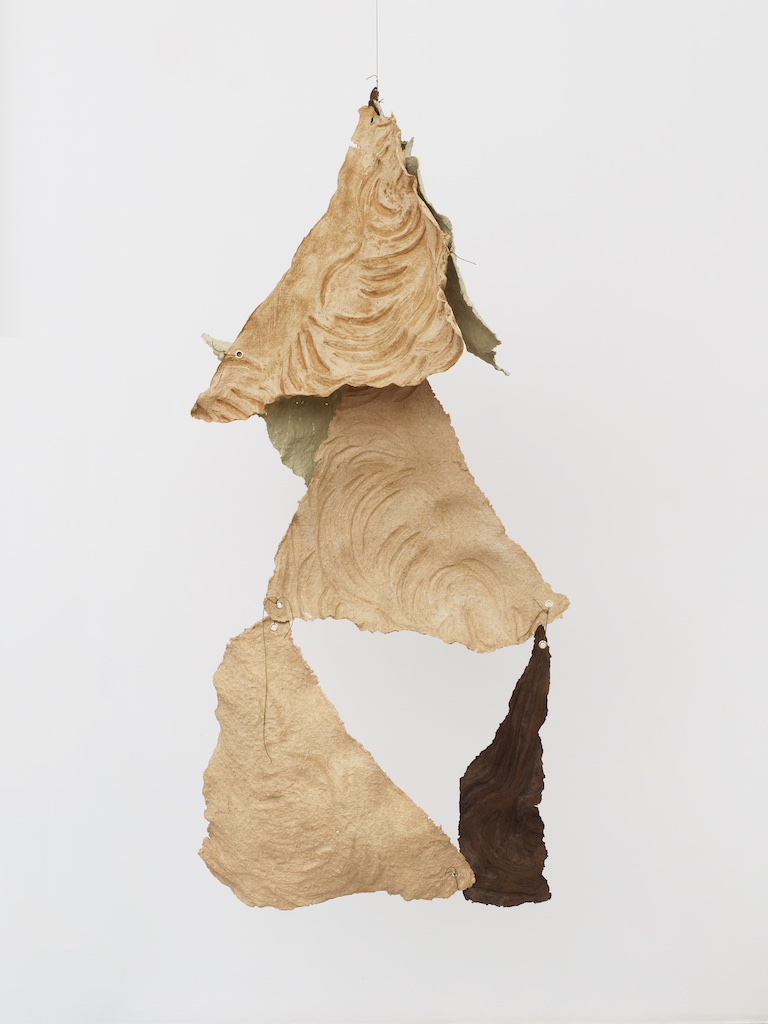
balbala, 2023
moulded papier-mâché, hemp thread and metal rings 175 x 75 x 60 cm (approx.)
Photo: Kristien Daem
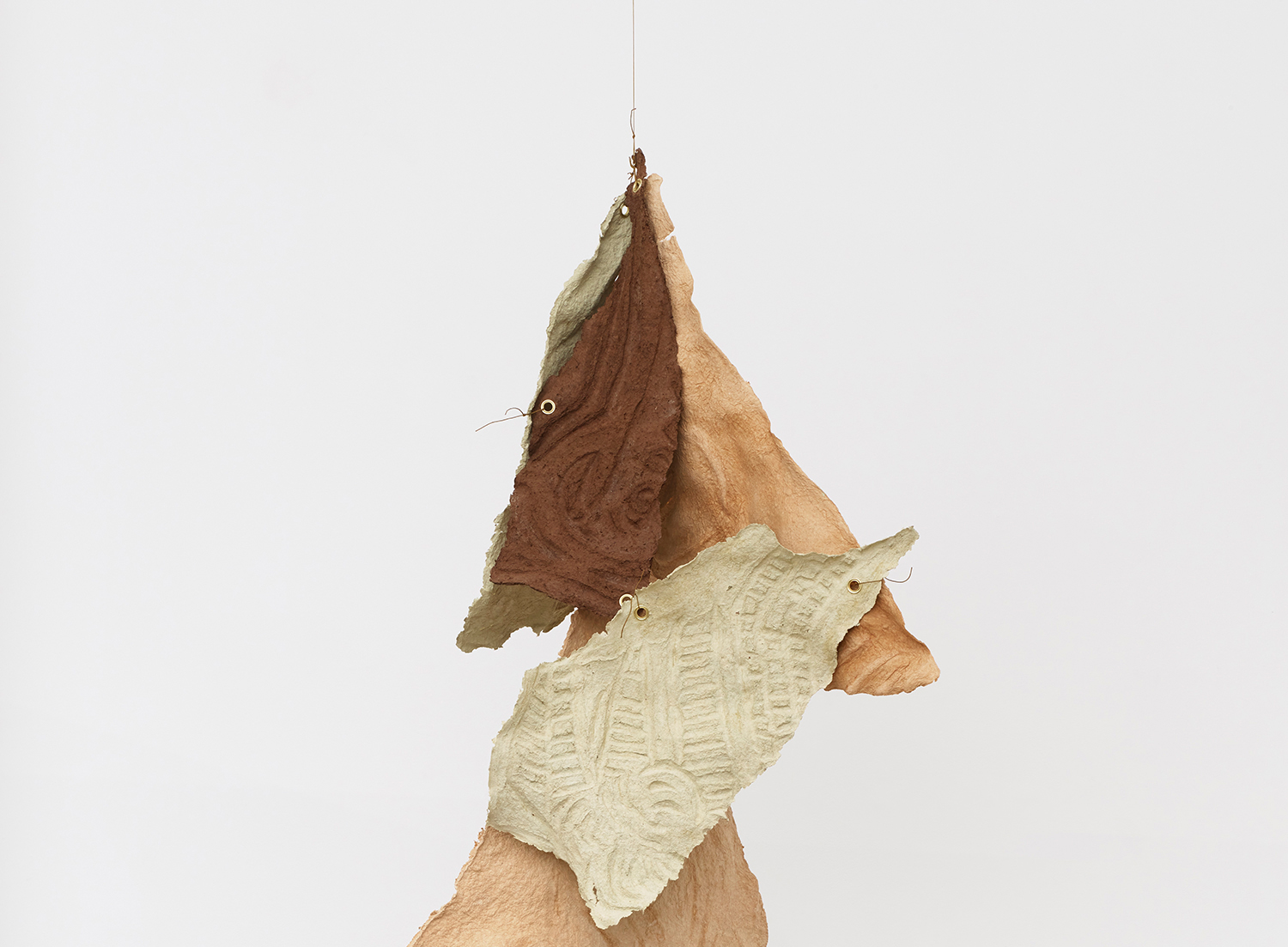
balbala, 2023
moulded papier-mâché, hemp thread and metal rings 175 x 75 x 60 cm (approx.)
Photo: Kristien Daem
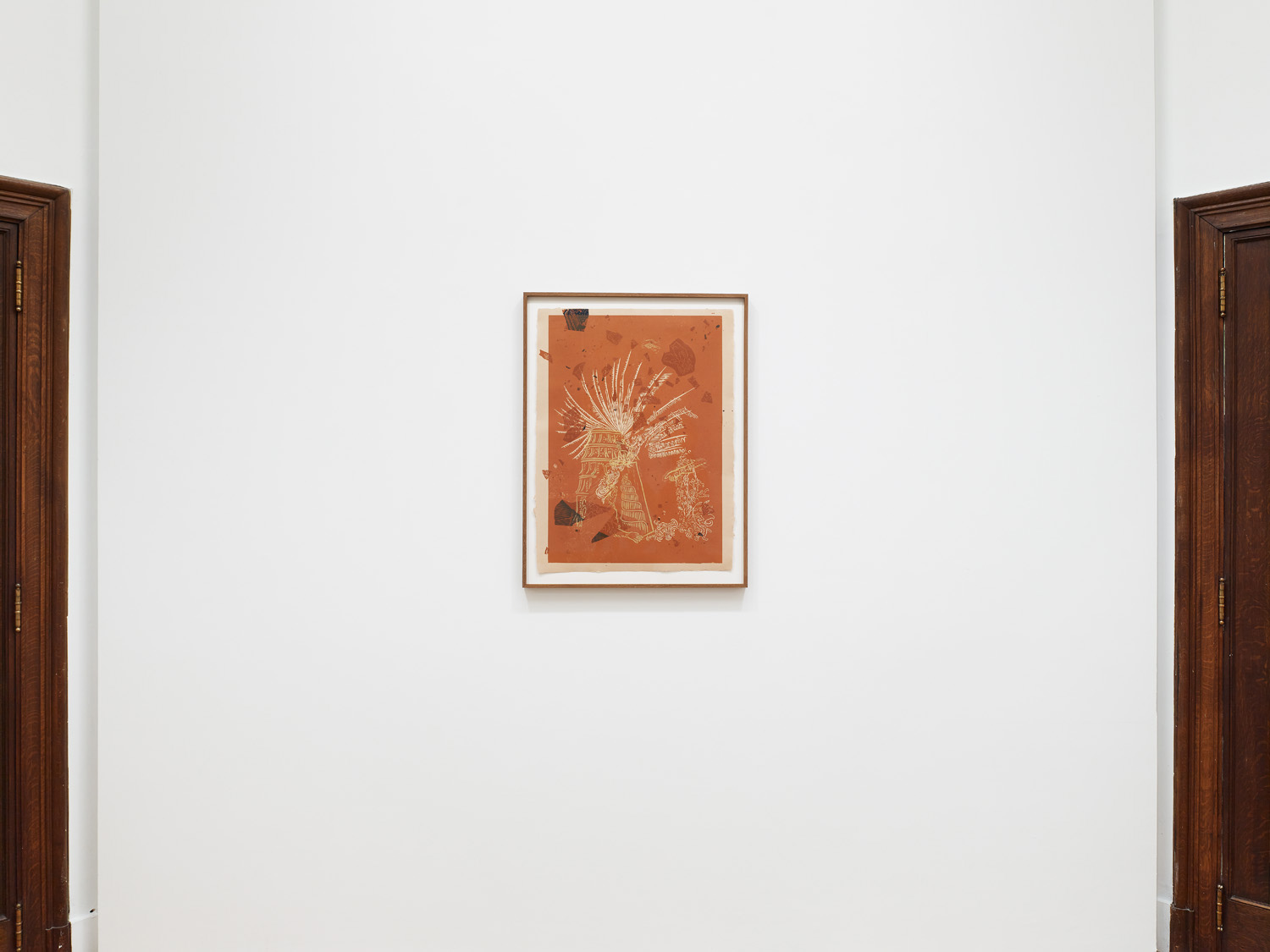
Exhibition view of: Cada cosa es Babel, Mendes Wood DM Brussel, Belgium, 2023
Photo: Kristien Daem
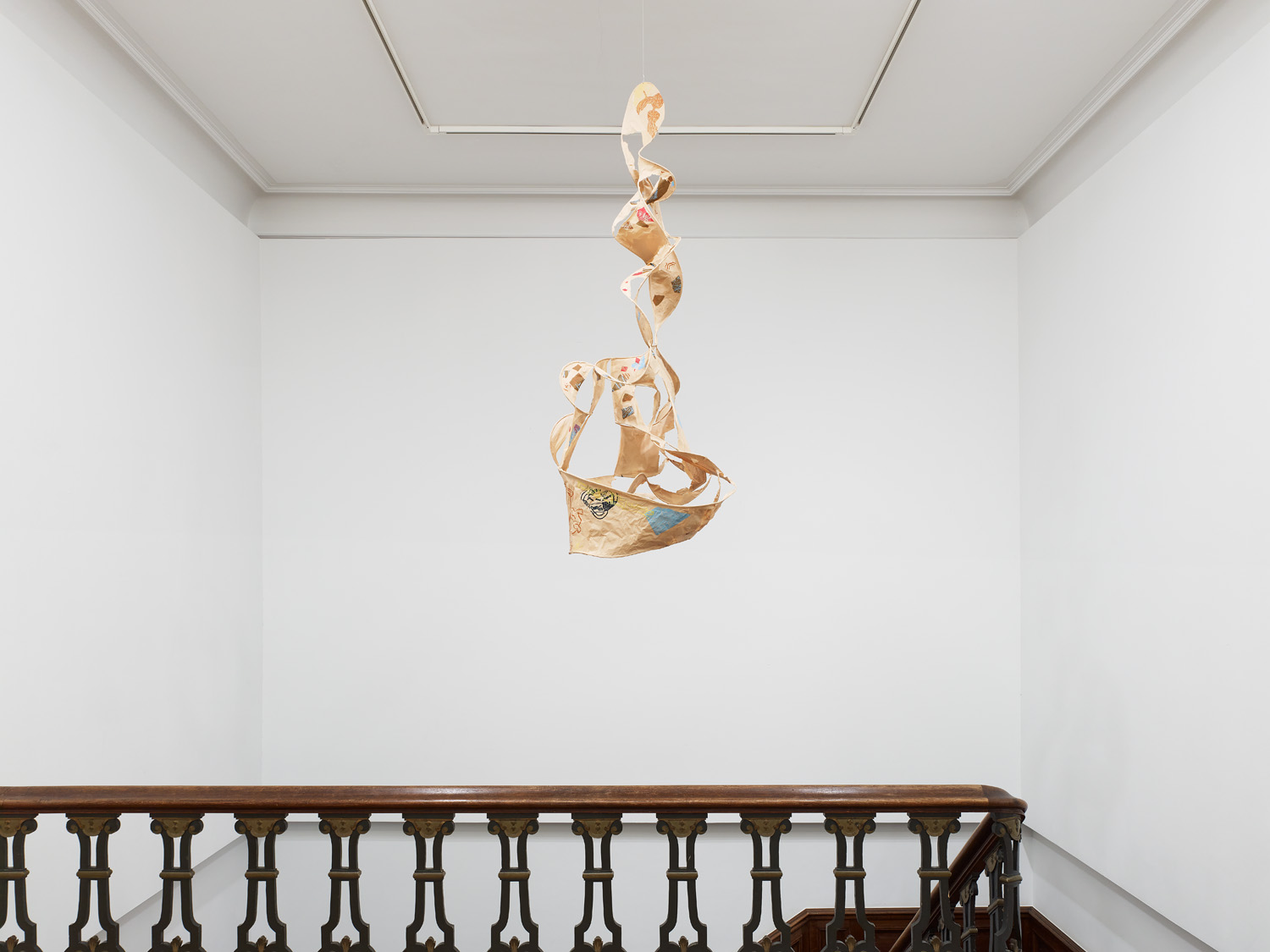
Exhibition view of: Cada cosa es Babel, Mendes Wood DM Brussel, Belgium, 2023
Photo: Kristien Daem
Sculpture: Paper Babel, aluminum wire, lino print on hand-made paper , 170 x 75 x 60 cm (approx.)
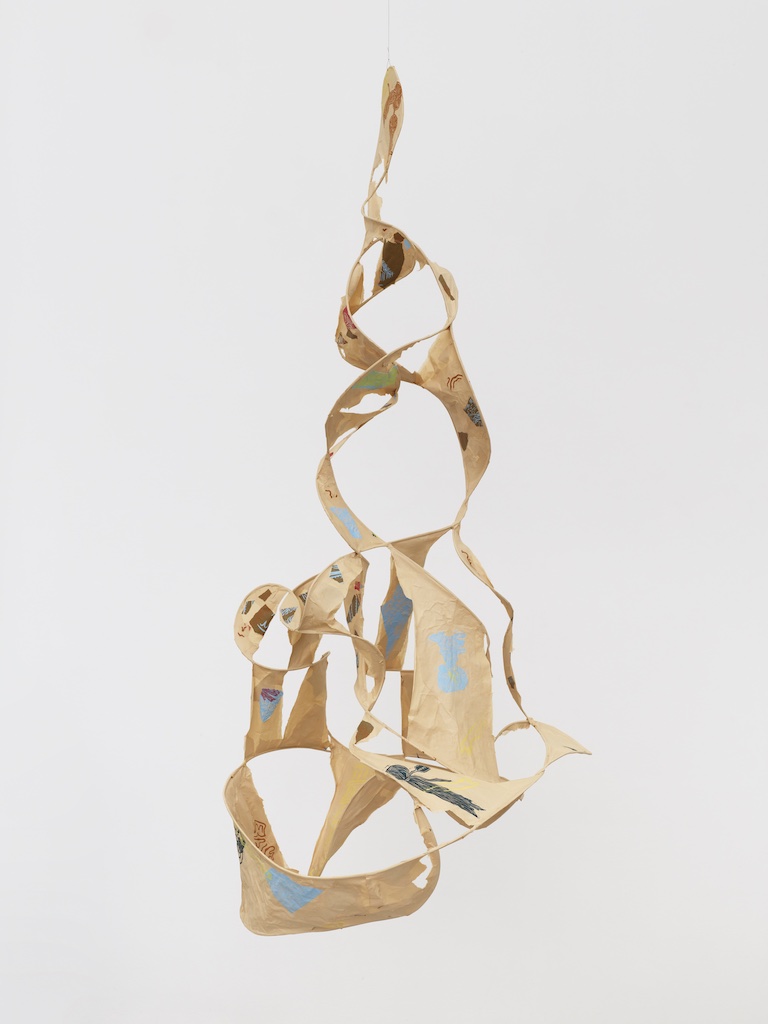
Paper Babel, 2023
aluminum wire, lino print on hand-made paper, 170 x 75 x 60 cm (approx.)
Photo: Kristien Daem
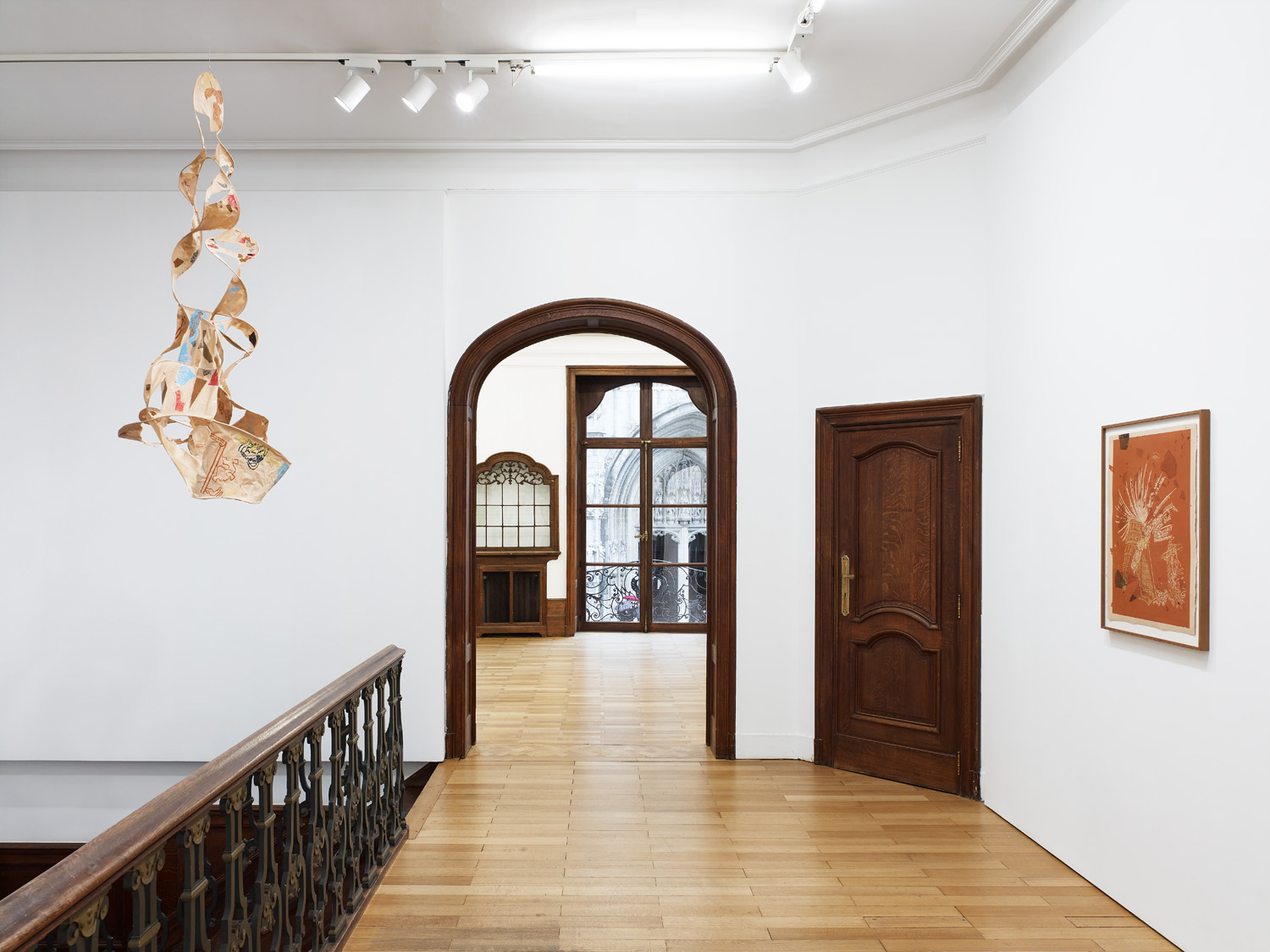
Exhibition view of: Cada cosa es Babel, Mendes Wood DM Brussel, Belgium, 2023
Photo: Kristien Daem
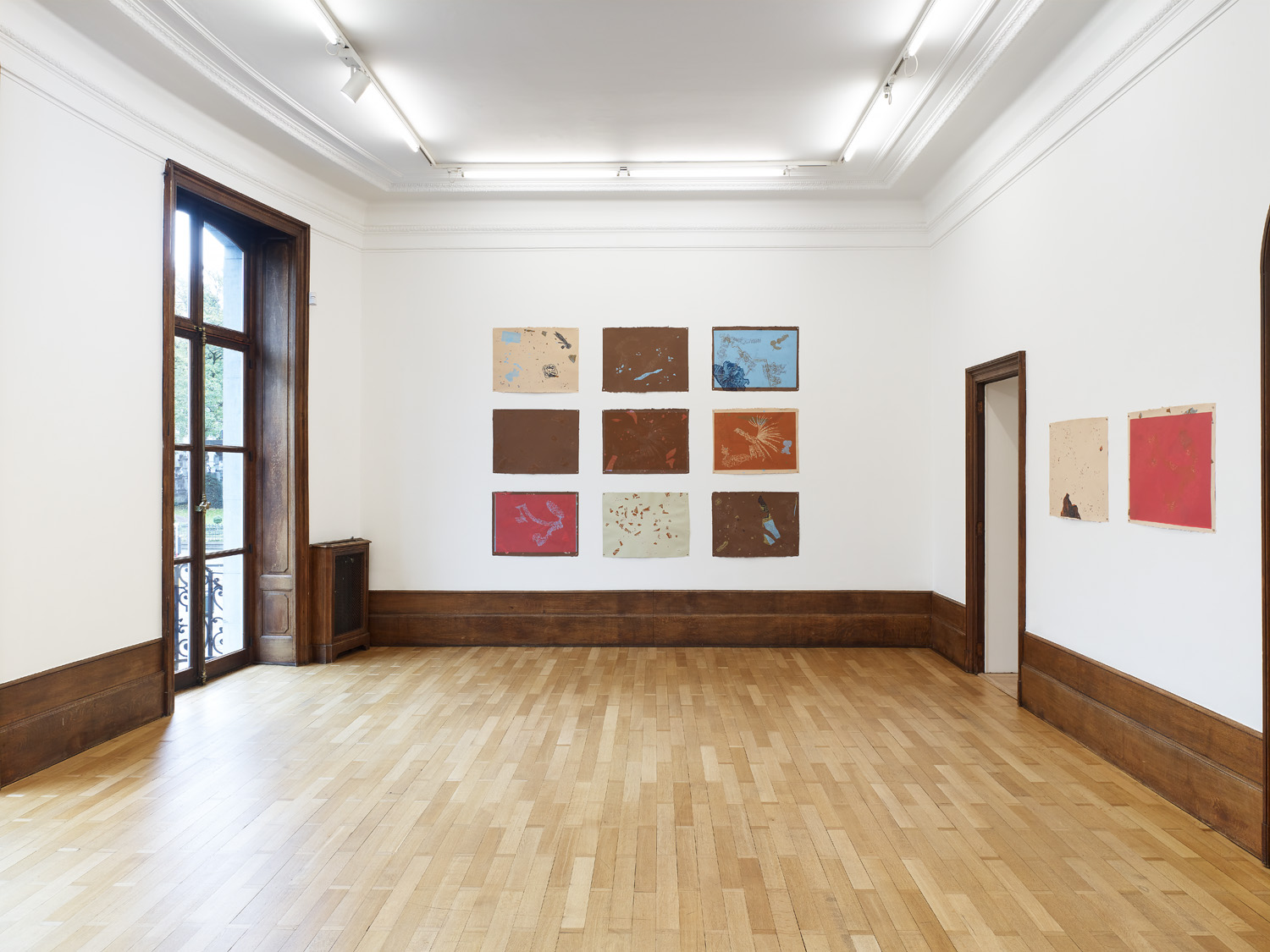
Exhibition view of: Cada cosa es Babel, Mendes Wood DM Brussel, Belgium, 2023
Photo: Kristien Daem
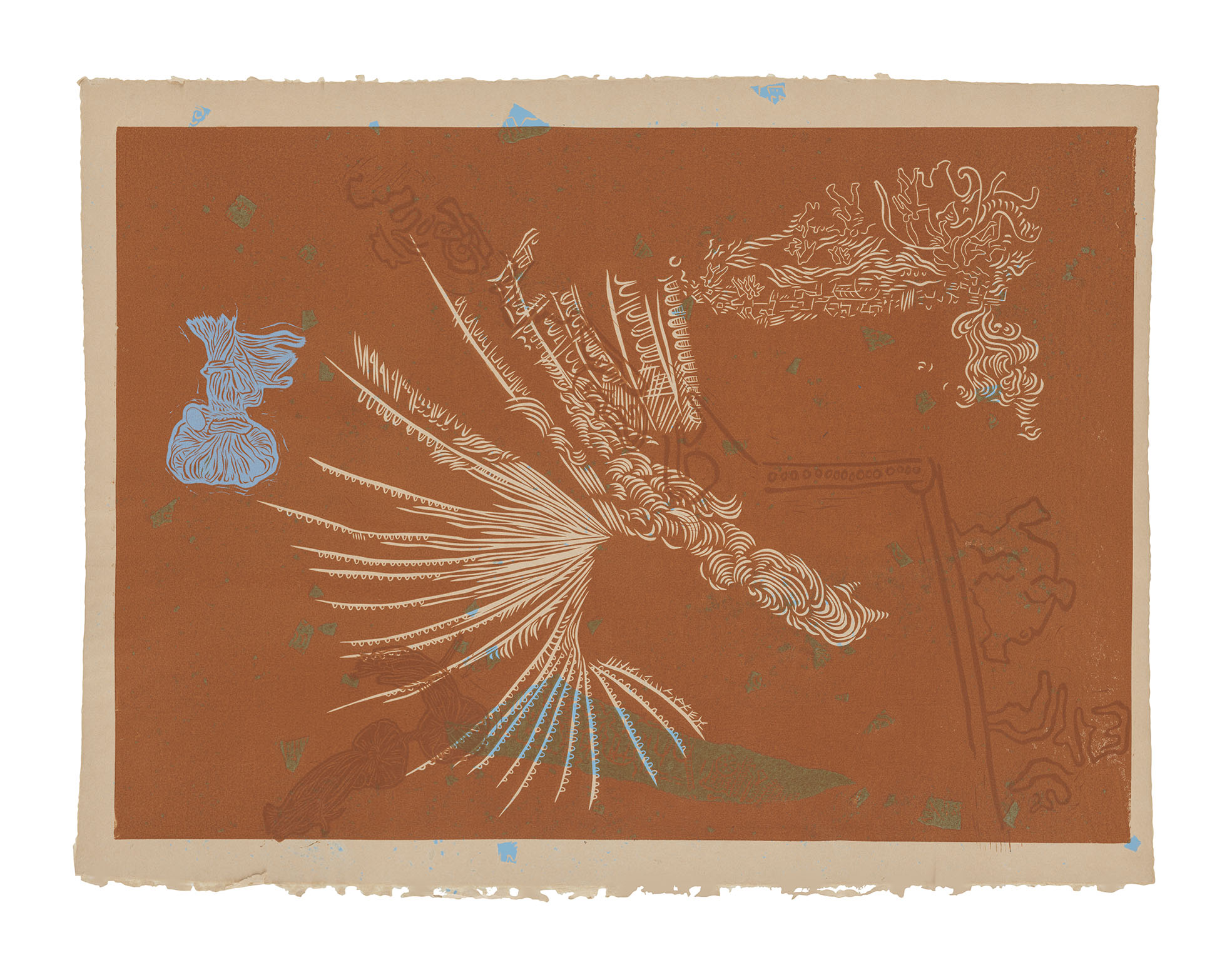
from the series Cada cosa es Babel 9, 2023
signed and dated
unique print on handmade paper 56.5 x 76.5 cm
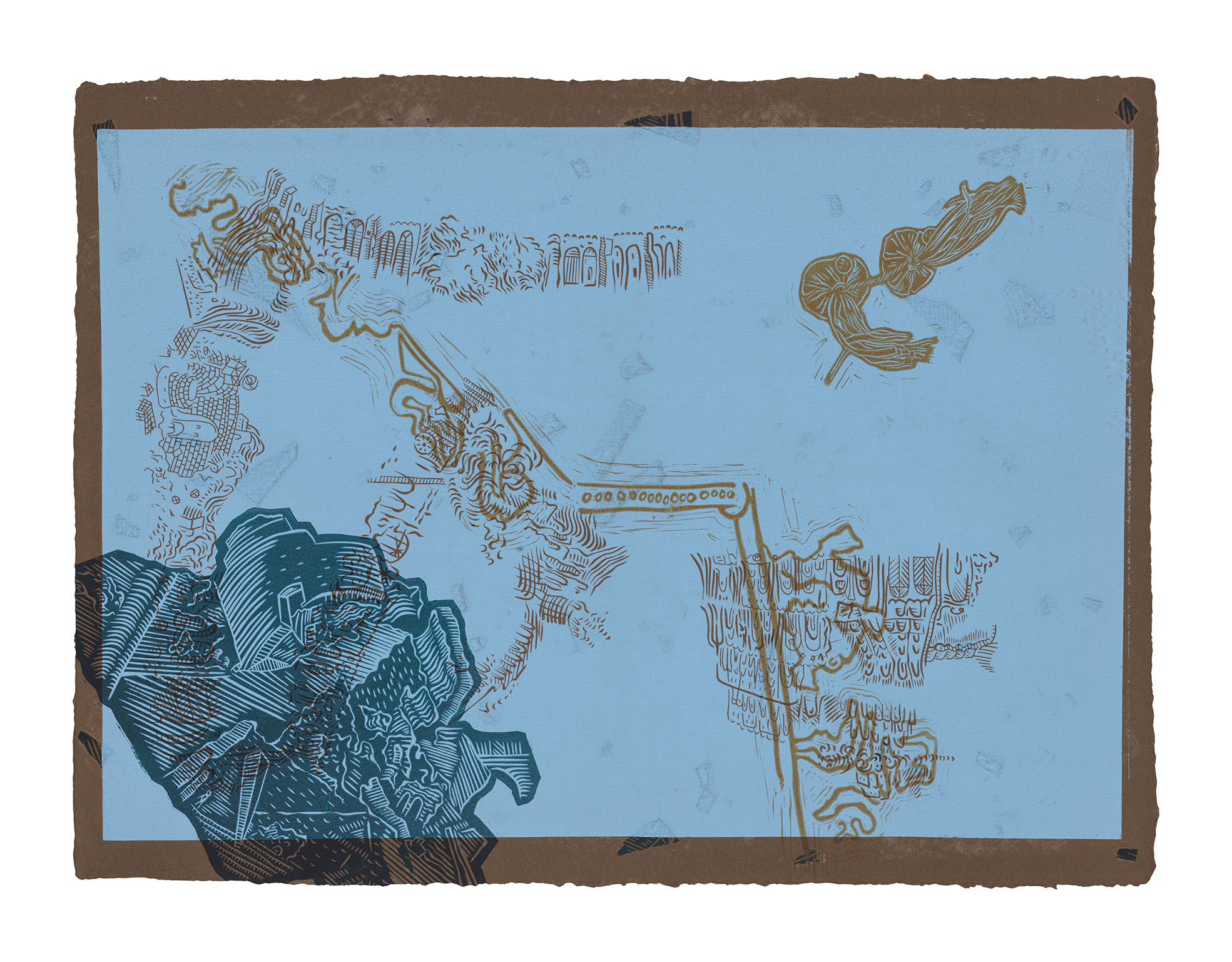
from the series Cada cosa es Babel 4, 2023
signed and dated
unique print on handmade paper 56.5 x 76.5 cm
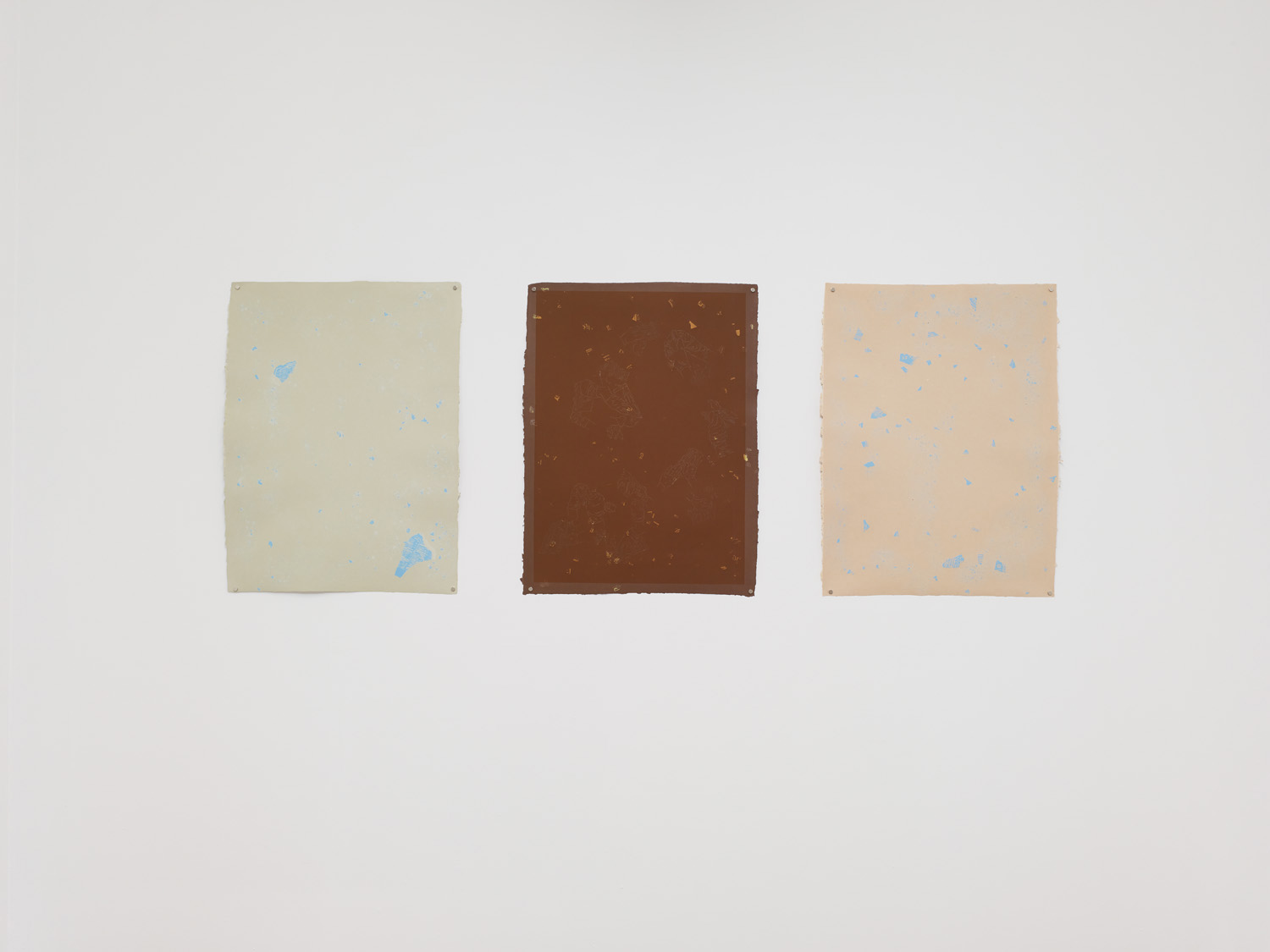
Exhibition view of: Cada cosa es Babel, Mendes Wood DM Brussel, Belgium, 2023
Photo: Kristien Daem
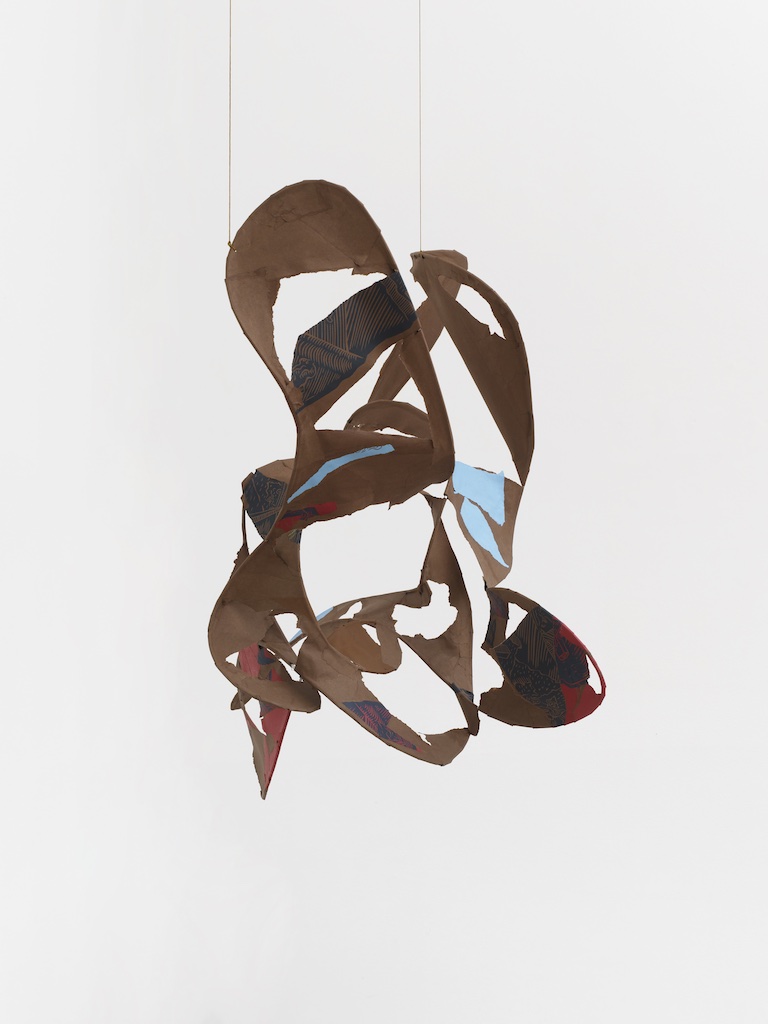
babble, 2023
aluminum wire, lino print on hand-made paper, 75 x 80 x 60 cm (approx.)
Photo: Kristien Daem
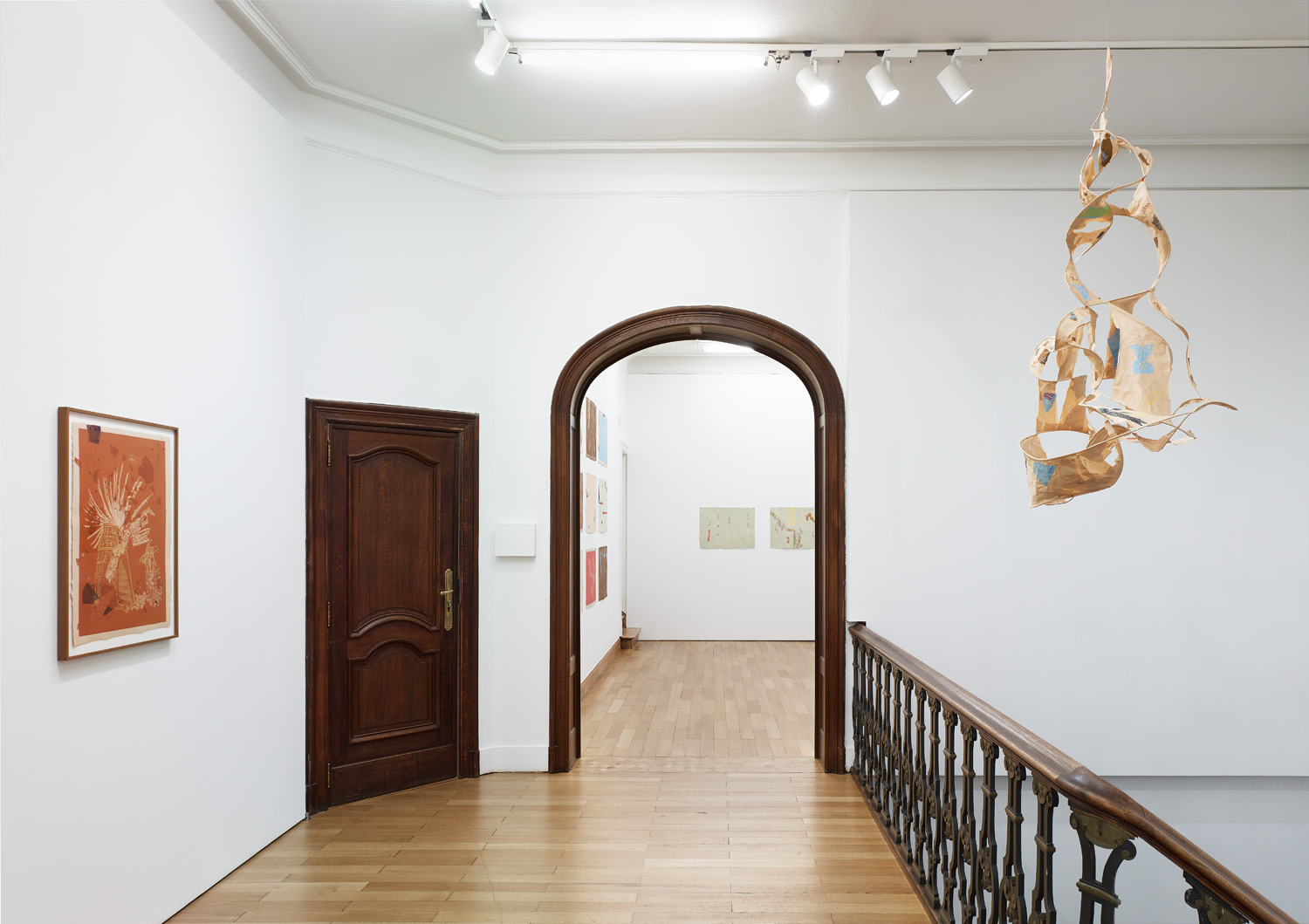
Exhibition view of: Cada cosa es Babel, Mendes Wood DM Brussel, Belgium, 2023
Photo: Kristien Daem
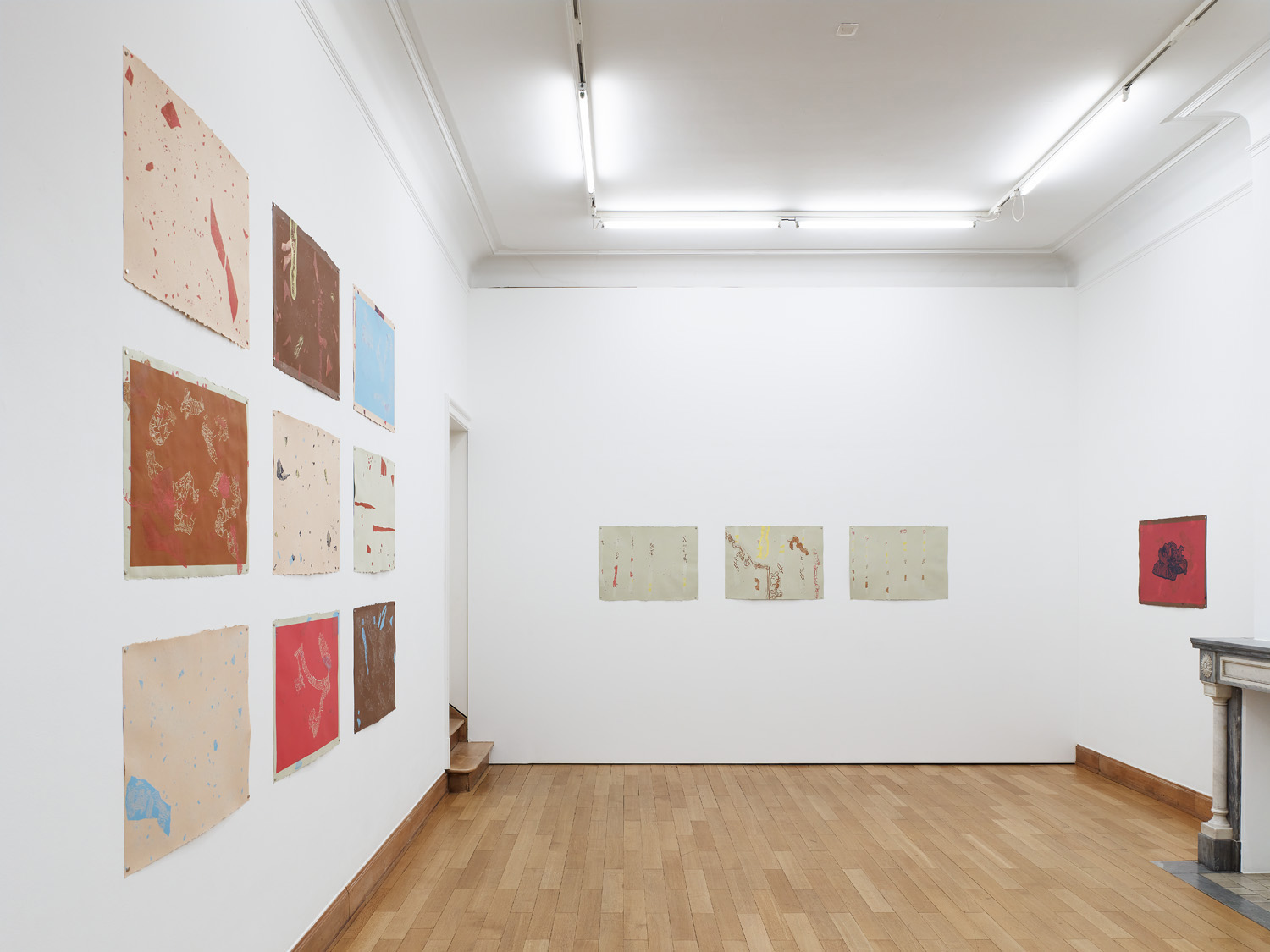
Exhibition view of: Cada cosa es Babel, Mendes Wood DM Brussel, Belgium, 2023
Photo: Kristien Daem
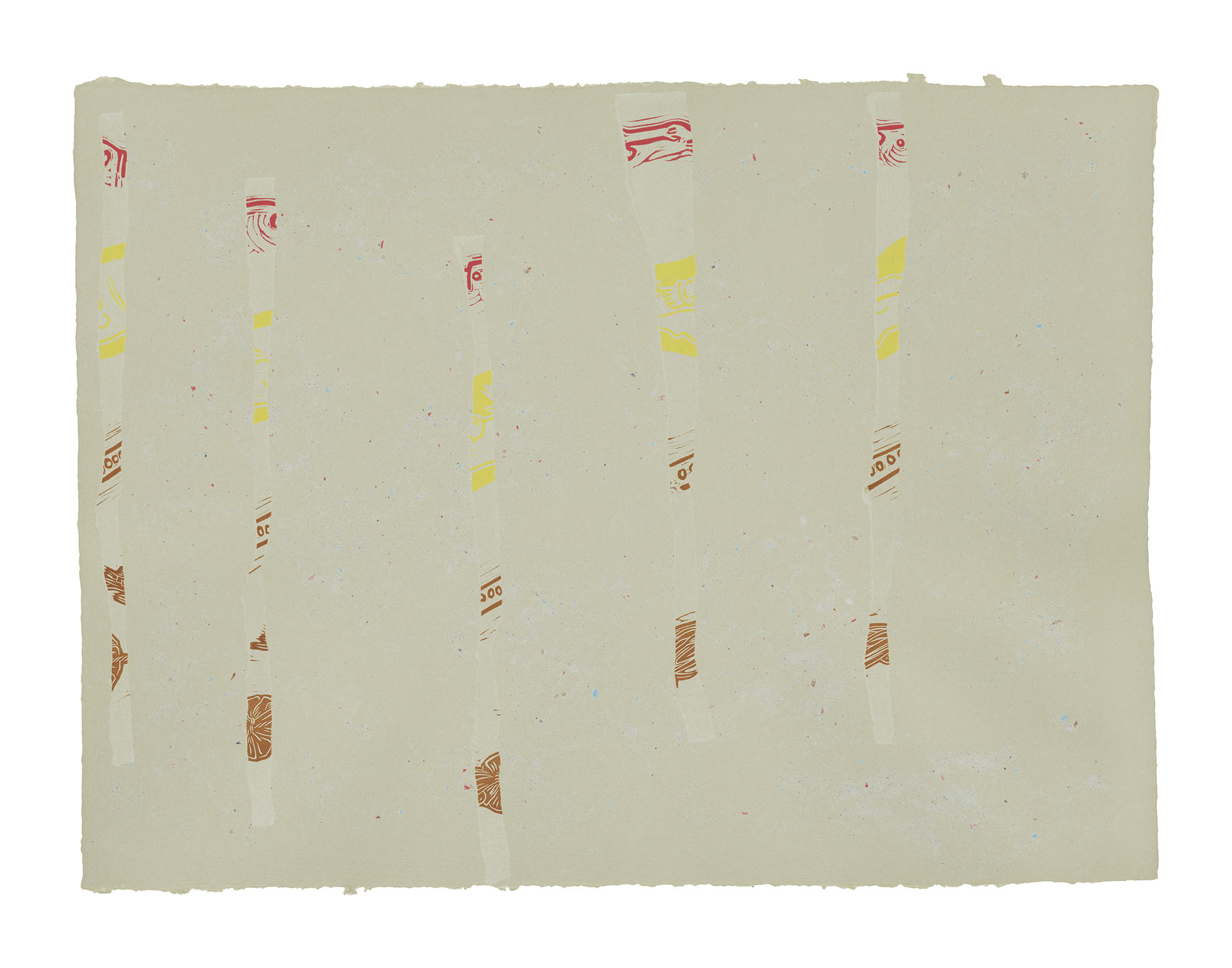
from the series Cada cosa es Babel 35, 2023
signed and dated
unique print on handmade paper 56.5 x 76.5 cm
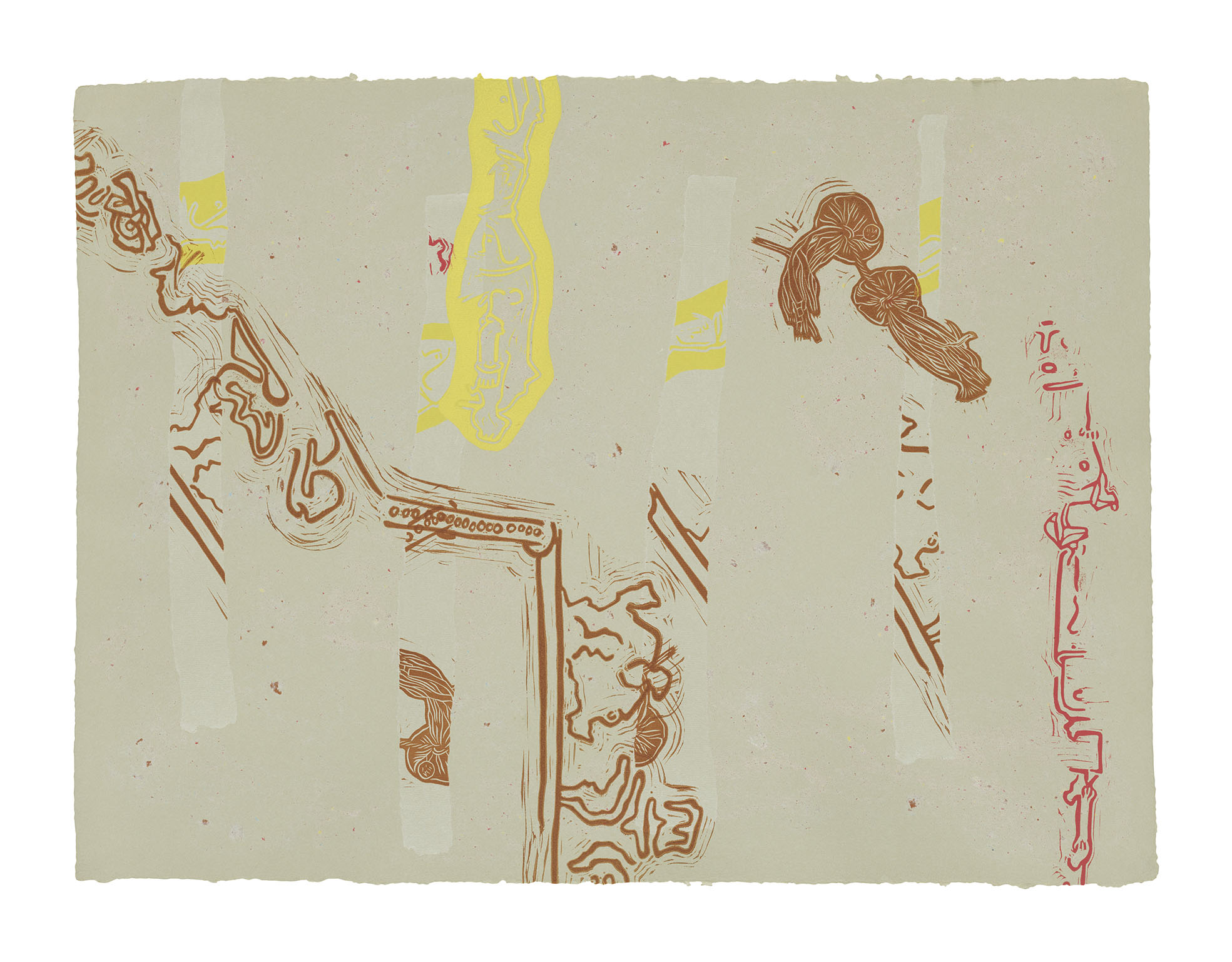
from the series Cada cosa es Babel 14, 2023
signed and dated
unique print on handmade paper 56.5 x 76.5 cm
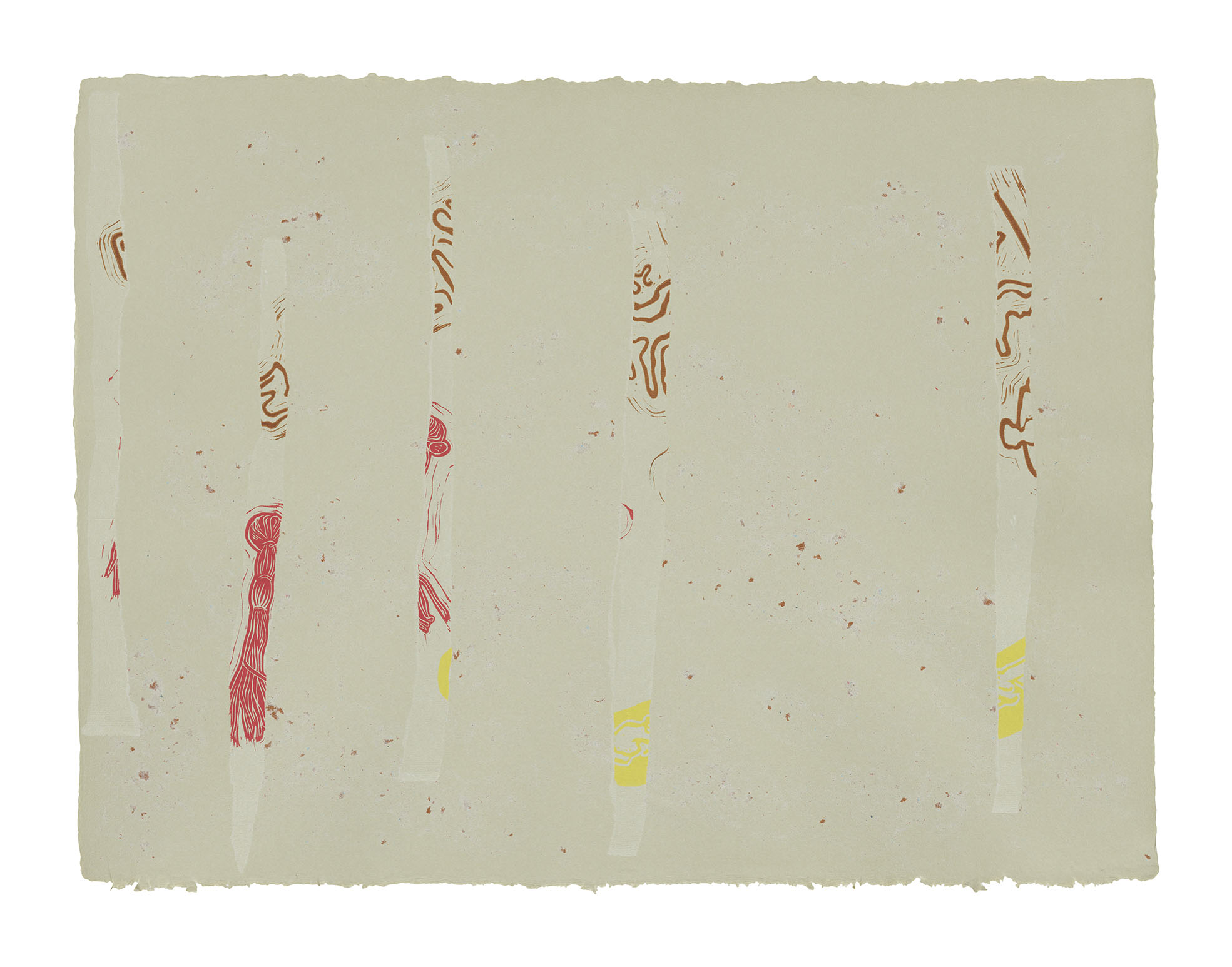
from the series Cada cosa es Babel 34, 2023
signed and dated
unique print on handmade paper 56.5 x 76.5 cm
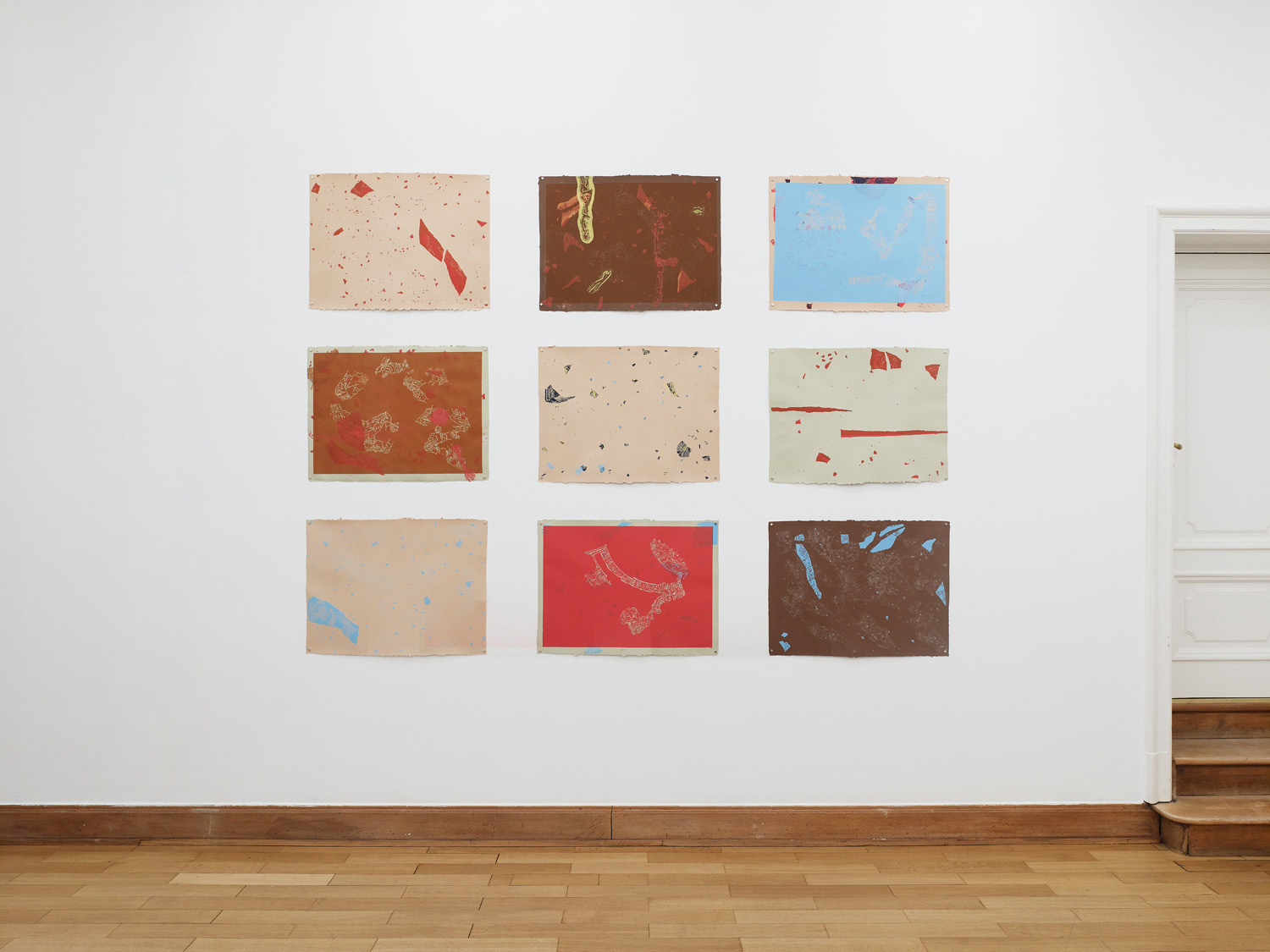
Exhibition view of: Cada cosa es Babel, Mendes Wood DM Brussel, Belgium, 2023
Photo: Kristien Daem
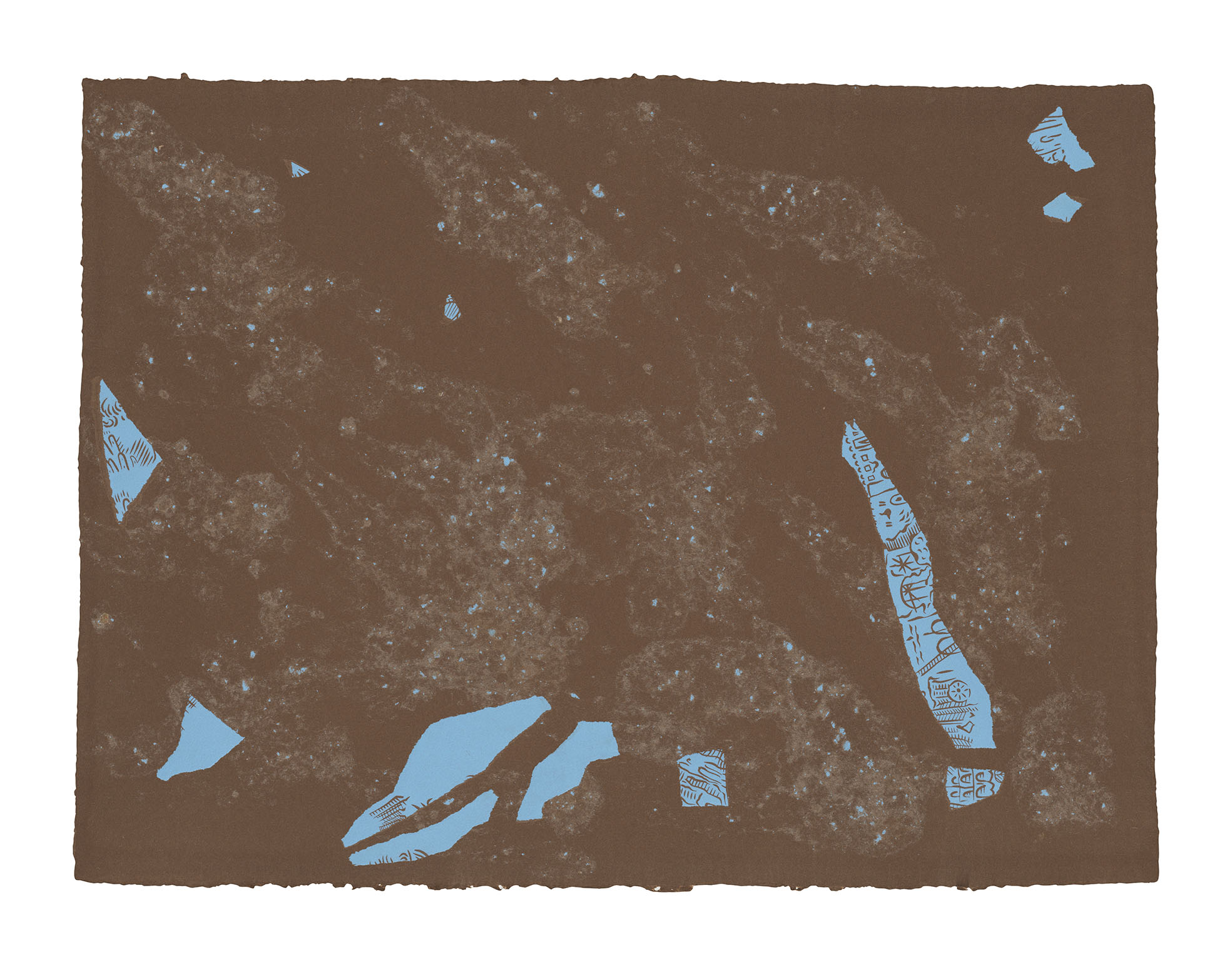
from the series Cada cosa es Babel 45, 2023
signed and dated
unique print on handmade paper 56.5 x 76.5 cm
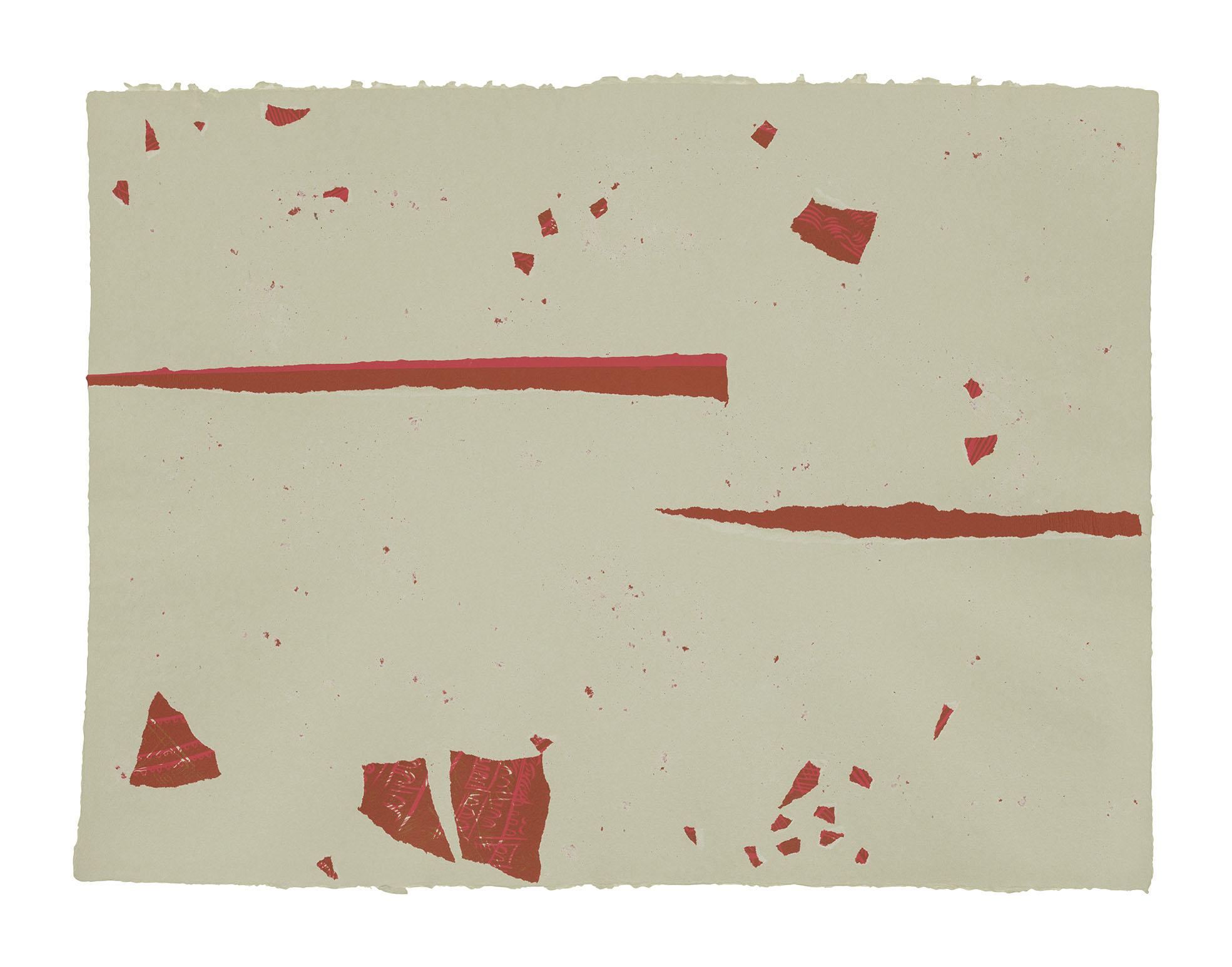
from the series Cada cosa es Babel 33, 2023
signed and dated
unique print on handmade paper 56.5 x 76.5 cm
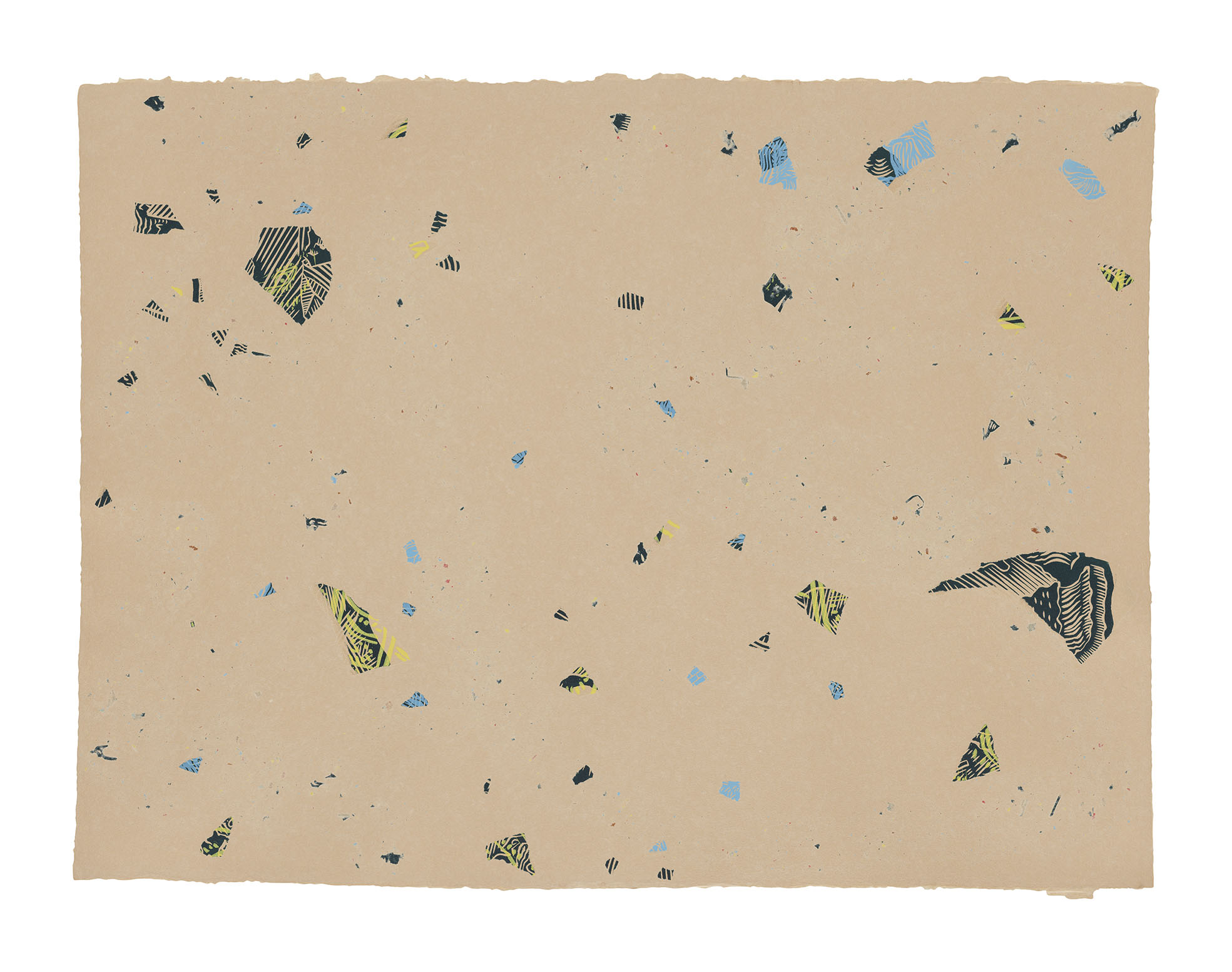
from the series Cada cosa es Babel 53, 2023
signed and dated
unique print on handmade paper 56.5 x 76.5 cm
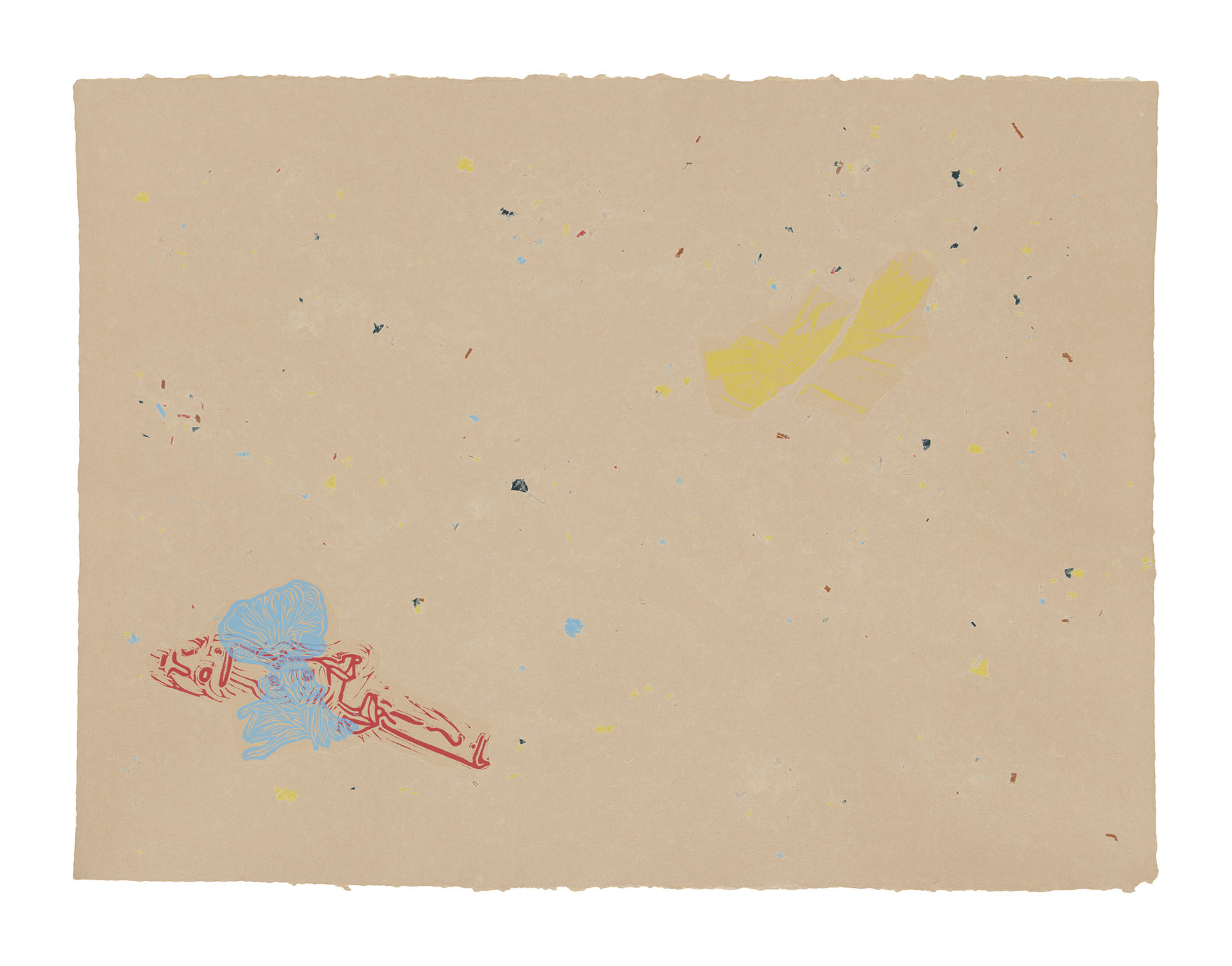
from the series Cada cosa es Babel 48, 2023
unique print on handmade paper 56.5 x 76.5 cm
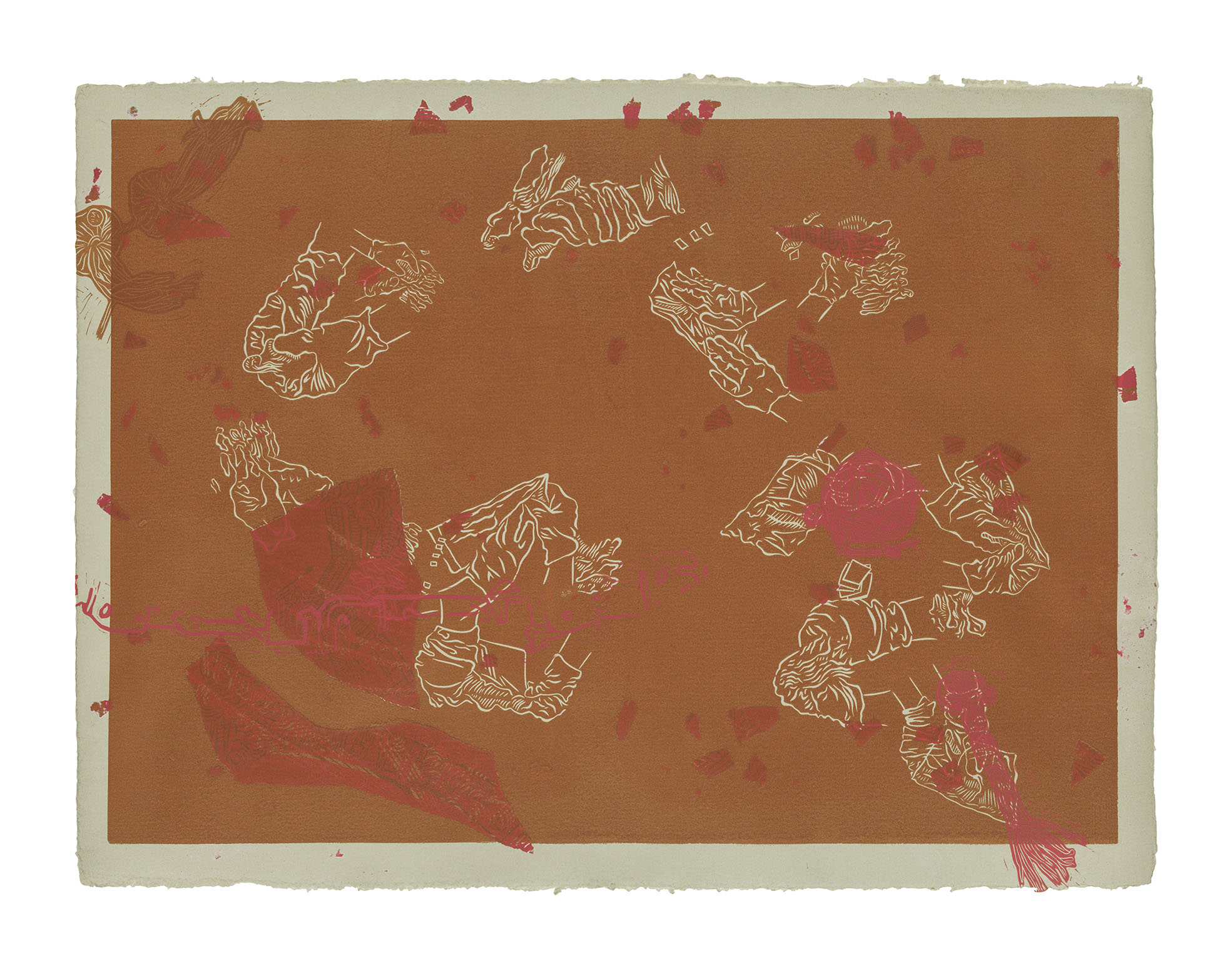
from the series Cada cosa es Babel 8, 2023
signed and dated
unique print on handmade paper 56.5 x 76.5 cm
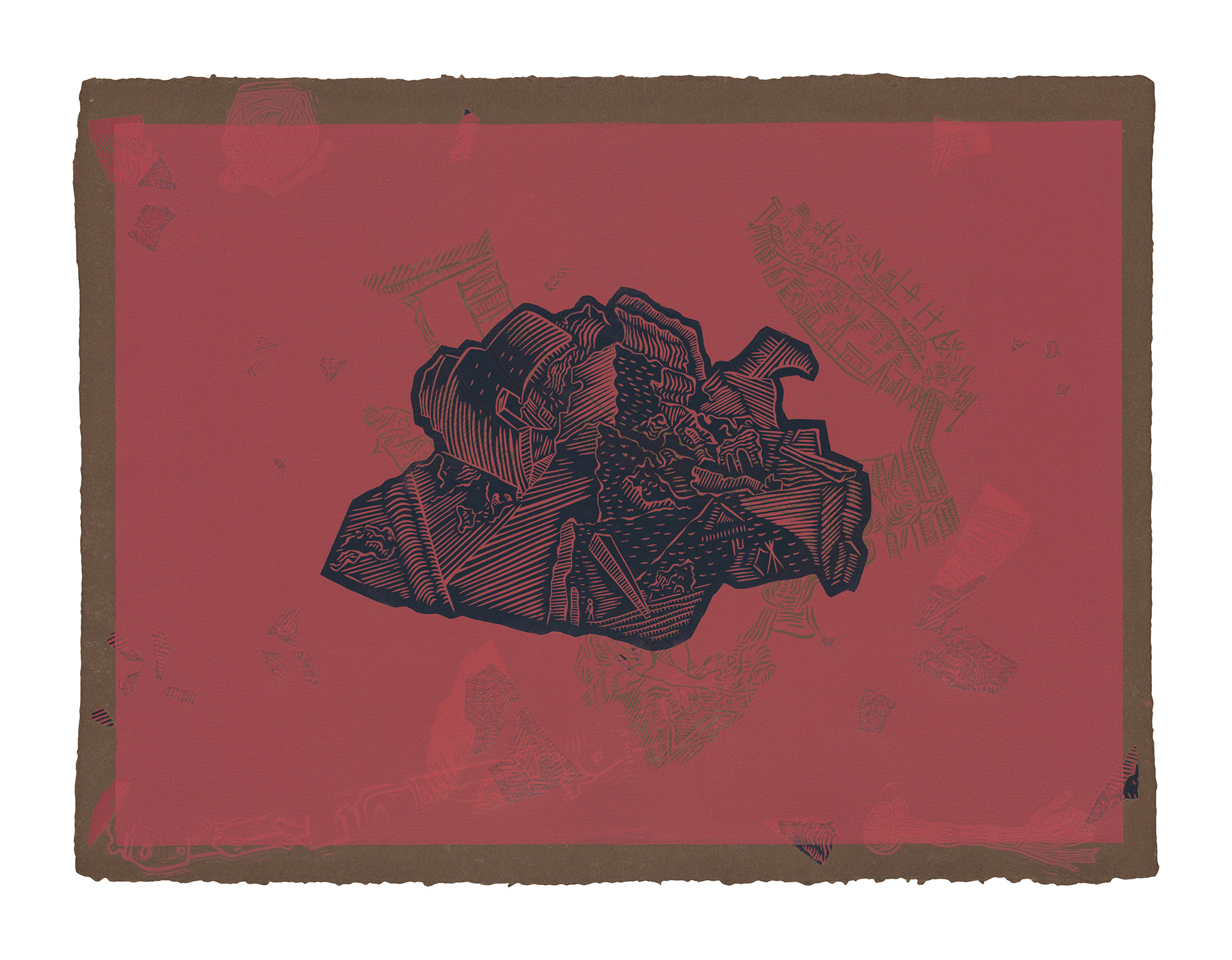
from the series Cada cosa es Babel 11, 2023
signed and dated
unique print on handmade paper 56.5 x 76.5 cm
LUCE DIETRO TRACCE INCOMPIUTE
October 19, 2023 – April 7, 2024
MUDEC, Milan, Italy
Curated by Katya Inozemtseva and Sara Rizzo with the support of 24 Ore Cultura and Fondazione Deloitte
Produced together with NABA – New Academy of Fine Arts – students directed by Salvatore Averzano
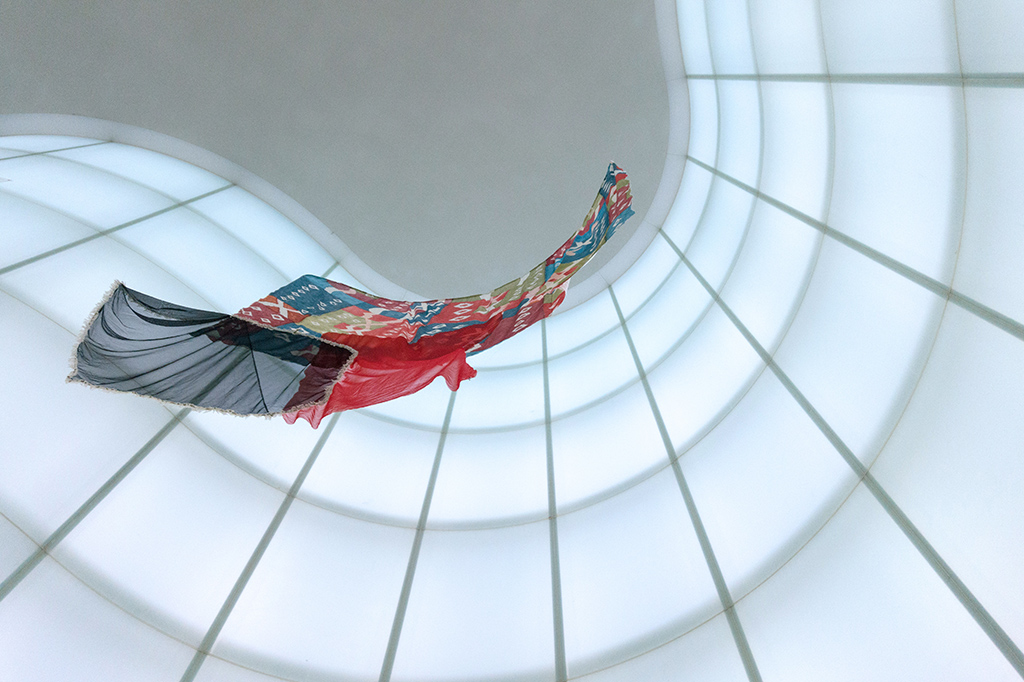
Installation view of “Luce dietro tracce incompiute”, in collaboration with NABA Milan
Curators: Katya Inozemtseva e Sara Rizzo
Photo: Giorgia Garuti
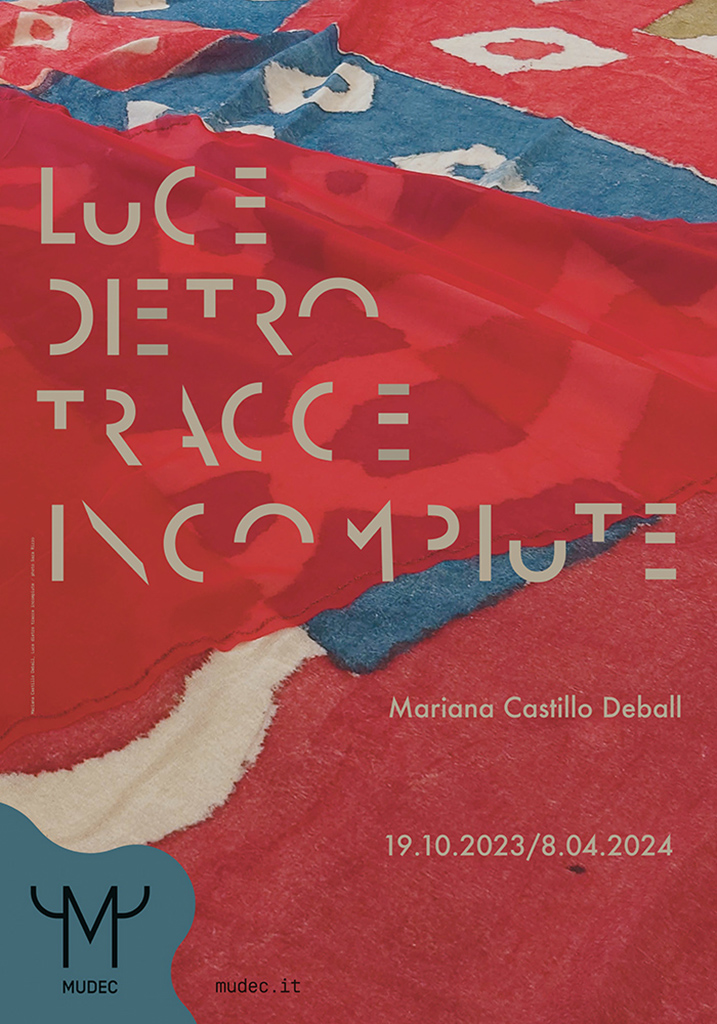
Installation view of “Luce dietro tracce incompiute”, in collaboration with NABA Milan
Curators: Katya Inozemtseva e Sara Rizzo
Photo: Giorgia Garuti

Luce dietro tracce incompiute, studio model
"Luce dietro tracce incompiute" it is the title of the textile installation by Mexican artist Mariana Castillo Deball (b. 1975), which will welcome visitors to the Museum in its monumental dimensions from Thursday, Oct. 19 until April 7, 2024. As part of Mudec's vision aimed at contemporary themes and practices, the Museum of Cultures presents for fall 2023 the second site-specific project curated by Katya Inozemtseva and Sara Rizzo with the support of 24 Ore Cultura and Fondazione Deloitte, this time to be hosted in the heart of the Agora.
Working with the collections of MUDEC and Fondazione Ratti Mariana Castillo Deball selected twelve textile fragments from different geographies and periods of time, based on which she subsequently created her own watercolors. These interpreted images were printed on fabric in an enlarged format, and assembled with additional textile elements at the NABA laboratories together with a group of students guided by Salvatore Averzano. In this way, three-dimensional "palimpsests" were formed, shimmering with different meanings and stories.
For the first time, the intervention on the glass surface of the Agora also changes the very status of the architecture, transforming it into a reflecting volume against which the sculptures, created with light, and semi-transparent fabrics, appear.
The natural light filtering through this composition of textile fragments, creating a new cartography.
Finally, a program of guided tours of the collections' storerooms will allow the public to discover the Museum's pieces reinterpreted by Deball in her installation. This recreates the often invisible link between the exhibition space and the heritage that becomes fully accessible.
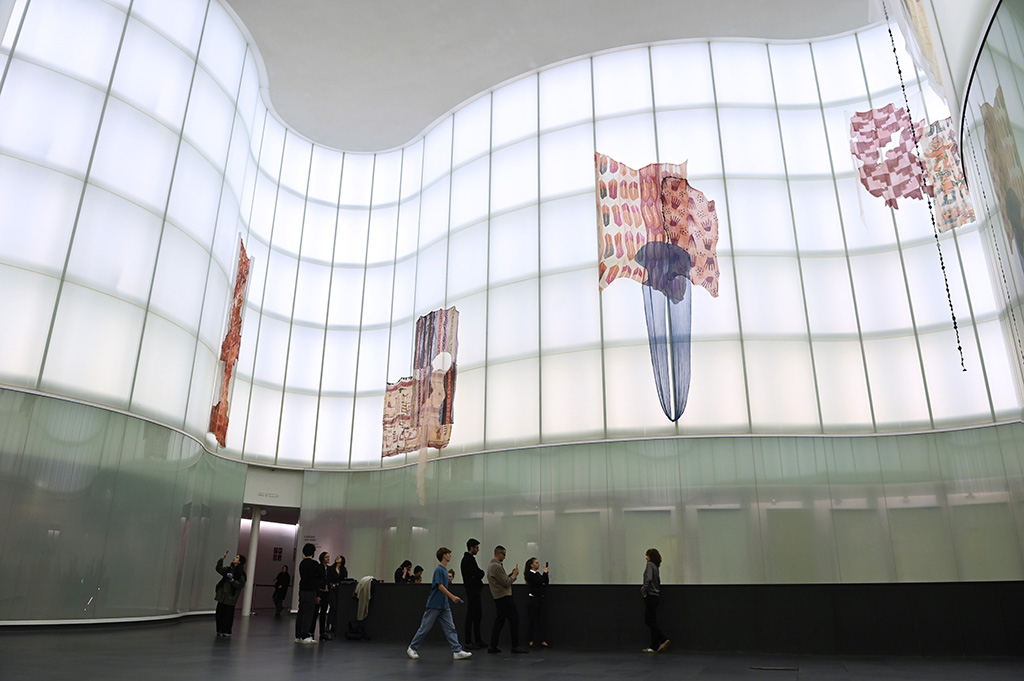
Installation view of “Luce dietro tracce incompiute”, in collaboration with NABA Milan
Curators: Katya Inozemtseva e Sara Rizzo
Photo: Giorgia Garuti
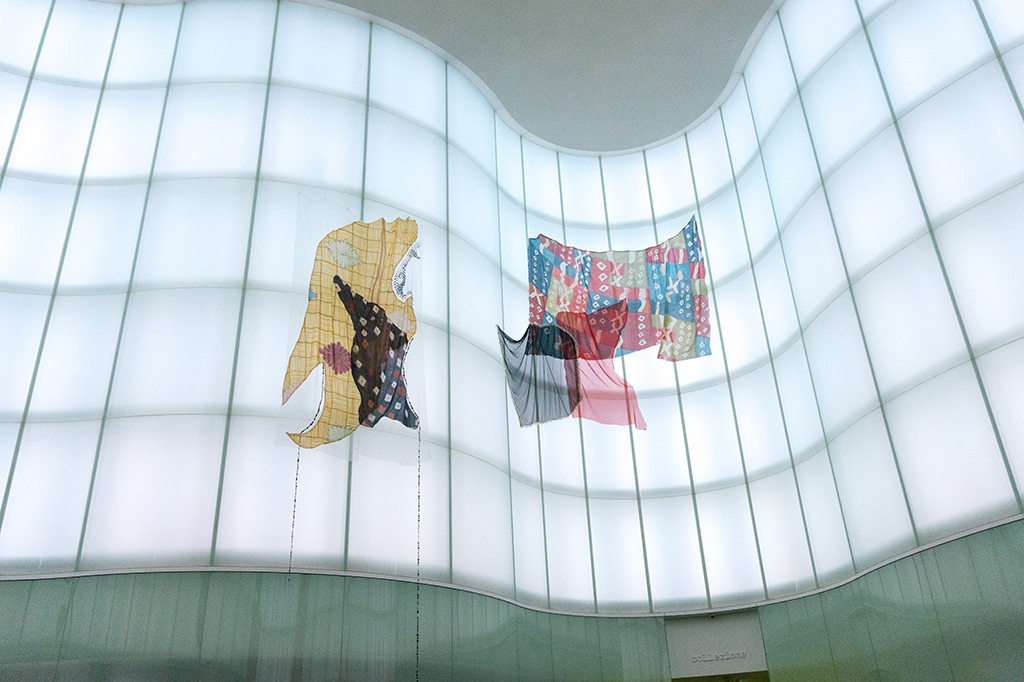
Luce dietro tracce incompiute, curators: Katya Inozemtseva e Sara Rizzo, in collaboration with NABA Milan
Photo: Giorgia Garuti
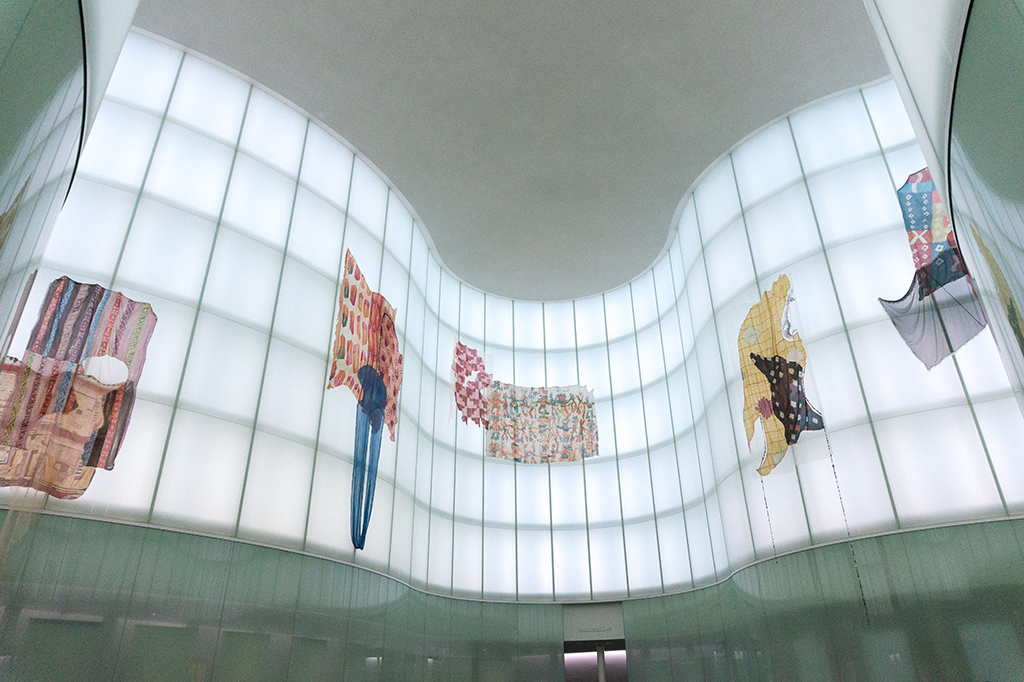
Installation view of “Luce dietro tracce incompiute”, in collaboration with NABA Milan
Curators: Katya Inozemtseva e Sara Rizzo
Photo: Giorgia Garuti
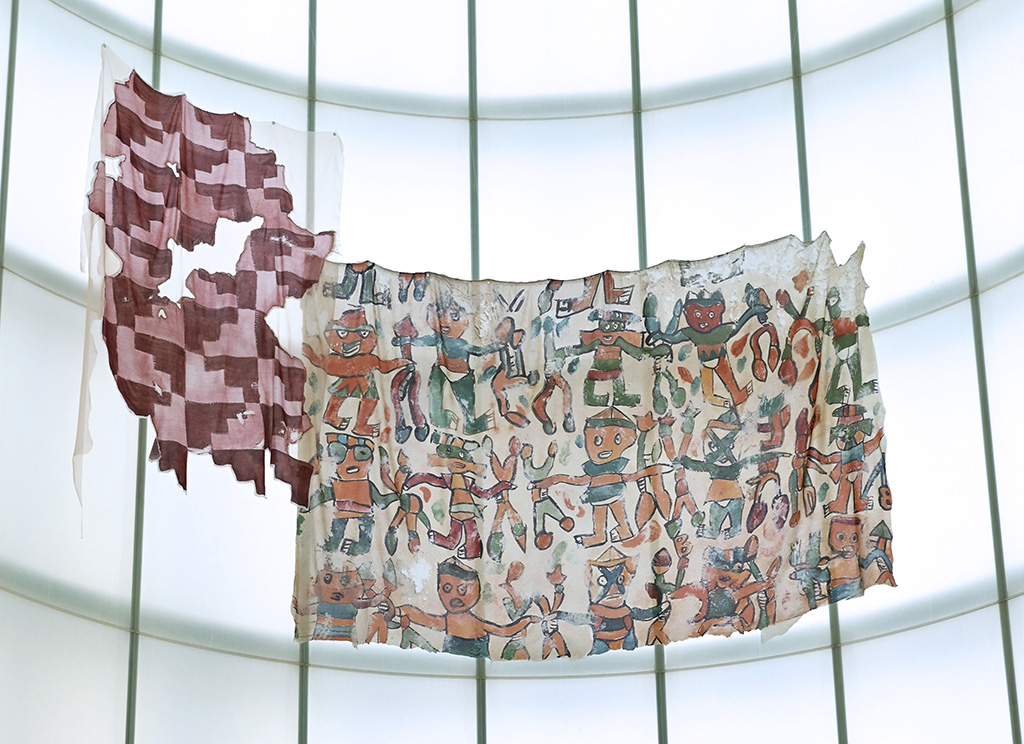
Installation view of “Luce dietro tracce incompiute”, in collaboration with NABA Milan
Curators: Katya Inozemtseva e Sara Rizzo
Photo: Giorgia Garuti
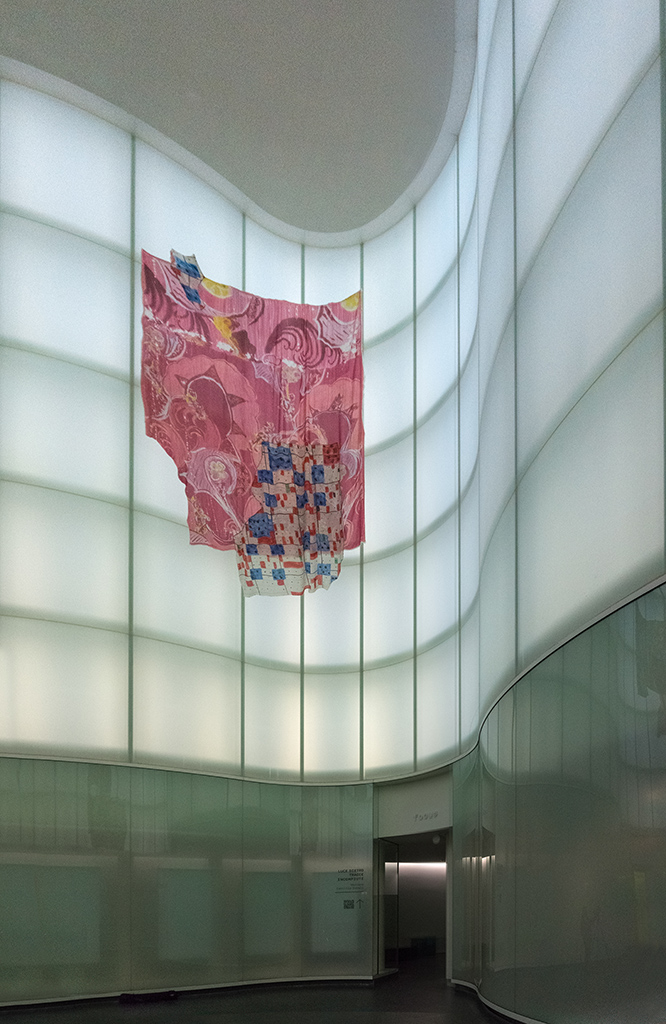
Luce dietro tracce incompiute, curators: Katya Inozemtseva e Sara Rizzo, in collaboration with NABA Milan
Photo: Giorgia Garuti
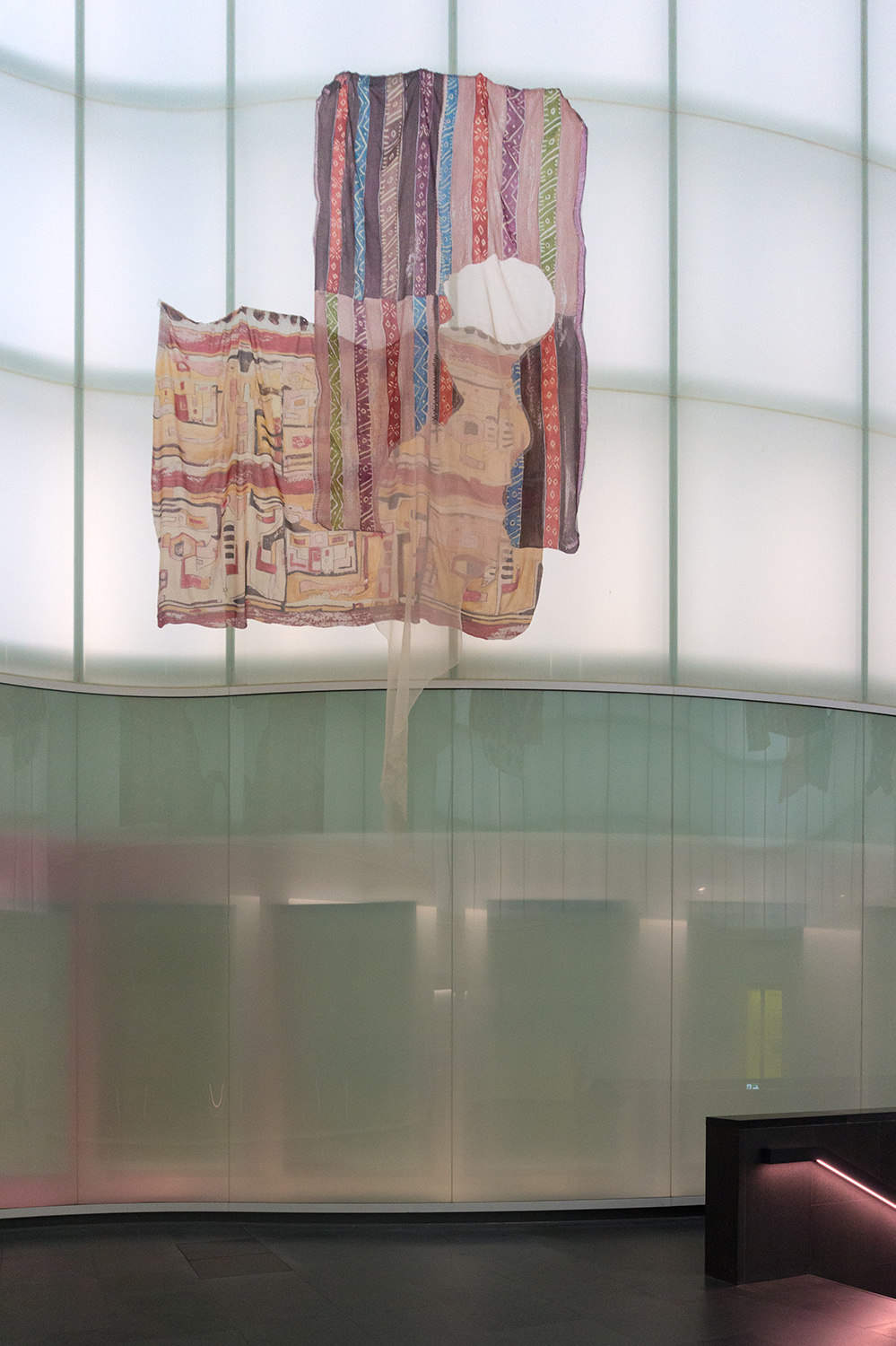
Luce dietro tracce incompiute
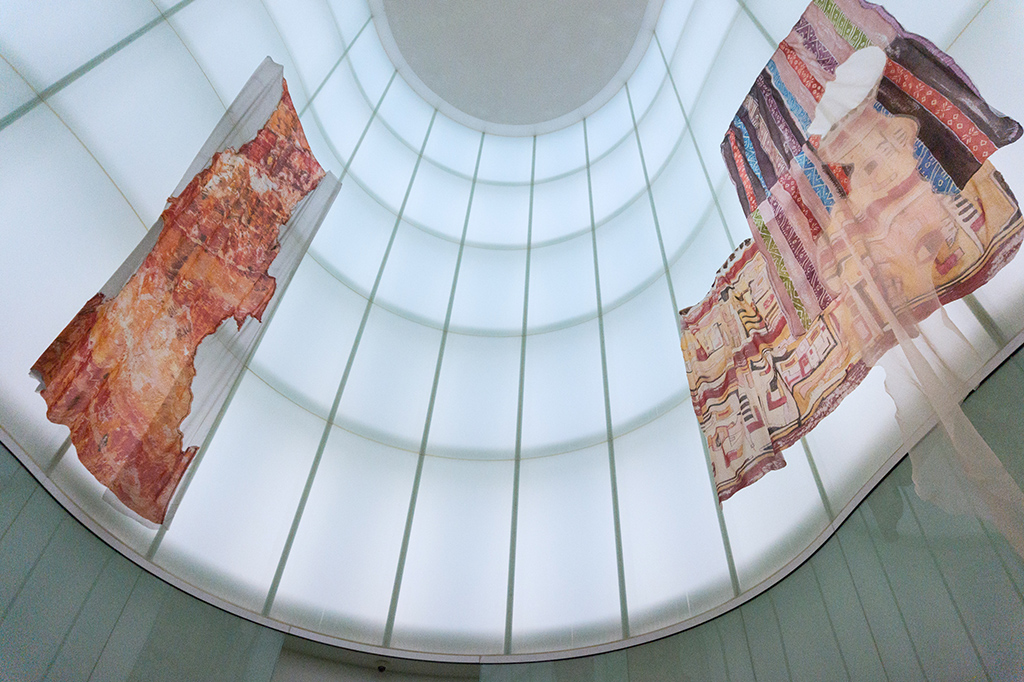
Installation view of “Luce dietro tracce incompiute”, in collaboration with NABA Milan
Curators: Katya Inozemtseva e Sara Rizzo
Photo: Giorgia Garuti
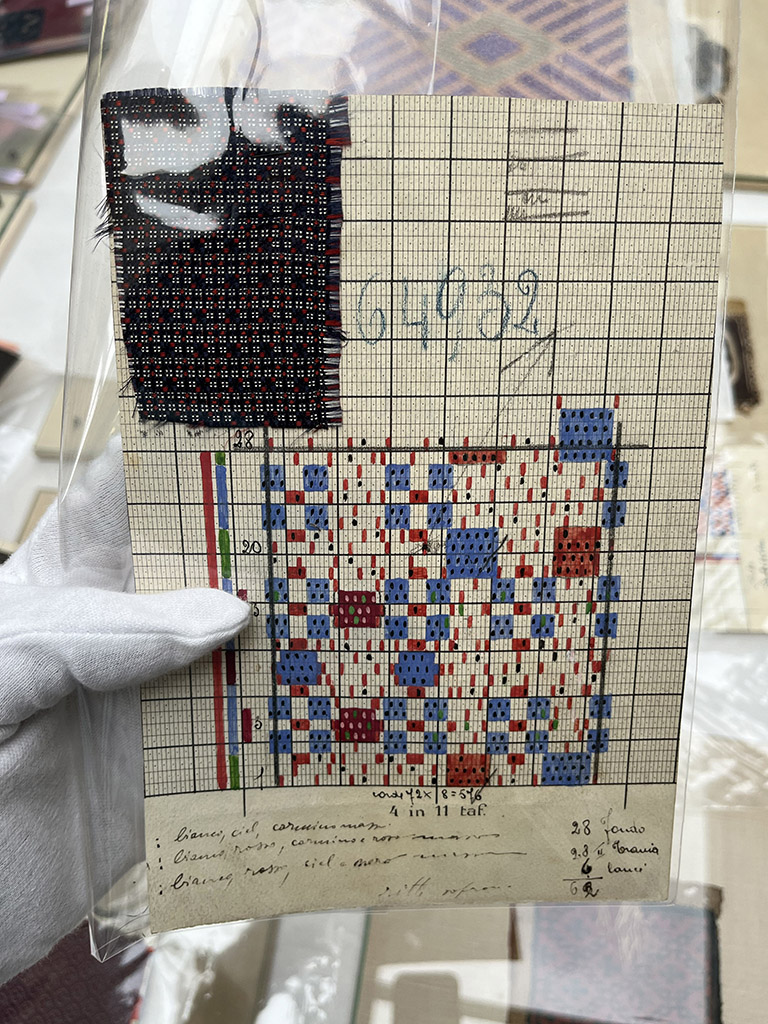
Research at the textile collection Antonio Ratti
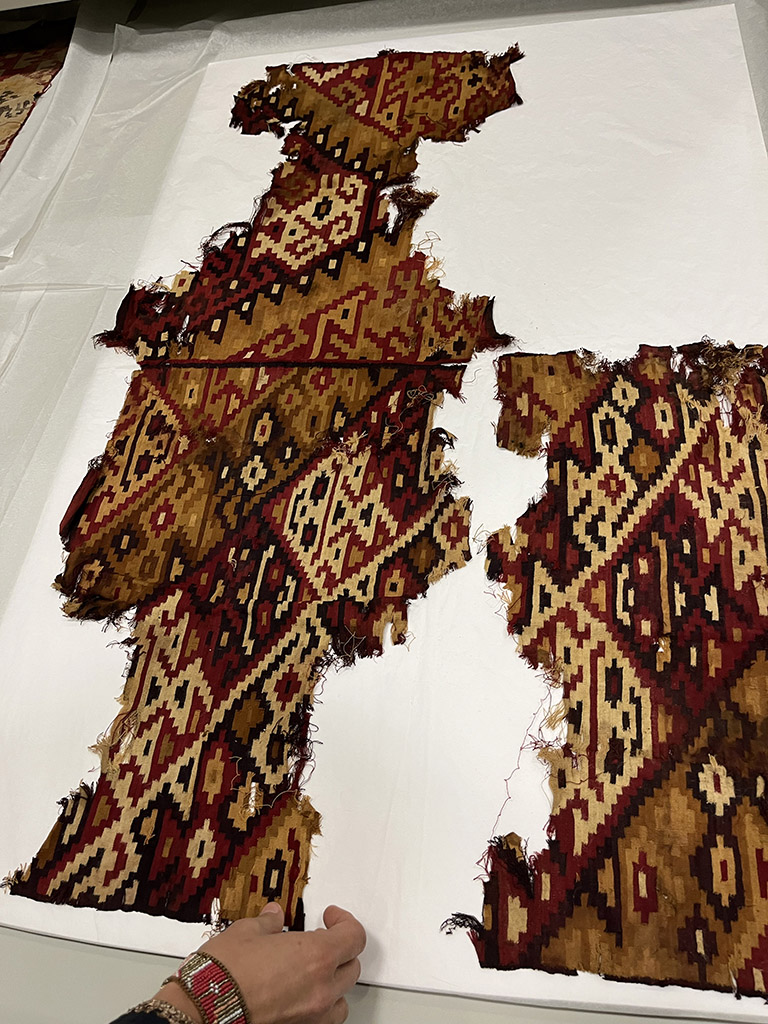
Installation view of “Luce dietro tracce incompiute”, in collaboration with NABA Milan
Curators: Katya Inozemtseva e Sara Rizzo
Photo: Giorgia Garuti
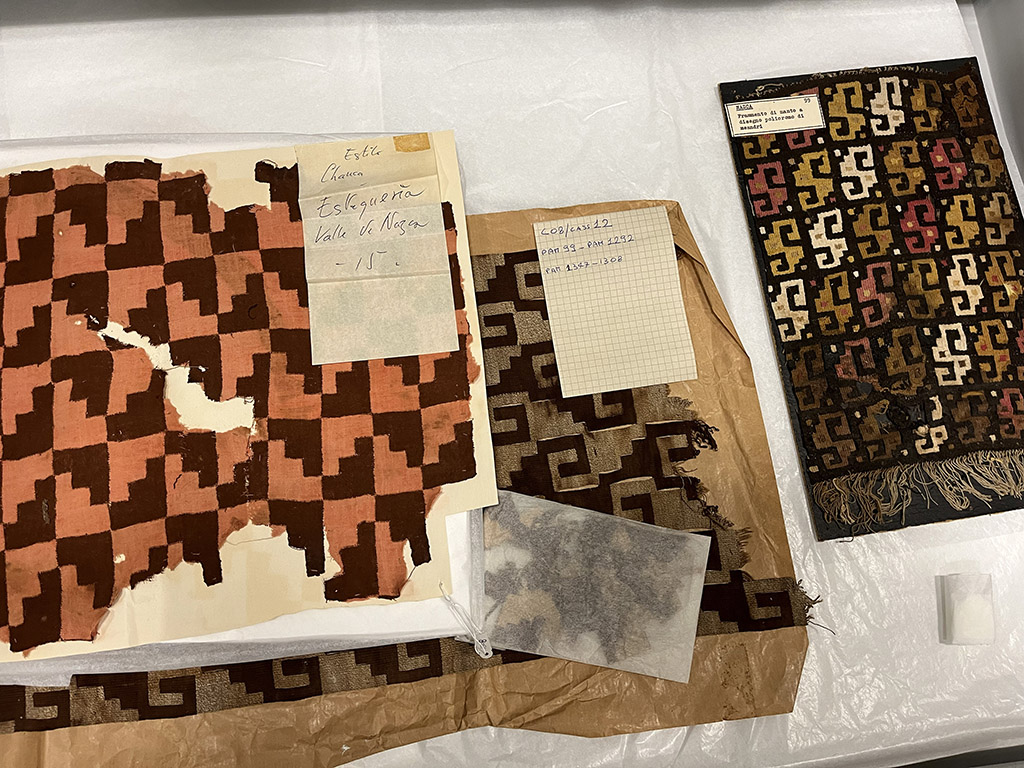
Installation view of “Luce dietro tracce incompiute”, in collaboration with NABA Milan
Curators: Katya Inozemtseva e Sara Rizzo
Photo: Giorgia Garuti
video NABA - Production Workshop at MUDEC
TEXTILE TEAM: Salvatore Averzano, Francesca Bricchi, Martina Camillo, Camilla Bertoni
STUDENTS: Ren Yingjun, Shen Yuchu, Anna Rosa Confuorti, Noemi Gennarino, Kübra Golak, Eda Polat
STUDIO CASTILLO DEBALL: Original watercolours drawings based on MUDEC's textile collection:
Silvia Andrade and Azul Ehrenberg
As Hardly Found in the Art of Tropical Architecture
An exhibition recentring work from the peripheries of the Department of Tropical Studies archive
Albert Brenchat-Aguilar
Why am I interested in moulds and positives and negatives and papier-mâché in the context of As Hardly Found? It has a lot to do with the materiality of things; also, with transforming the skin of the archive into something else. That surface is almost a leftover, and has a different way of expressing itself: it’s a bit clumsier. It seems to me that As Hardly Found is interested not in the contents of the archive itself but the people and the work on its peripheries. The power of the copy, of repetition and of the transformation of original sources is also significant and potentially dangerous in the global south. It was difficult to try to work with the darker, technical violence that took place as DTS architects went to teach people living in other countries how they should make their buildings. I wanted to find a new space within the dryness and hardness of the solutions they were proposing and the materials they advocated for. Paper pulp is soft and humble, contrasting with the permanence of architectural materials like concrete and wood – if you put one of my pieces in water for half an hour, it would completely dissolve. That impermanence was important to me. Also, a sense of humour, and the idea that things don’t need to be perfect – you just do it because you want to do it, even if you don’t have access to the original, even if you were not there. Who has access to these archives? Very few people. That was also something I was thinking about while working on this exhibition.
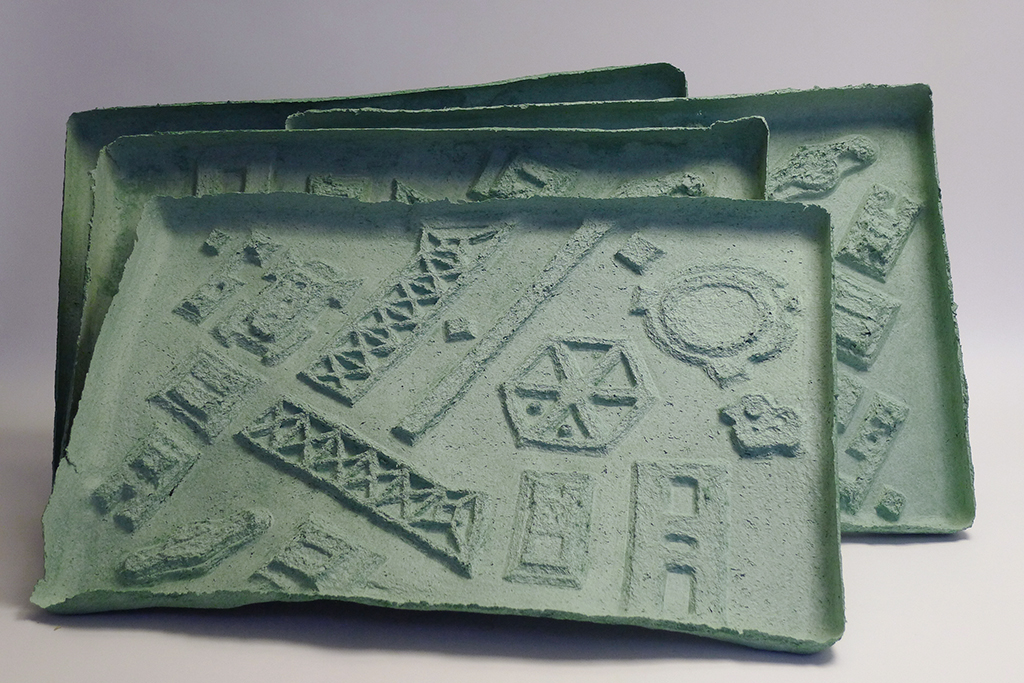
It took me a while to understand the archive of the Department of Tropical Studies. When I came to visit the AA in summer 2022 with Ed Bottoms, Albert Brenchat-Aguilar, Manijeh Verghese, and Harriet Jennings we spent time exploring the archive opening and closing boxes, and there was a moment of revelation when we saw where things are stored, containing hundreds of papers and reports. There was a distinction between the archival boxes and the content itself, which was often very dry and difficult to digest, and rather problematic at times. Somehow, I preferred to stay on the soft surface – the skin of things was more appealing to me than the actual reports, diagrams and analysis.
All the boxes in the archive are made with a distinctive type of green cardboard, and I started to imagine how I might use this material and transform it into something else. We got in touch with the paper company, Conservation by Design, that produces these boxes for many different archives in the UK. I asked them if I could have bits and pieces of their leftovers, and they sent a parcel with about 30kg of paper scraps which I then brought back to my studio in Berlin.
I often work with paper and papier-mâché, but here I used a technique I had never tried before: using the leftover material make a pulp. Then, I made a series of plaster moulds based on some materials that appealed me from the archive. One is a poster for Action Planning that the director of the Department of Tropical Studies commissioned (Figure 1), with a drawing at the top that looks like an abstract expressionist painting and a very modernist typeface at the bottom. It's so condensed and so brutal in a way, but when I transformed it into papier-mâché it became something else, somehow collapsing to become very soft. I made another piece based on a magazine that was featured in the exhibition (Figure 2),[1] with a kind of verna window and a tree on the front; behind, in a different layer, is the title of the magazine.
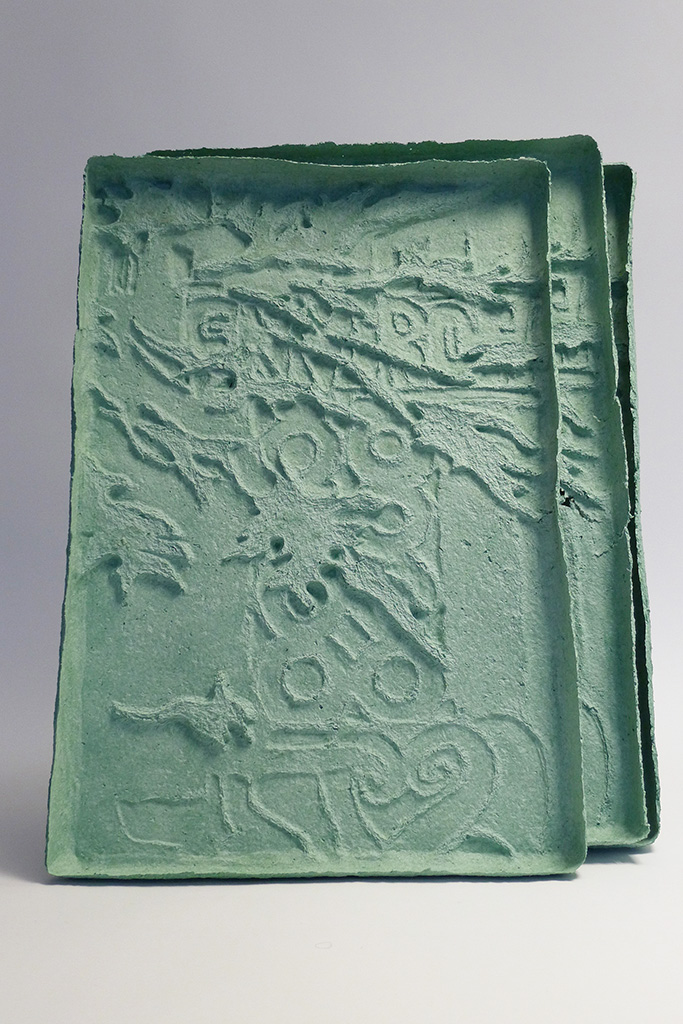
The third and final piece (Figure 3) is based on a maquette for a sculpture sited on top of a cooling tower in Pimlico, London by the artist Eduardo Paolozzi; the maquette itself is exhibited at the AA, at the top of the staircase at 36 Bedford Square. Though I never met Paolozzi, I refer to his work a lot in my own practice.[2] He was also very interested in papier-mâché – the first work I made about him was based on an exhibition he curated at the British Museum called Lost Magic Kingdoms and Six Paper Moons, which referred to a Mexican rain goddess who became a papier-mâché sculpture.[3]
[1] Environ: The Magazine of the Faculty of Architecture, University of Science and Technology, Kumasi, Ghana, 1.1 (1975).
[2] For Mariana’s earlier work on Paolozzi, see Mariana Castillo Deball in Conversation with Professor Chris Gosden 20/06/13, https://soundcloud.com/chisenhale-gallery/mariana-castillo-deball-in
[3] Eduardo Paolozzi, Lost Magic Kingdoms and Six Paper Moons from Nahuatl (London: British Museum Publications, 1985).

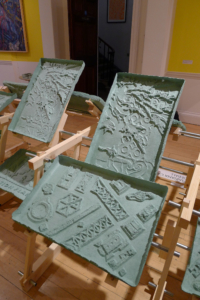
Detail of Archival Boxes, 2022 , 13 papier-mâché reliefs made from archival boxes (each 41 x 60 x 3,5 cm), Installation view in the Exhibition As Hardly Found in the Art of Tropical Architecture, Architectural Association Gallery, London, UK.
Courtesy of Mariana Castillo Deball and Architectural Association
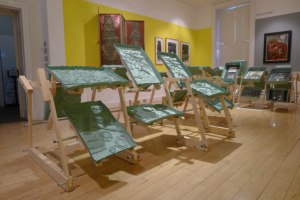
Archival Boxes, 2022 , 13 papier-mâché reliefs made from archival boxes (each 41 x 60 x 3,5 cm), Installation view in the Exhibition As Hardly Found in the Art of Tropical Architecture, Architectural Association Gallery, London, UK.
Courtesy of Mariana Castillo Deball and Architectural Association
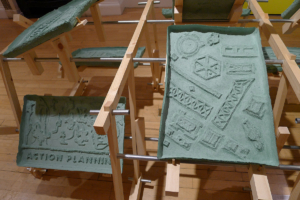
Detail of Archival Boxes, 2022 , 13 papier-mâché reliefs made from archival boxes (each 41 x 60 x 3,5 cm), Installation view in the Exhibition As Hardly Found in the Art of Tropical Architecture, Architectural Association Gallery, London, UK.
Courtesy of Mariana Castillo Deball and Architectural Association
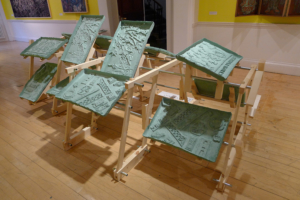
Archival Boxes, 2022 , 13 papier-mâché reliefs made from archival boxes (each 41 x 60 x 3,5 cm), Installation view in the Exhibition As Hardly Found in the Art of Tropical Architecture, Architectural Association Gallery, London, UK.
Courtesy of Mariana Castillo Deball and Architectural Association
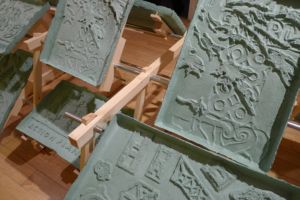
Detail of Archival Boxes, 2022 , 13 papier-mâché reliefs made from archival boxes (each 41 x 60 x 3,5 cm), Installation view in the Exhibition As Hardly Found in the Art of Tropical Architecture, Architectural Association Gallery, London, UK.
Courtesy of Mariana Castillo Deball and Architectural Association
TEN THOUSAND SUNS
24th Biennale of Sydney
9 March - 10 June 2024
Curated by
Cosmin Costinaş and Inti Guerrero

Carved between 1300 and 1500, the Coatlicue is commonly referred to as a representation of an earth goddess, which had a turbulent story both as a mythological figure and also in the way it was excavated in Mexico city in the 18th century. The statue of Coatlicue was discovered and later displayed in the main plaza of Mexico City in 1790. It was one of the fist objects, which was not destroyed by the Spaniards. The indigenous population began to worship it, to prevent this, the statue was buried again in a courtyard of the University where it could not be seen. The statue was dug up in 1803, so that Alexander von Humboldt could make drawings and a cast, as well as the collector William bullock who made another cast, which was displayed in the Egyptian Hall in London, as part of Bullock’s ancient Mexico exhibition. The monumental stone original sculpture is on display at the Anthropology Museum in Mexico city.

In Jennifer Reynolds-Kaye words: “While the Coatlicue was a significant object of veneration for Indigenous people in both pre- and post-contact Mexico, its status as an archaeological specimen and sculpture only came into prominence through two- and three-dimensional copies. This was particularly true when it lay underground, as the copies were the only way of visually accessing the sculpture. After its final disinterment and subsequent display, the Coatlicue became almost hypervisible, appearing at world’s fairs and museums around the world, as well as being reconfigured in paintings, murals and sculptures. This visibility of the sculpture through its copies secured its position in the canon of pre-Columbian art. One significant outcome of the massive proliferation of the Coatlicue and other pre-Columbian objects was that modern and contemporary Mexican artists began to think more critically about the role of the pre-Columbian past in their own identity.”1
1. Jennifer Reynolds-Kaye , Circulating casts of the Coatlicue: Mariana Castillo Deball’s unearthing of the Aztec earth goddess’s history of reproduction and display. Sculpture Journal, Volume 28, Number 3, 2019

Ceremony
(Burial of an Undead World)
Group Exhibition at Haus Kulturen der Welt
October 23 – December 30, 2022
During the summer of 2022 I worked together with the paper producers Gangolf Ulbricht and Ulrich Kühle at Keystone editions printing workshop in Berlin, developing a new series of 30 unique prints, for the exhibition Ceremony (Burial of an Undead World) at Haus der Kulturen der Welt in Berlin.
It was a very interesting process with different steps in which I printed the motives in blue, red and yellow, on three different papers developed by Gangolf Ulbricht.
Once these prints were ready, I ripped them apart into small pieces, and blended them into tiny particles. These crushed prints were added into paper pulp during the making of new sheets. Afterwards I returned to keystone editions, and we printed on top of the new paper sheets. The series of images I developed exist in a transition zone between a completed image and a deconstructed one, an archeological dig and a puzzle.
Essay:
The Ceremony Can(Not) Be Found in the Serpent(ine)
Zairong Xiang
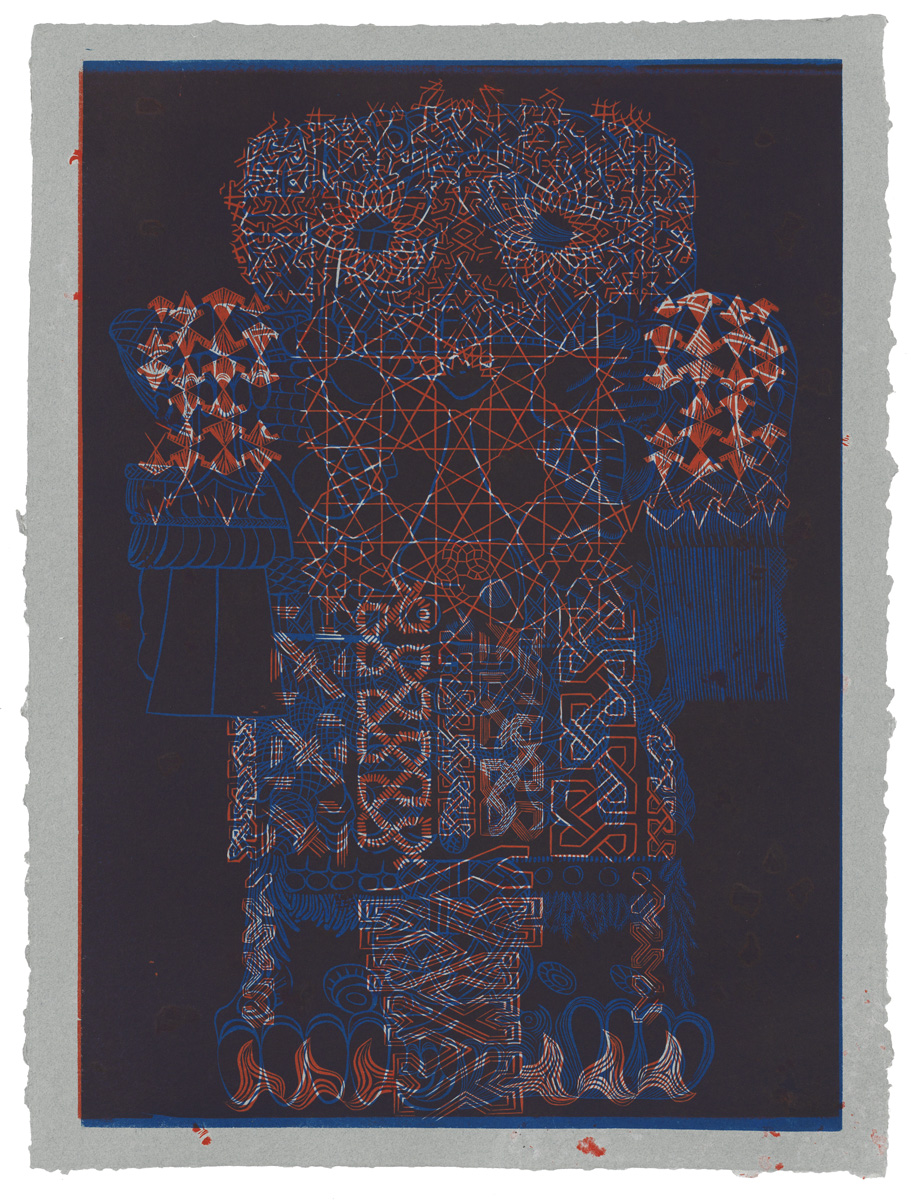
She bends to catch a feather of herself as she falls, No 17, 2022
76 x 56 cm, Linocut print on custom handmade paper
Paper made by: Gangolf Ulbricht
Werkstatt für Papier
Printing: Keystone Editions

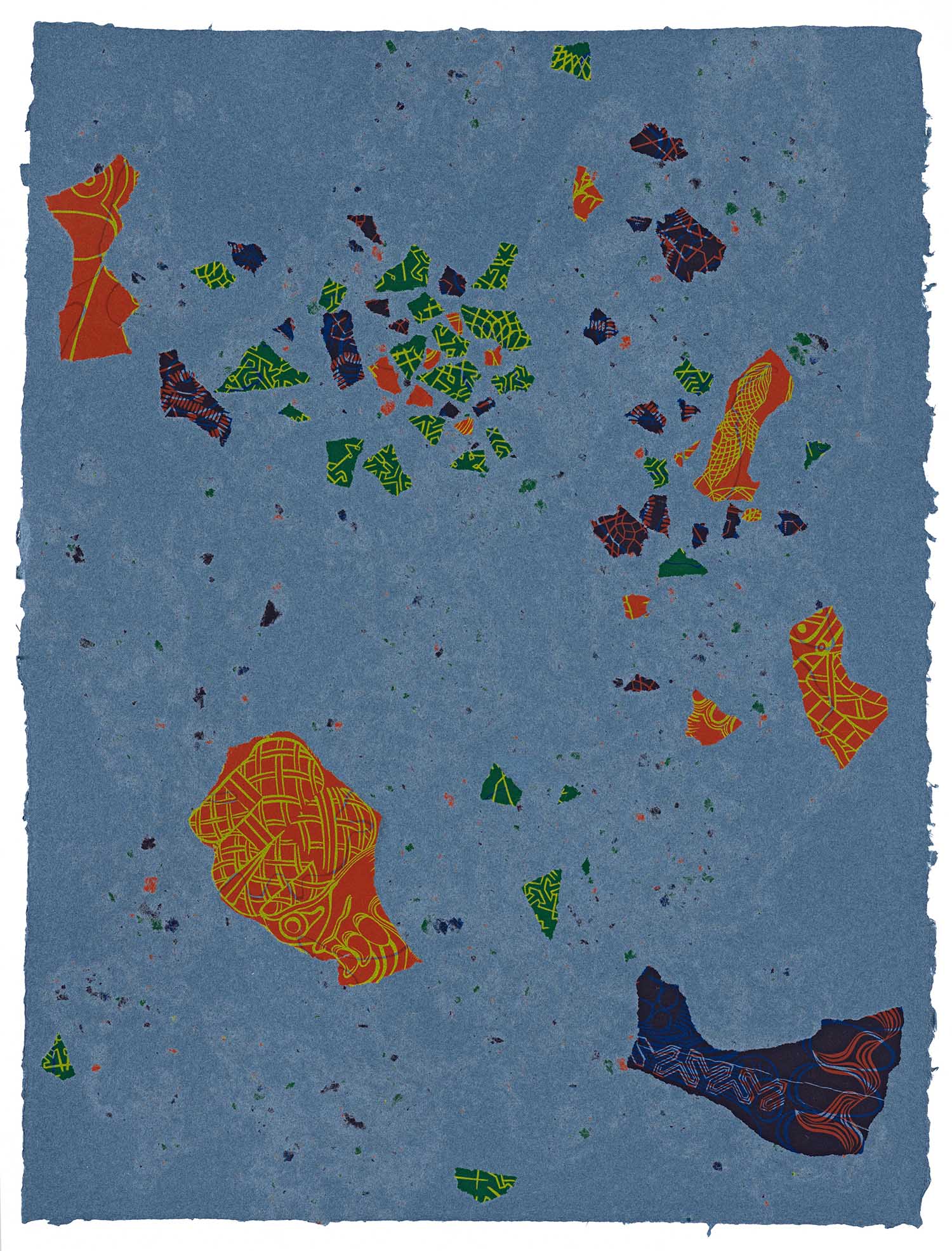
She bends to catch a feather of herself as she falls, No 30, 2022
76 x 56 cm, Linocut print on custom handmade paper
Paper made by: Gangolf Ulbricht
Werkstatt für Papier
Printing: Keystone Editions
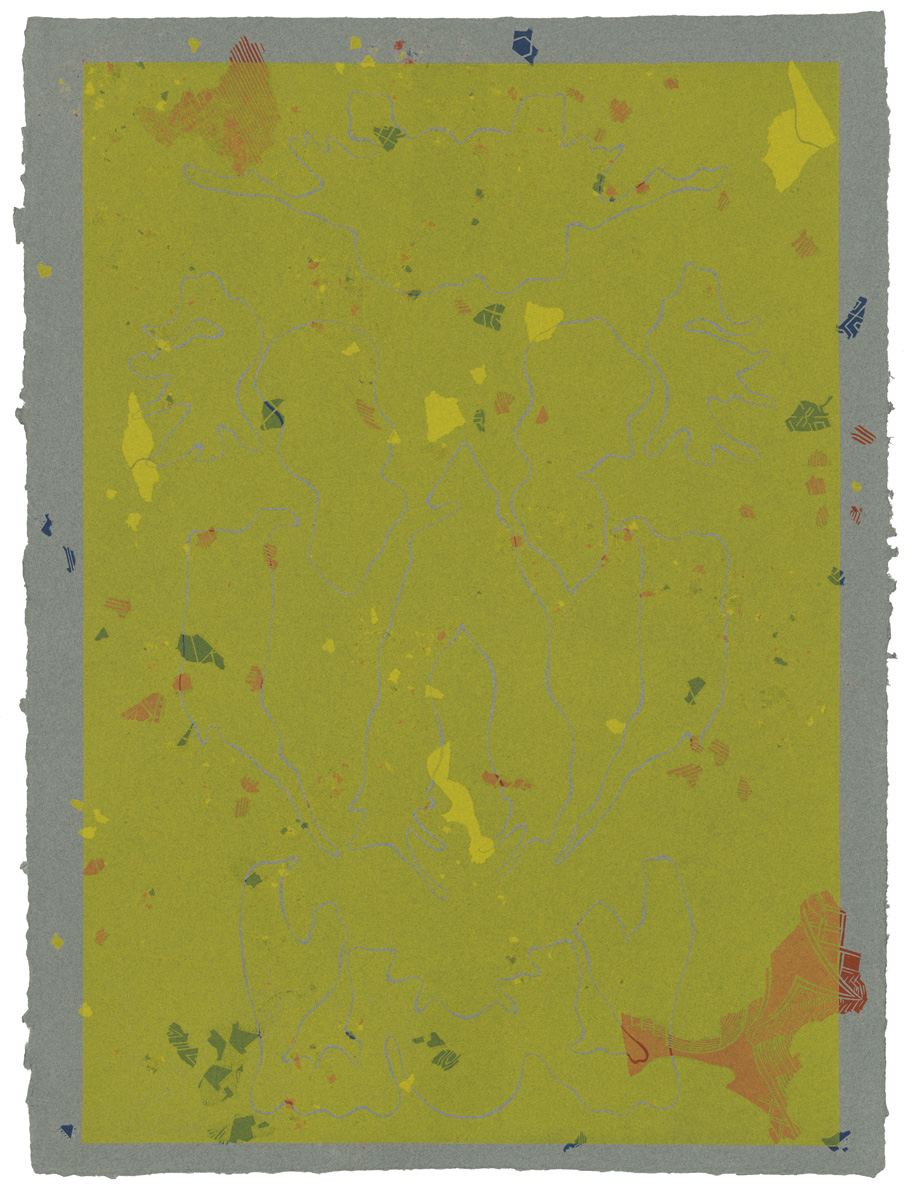
She bends to catch a feather of herself as she falls, No 10, 2022
76 x 56 cm, Linocut print on custom handmade paper
Paper made by: Gangolf Ulbricht
Werkstatt für Papier
Printing: Keystone Editions
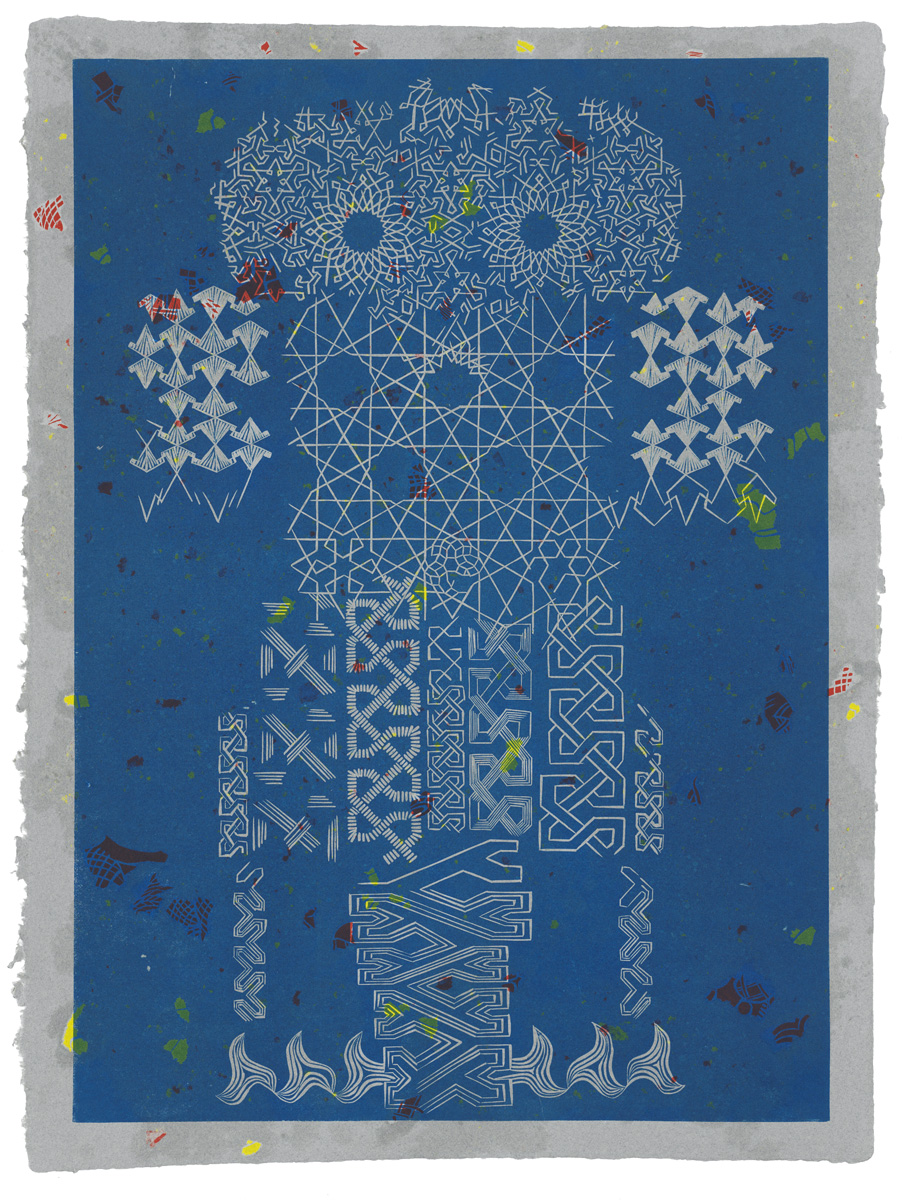
She bends to catch a feather of herself as she falls, No 18, 2022
76 x 56 cm, Linocut print on custom handmade paper
Paper made by: Gangolf Ulbricht
Werkstatt für Papier
Printing: Keystone Editions
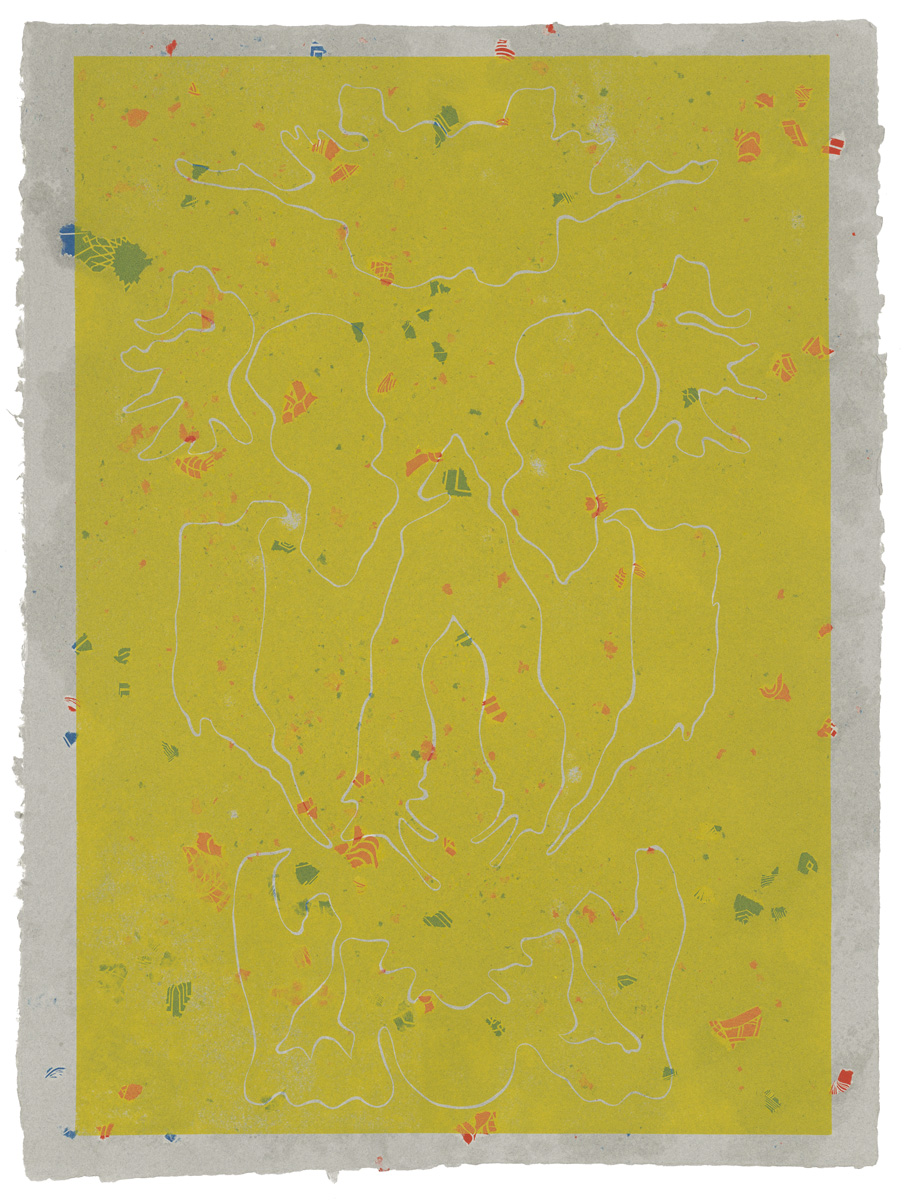
She bends to catch a feather of herself as she falls, No 13, 2022
76 x 56 cm, Linocut print on custom handmade paper
Paper made by: Gangolf Ulbricht
Werkstatt für Papier
Printing: Keystone Editions

She bends to catch a feather of herself as she falls, No 17, 2022
76 x 56 cm, Linocut print on custom handmade paper
Paper made by: Gangolf Ulbricht
Werkstatt für Papier
Printing: Keystone Editions
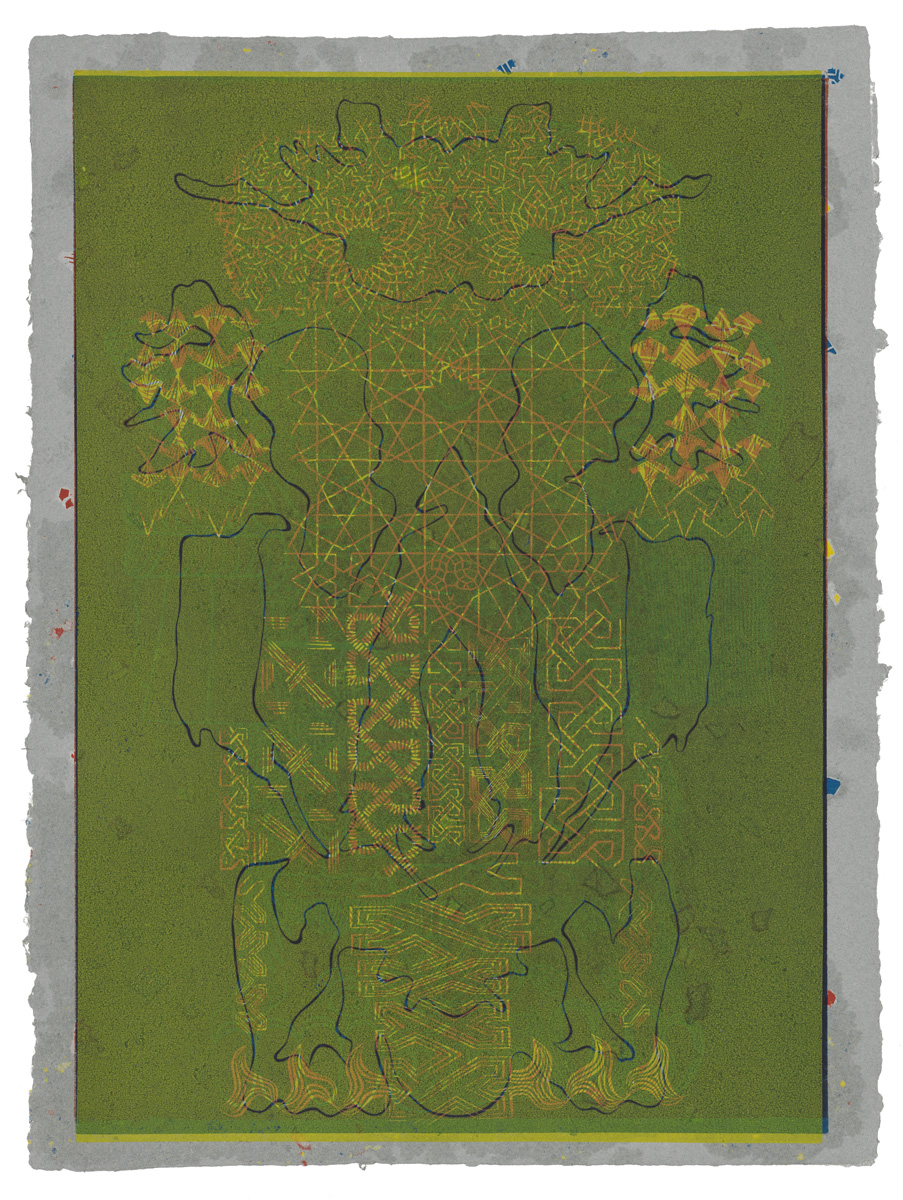
She bends to catch a feather of herself as she falls, No 27, 2022
76 x 56 cm, Linocut print on custom handmade paper
Paper made by: Gangolf Ulbricht
Werkstatt für Papier
Printing: Keystone Editions
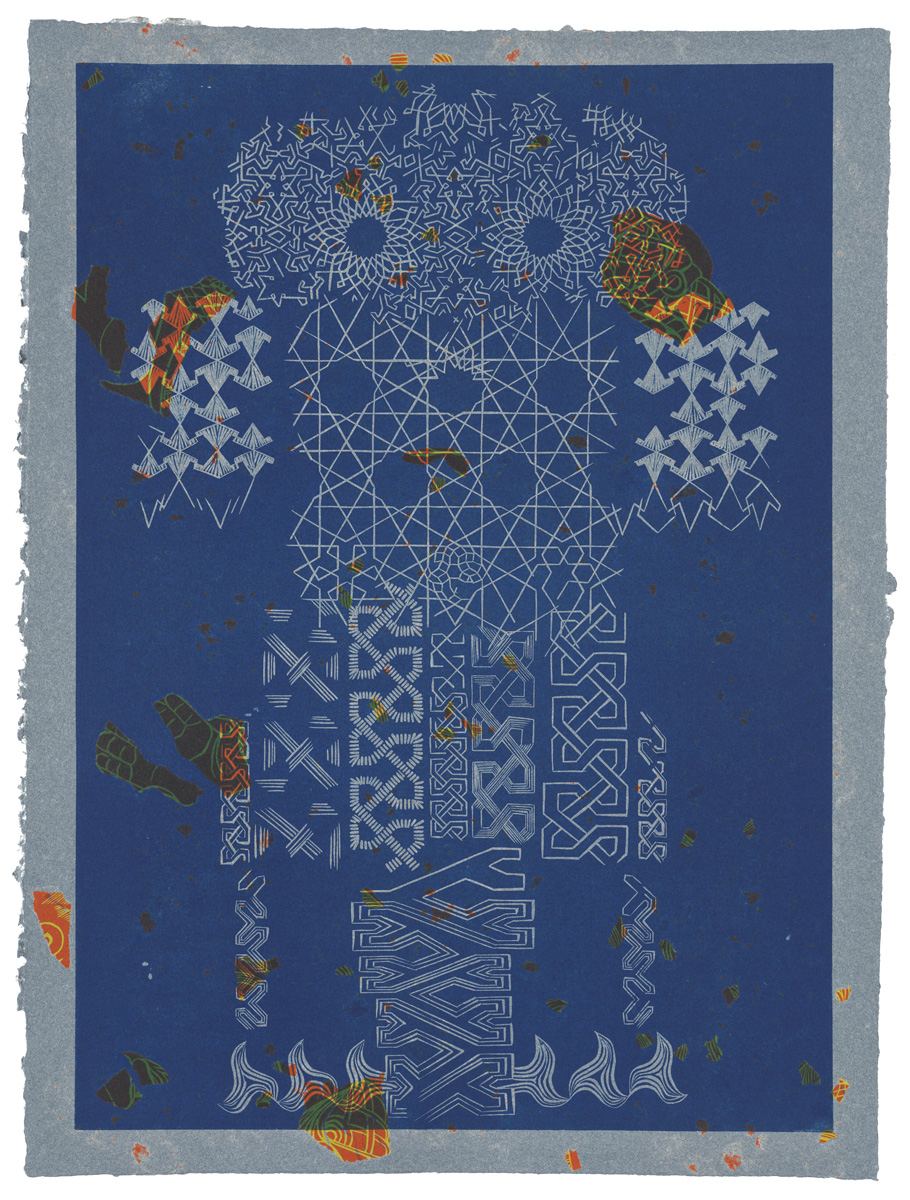
She bends to catch a feather of herself as she falls, No 20, 2022
76 x 56 cm, Linocut print on custom handmade paper
Paper made by: Gangolf Ulbricht
Werkstatt für Papier
Printing: Keystone Editions
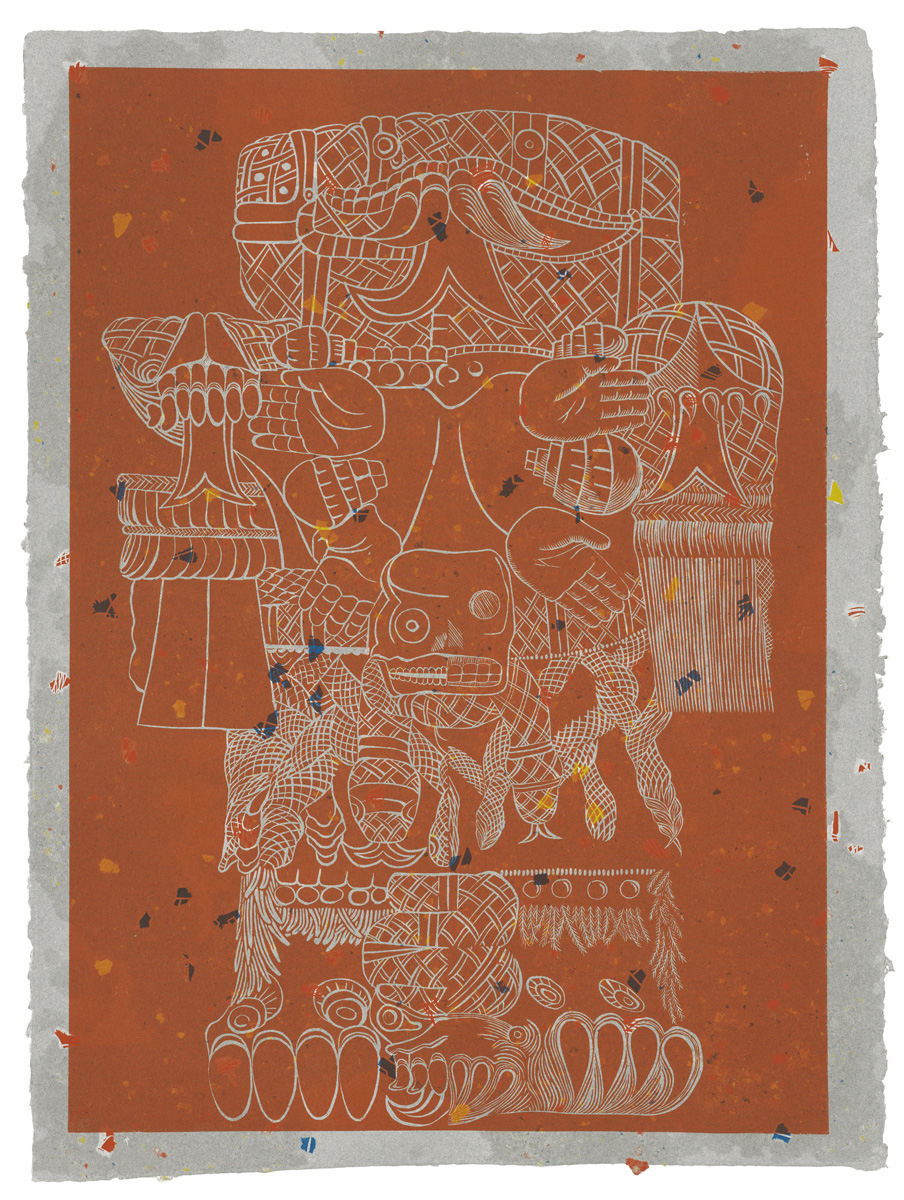
She bends to catch a feather of herself as she falls, No 21, 2022
76 x 56 cm, Linocut print on custom handmade paper
Paper made by: Gangolf Ulbricht
Werkstatt für Papier
Printing: Keystone Editions

She bends to catch a feather of herself as she falls, No 9, 2022
76 x 56 cm, Linocut print on custom handmade paper
Paper made by: Gangolf Ulbricht
Werkstatt für Papier
Printing: Keystone Editions
Roman Rubbish
August 4, 2022 – Januari 21, 2023 - curated by Nancy Rosen
Bloomberg SPACE, London, UK
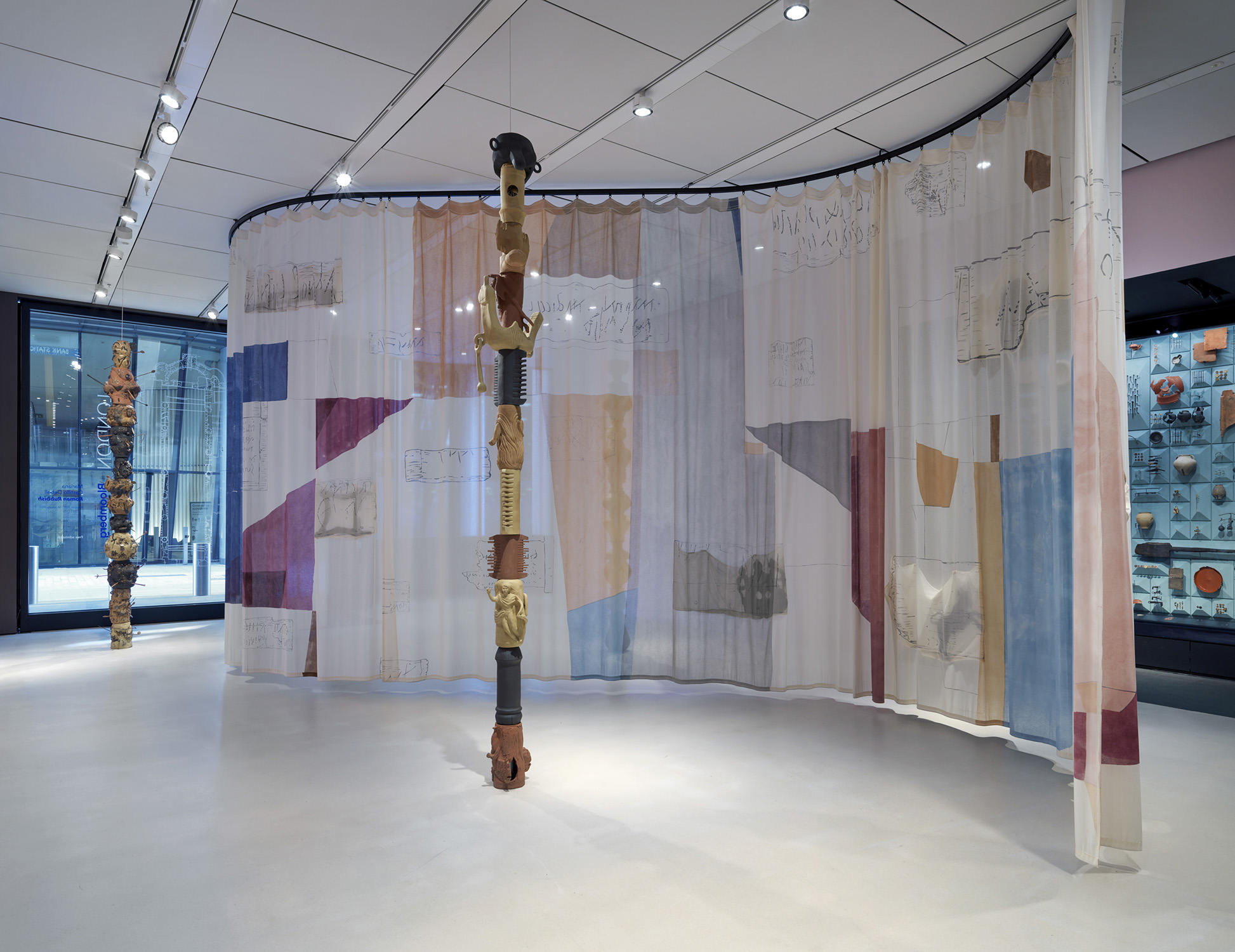
Exhibition view of Roman Rubbish, Bloomberg SPACE, London. 2022
Photo: Marcus Leith
Roman Rubbish is an intricately-detailed, extensively-researched composition, inspired by the 14,000 Roman artefacts discovered on the site of Bloomberg’s European headquarters during the 2012 – 2014 archaeological excavations. The installation comprises of towering pillars of ceramic sculptures, an elegant textile curtain and a wax feature wall with delicate inscriptions.
Roman Rubbish uses repetition and variation, allowing a narrative to emerge: a short story centred around the items found on the site, including ceramic vessels, combs, amulets and other personal objects. Deball is interested in how these objects, once discarded by their Roman owners, have been rediscovered perfectly preserved centuries later. Deball assembles oversized ceramic representations of these objects into columns, standing at over three metres tall. Showcased together, these unique yet similar artefacts highlight the vast variety of objects left behind by the City of London’s predecessors.
Visitors are able to explore other oversized representations of the artefacts suspended in pockets, sewn into a delicate textile curtain. Weaving between the installation’s ceramic columns, the curtain is hand-painted with images of wooden writing tablets found on the Bloomberg excavation site. The curtain leads to a monolithic wax wall, echoing the materials used in Roman writing tablets, delicately inscribed with descriptions of archaeological artefacts in the Bloomberg collection.
The Mexican artist’s new exhibition uses Roman detritus to suggest that we can tell more about a society by what it throws out than the culture it preserves.
In her installation, Roman Rubbish, three towers of stacked ceramics suggest ways that our understanding of the worth and meaning of objects can change. In one, amorphous ceramics have been occasionally burnished with metallic glaze and are stuck through with a hotchpotch of things that can easily fall to the floor, including coins, pins and dice. Another column puts the business of preservation at the centre, carefully recreating pots with breakages and all. The final ceramic work enlarges tiny amulets – “a phallus on one side, a vagina on the other” – as well as toothless combs, suggesting how their significance has grown.
A gauzy curtain connects the works, painted with scripts from the tablets and with further interpretations of artefacts concealed in pockets to make teasing silhouettes: uncertain shadows cast by the elusive past. One clearly recognisable element is old shoe soles; a reminder, perhaps, to consider our own footprint. “Ancient rubbish was sustainable because it’s organic, but our rubbish now is much harder to hide and we produce much more,” reflects Castillo Deball. “The show asks us to think about the present and future relationship we have with objects: what we consider important, what we put in museums and what we throw away.”
Quotes from Skye Sherwin, Life in litter: Mariana Castillo Deball’s Roman Rubbish
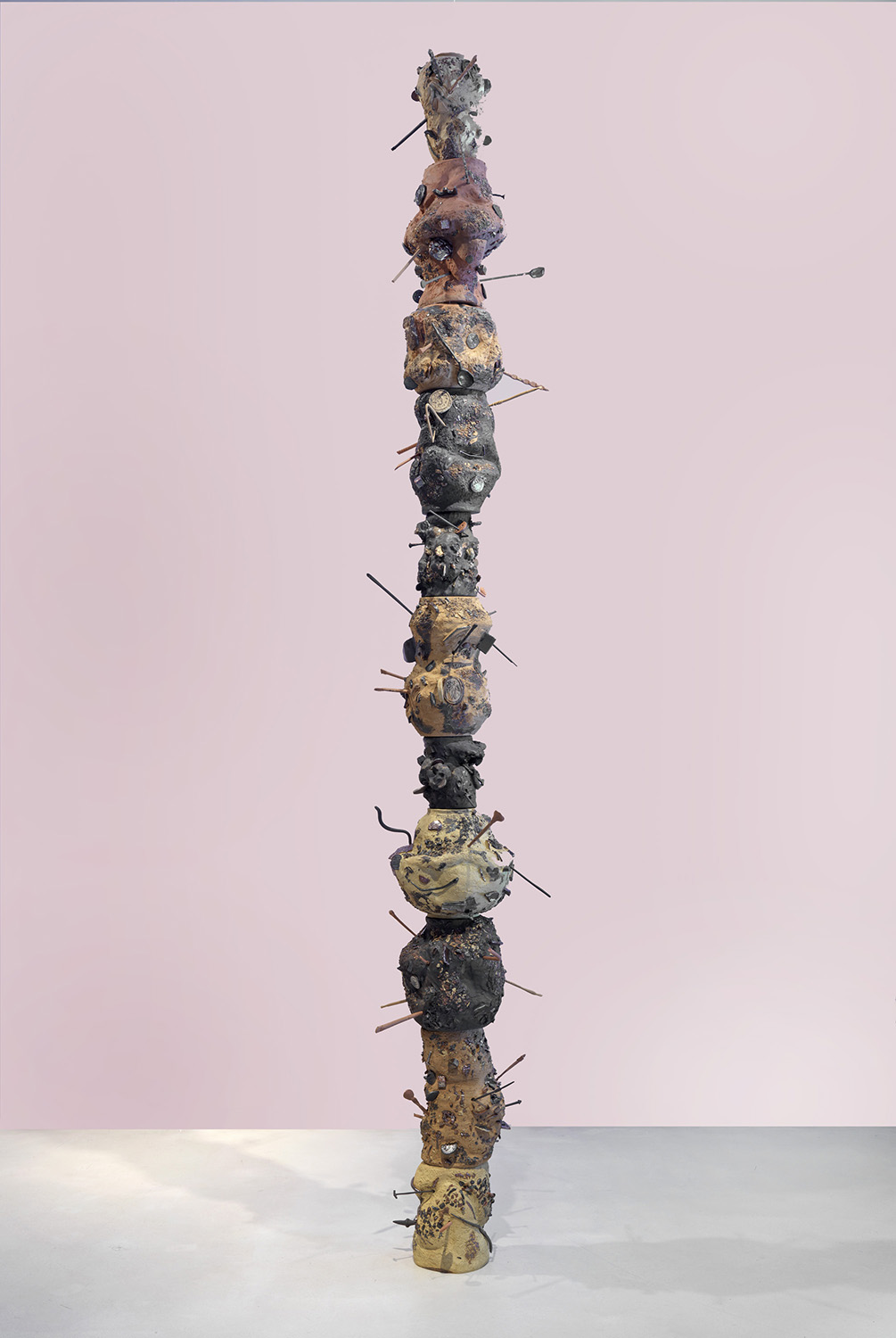
Column of Conglomerates, 2022.
ceramic with glazed details, 50 x 50 x 361cm. Exhibition view of Roman Rubbish, Bloomberg SPACE, London. 2022
Photo: Marcus Leith
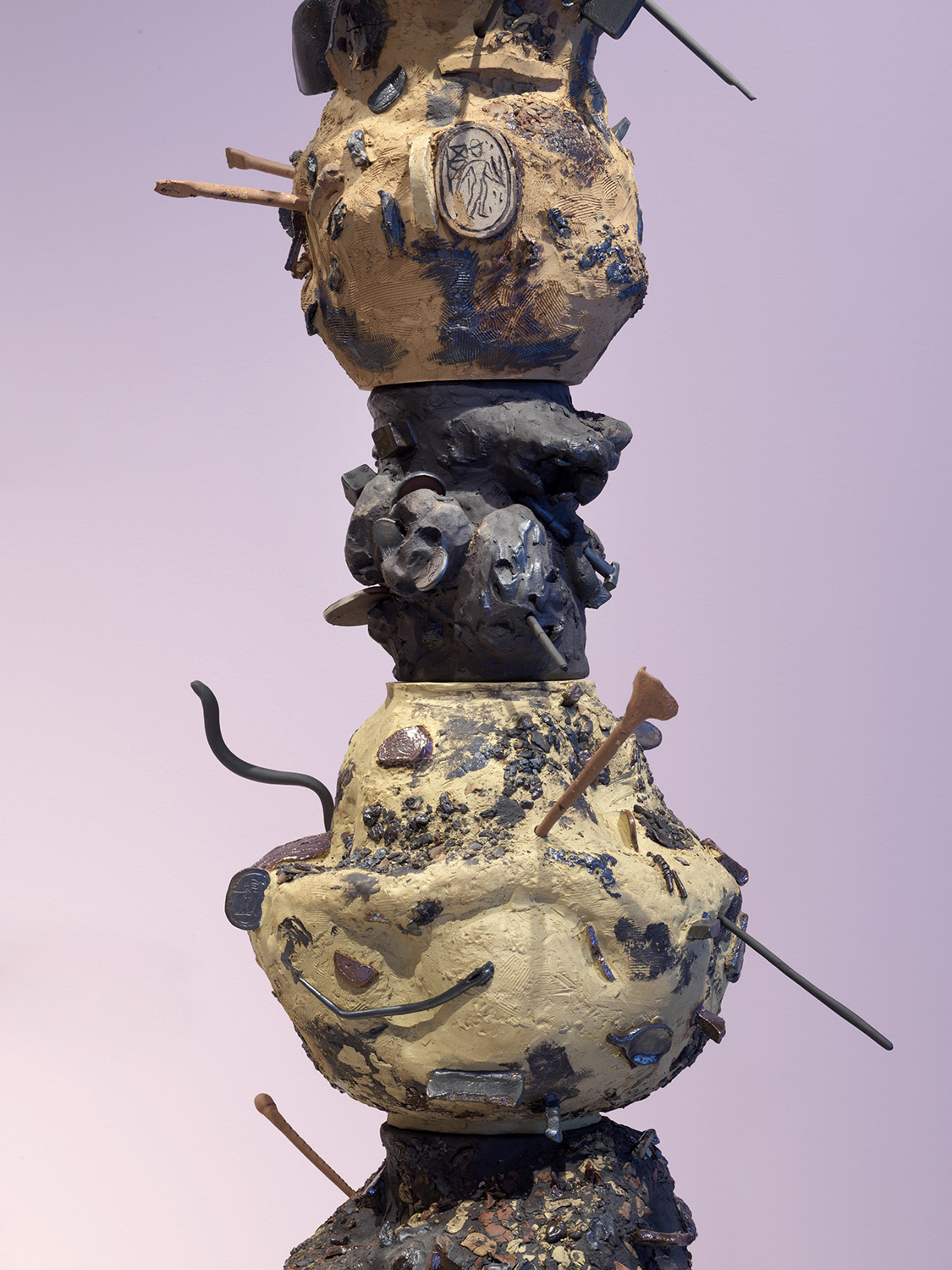
Detail of Column of Conglomerates, 2022.
ceramic with glazed details, 50 x 50 x 361cm. View in the exhibition Roman Rubbish, Bloomberg SPACE, London. 2022
Photo: Marcus Leith
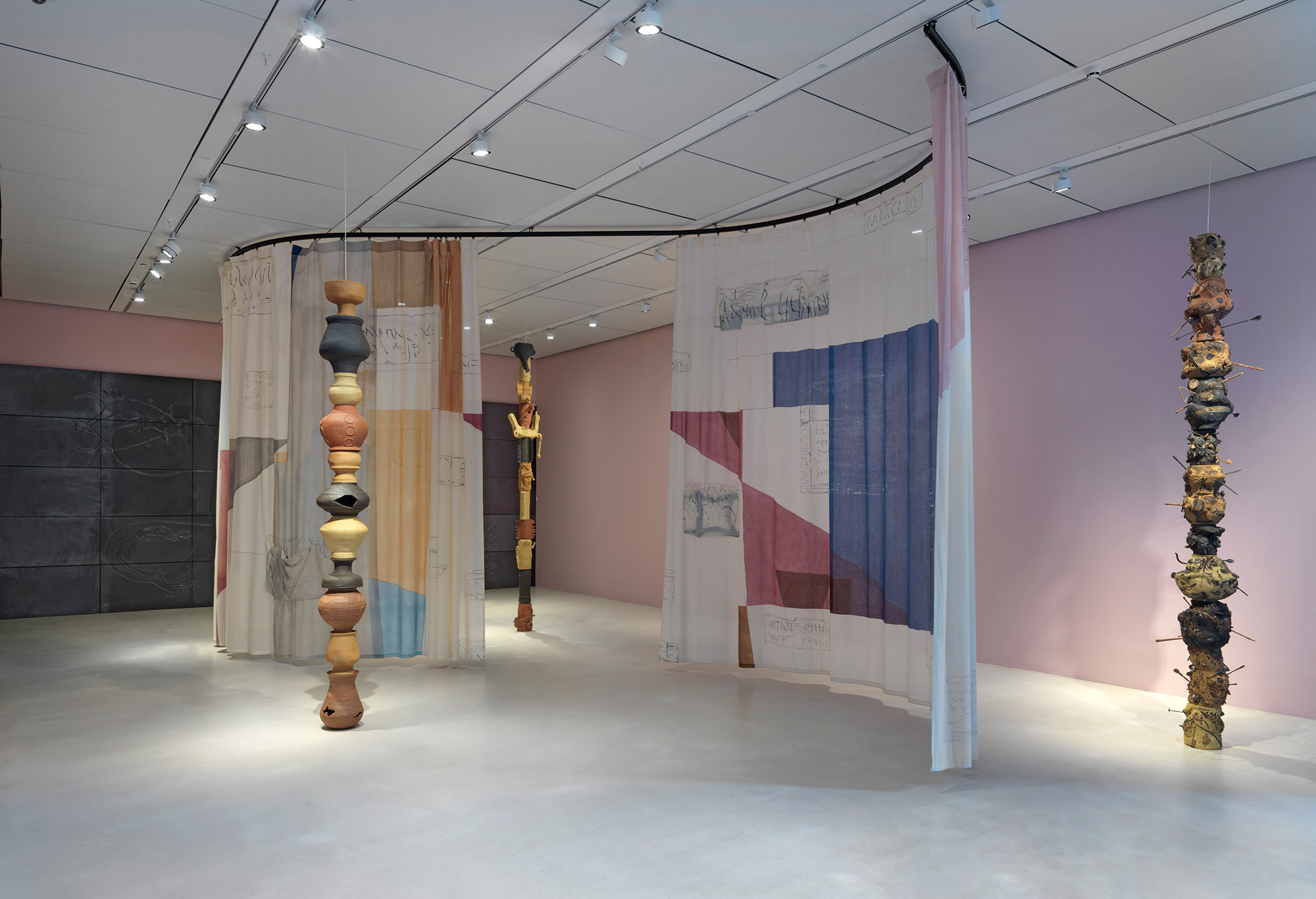
Exhibition view of Roman Rubbish, Bloomberg SPACE, London. 2022
Photo: Marcus Leith
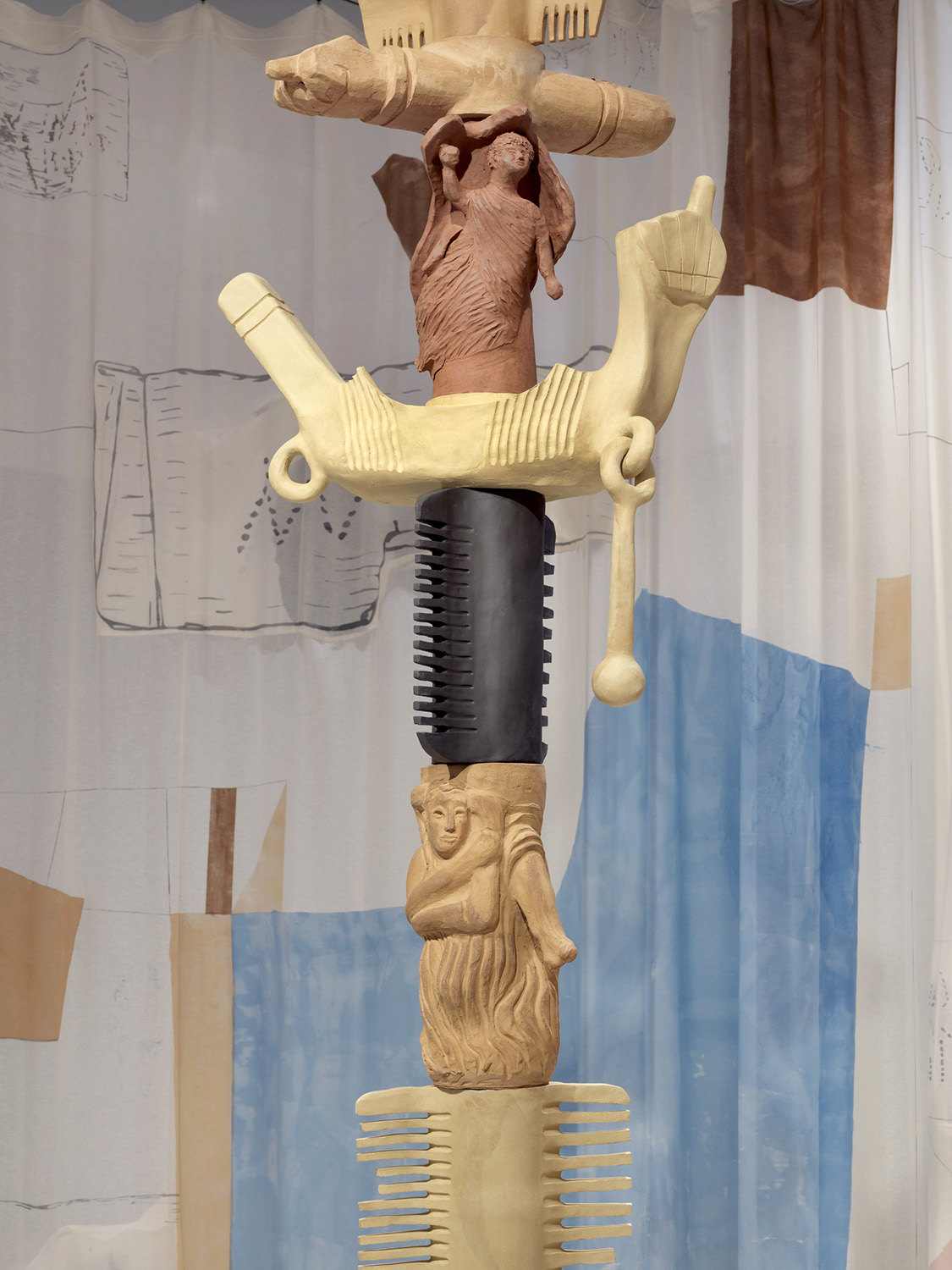
Detail of Column of Plenty, 2022.
ceramic, 65 x 65 x 370cm. View in the exhibition Roman Rubbish, Bloomberg SPACE, London. 2022
Photo: Marcus Leith
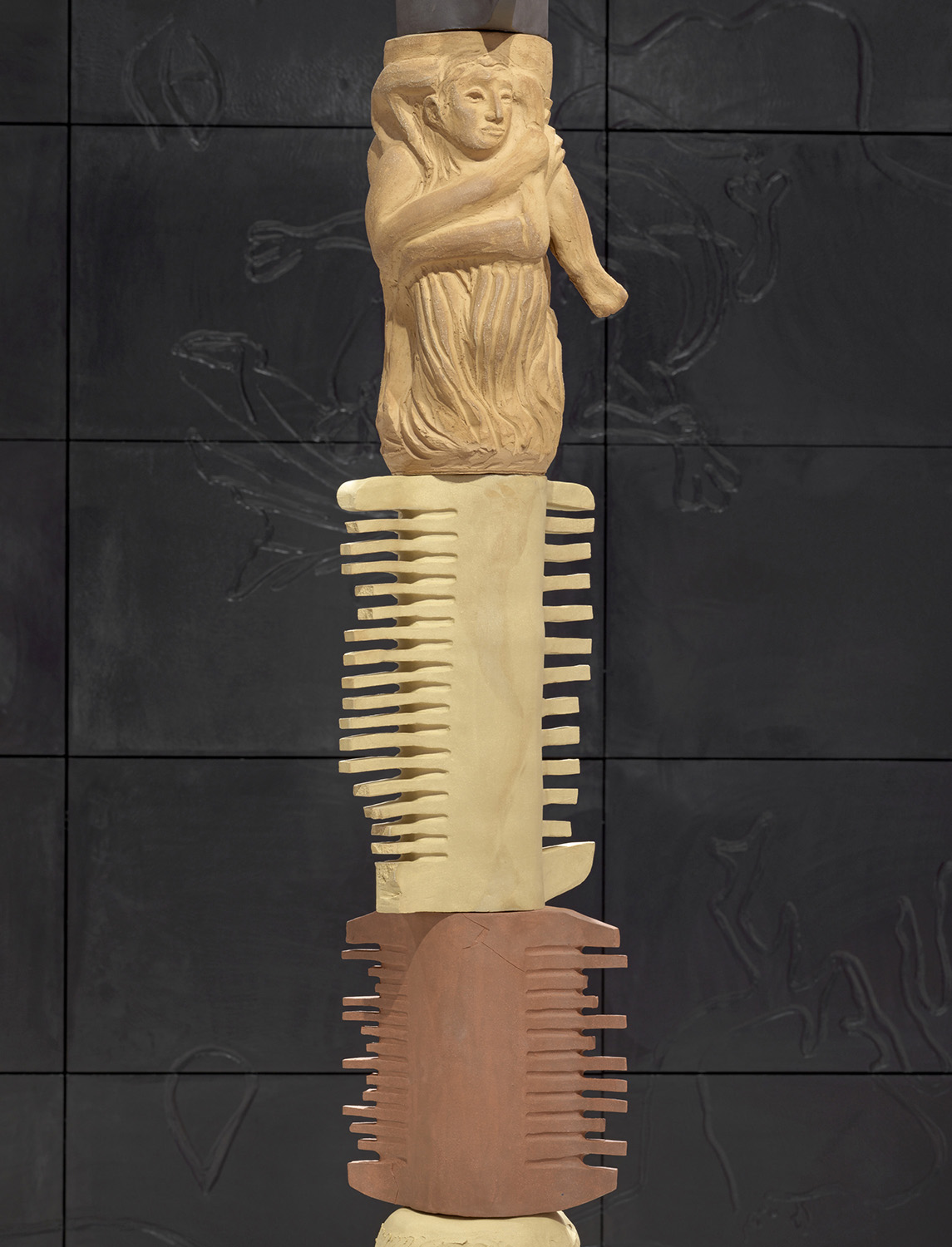
Detail of Column of Plenty, 2022.
ceramic, 65 x 65 x 370cm. View in the exhibition Roman Rubbish, Bloomberg SPACE, London. 2022
Photo: Marcus Leith
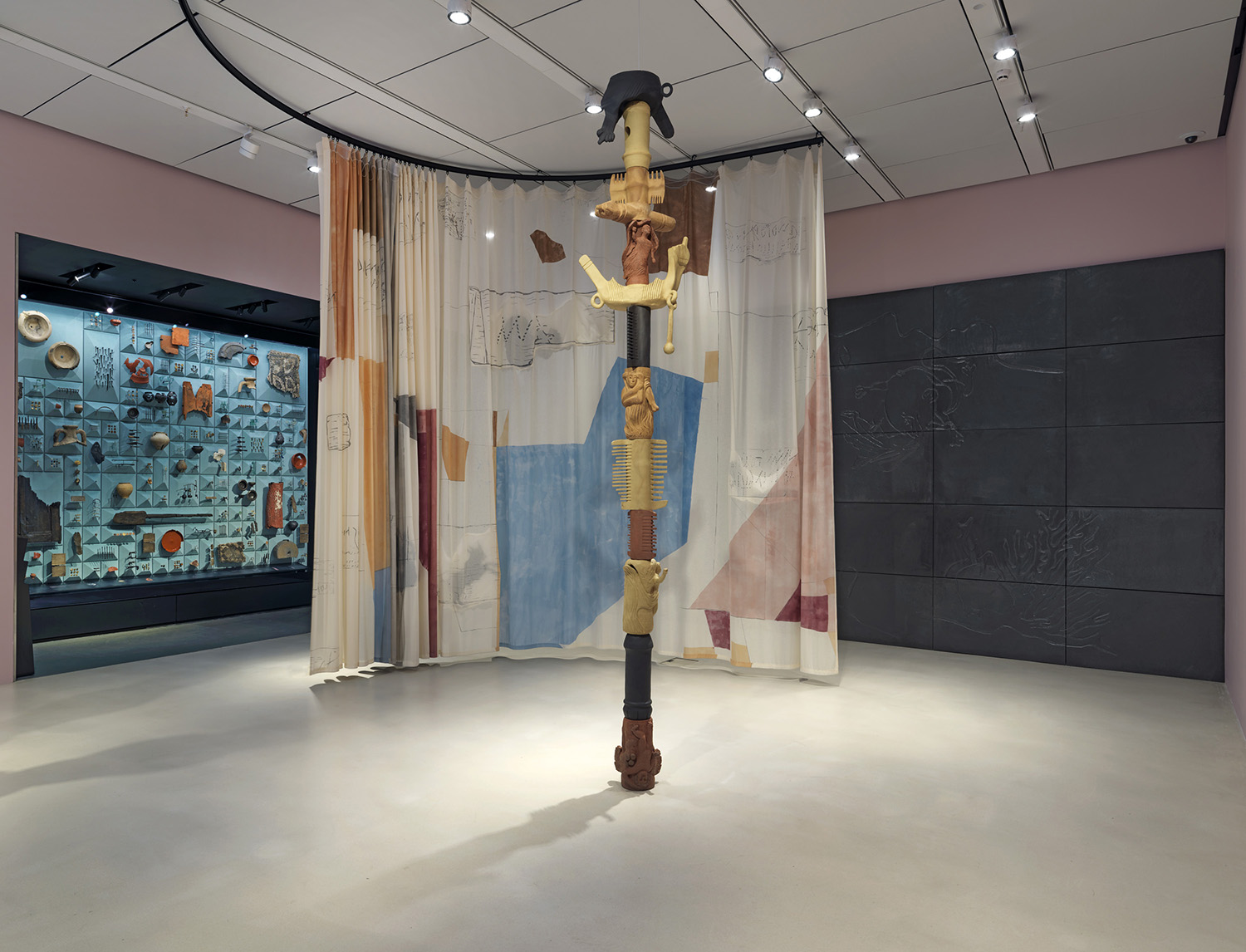
Column of Plenty, 2022.
ceramic, 65 x 65 x 370cm. Exhibition view of Roman Rubbish, Bloomberg SPACE, London. 2022
Photo: Marcus Leith
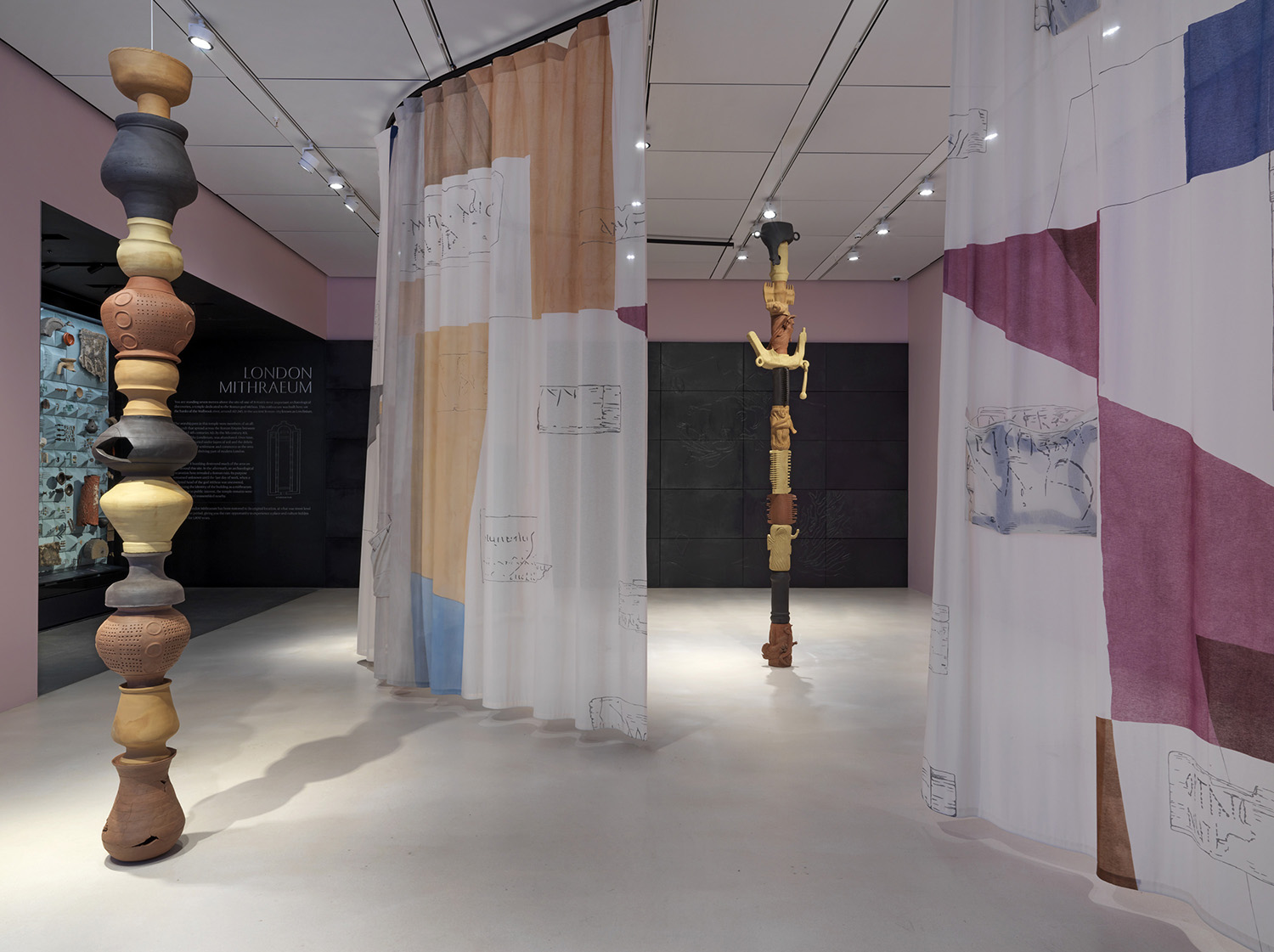
Exhibition view of Roman Rubbish, Bloomberg SPACE, London. 2022
Photo: Marcus Leith
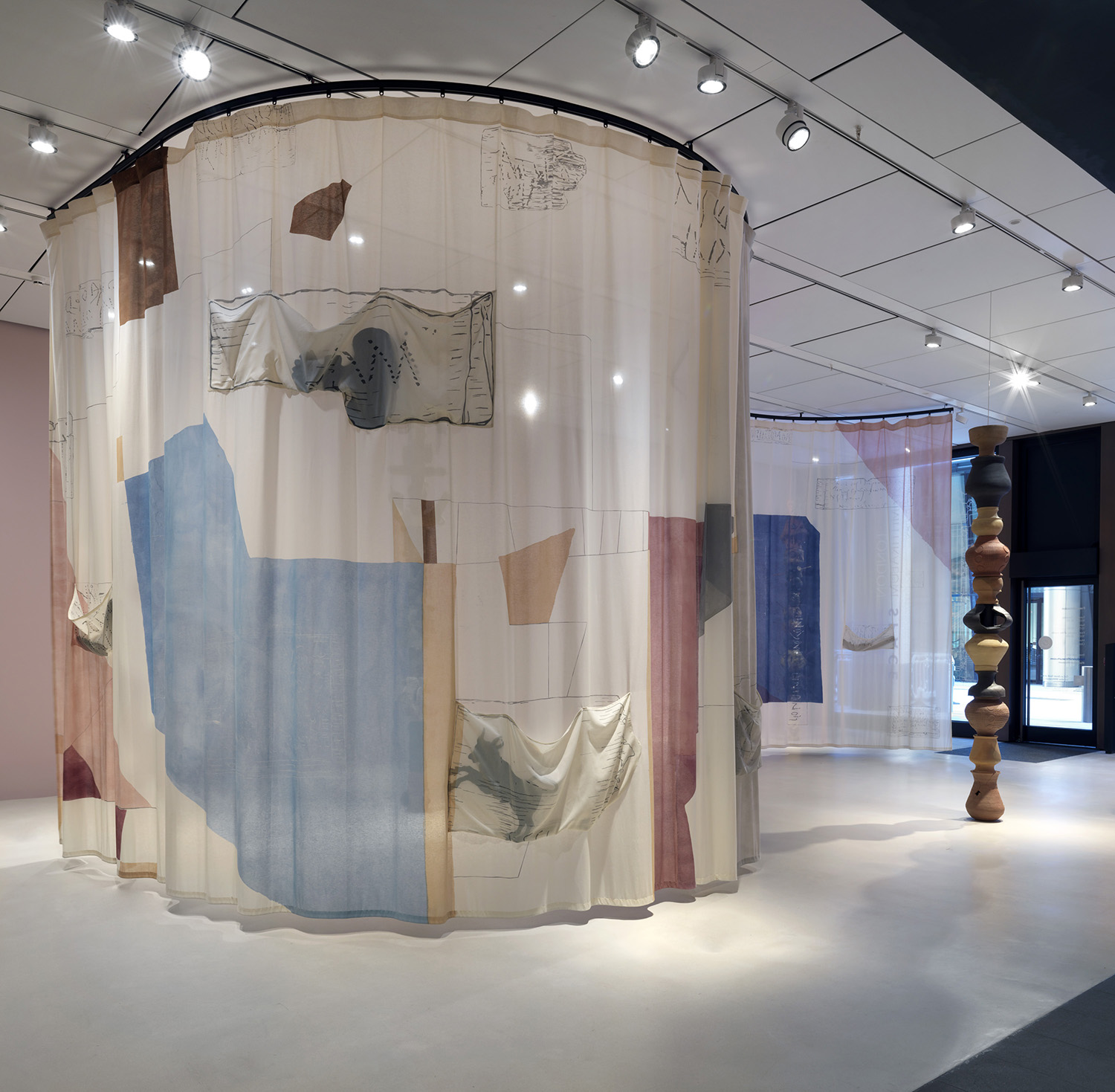
Rumour, as the future taste, hand painted cotton fabric, sewn on pockets with wooden silhouette inserts, 420cm ⨉ 2000cm, Bloomberg SPACE, London. 2022
Photo: Marcus Leith
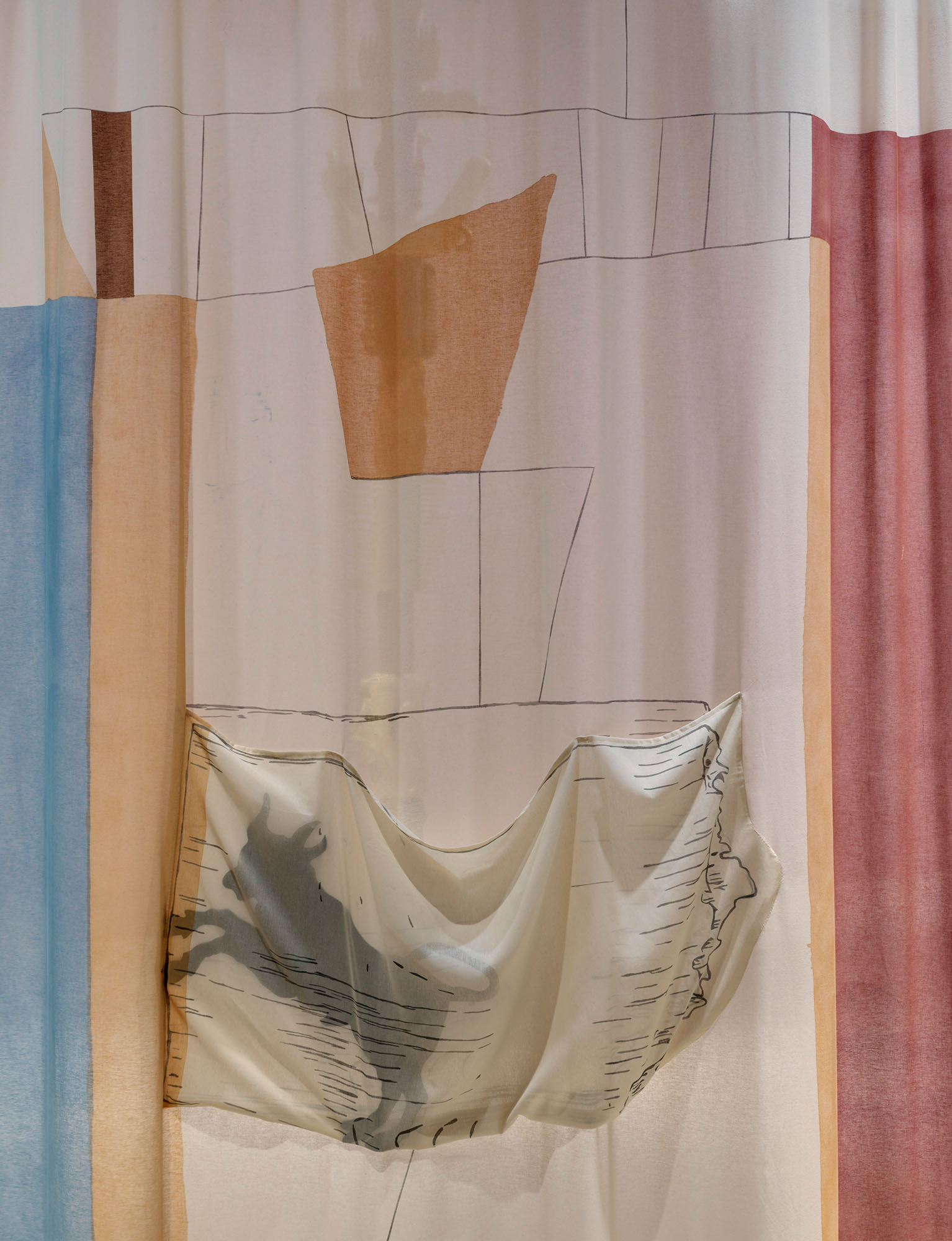
Detail of Rumour, as the future taste, hand painted cotton fabric, sewn on pockets with wooden silhouette inserts, 420cm ⨉ 2000cm, Bloomberg SPACE, London. 2022
Photo: Marcus Leith
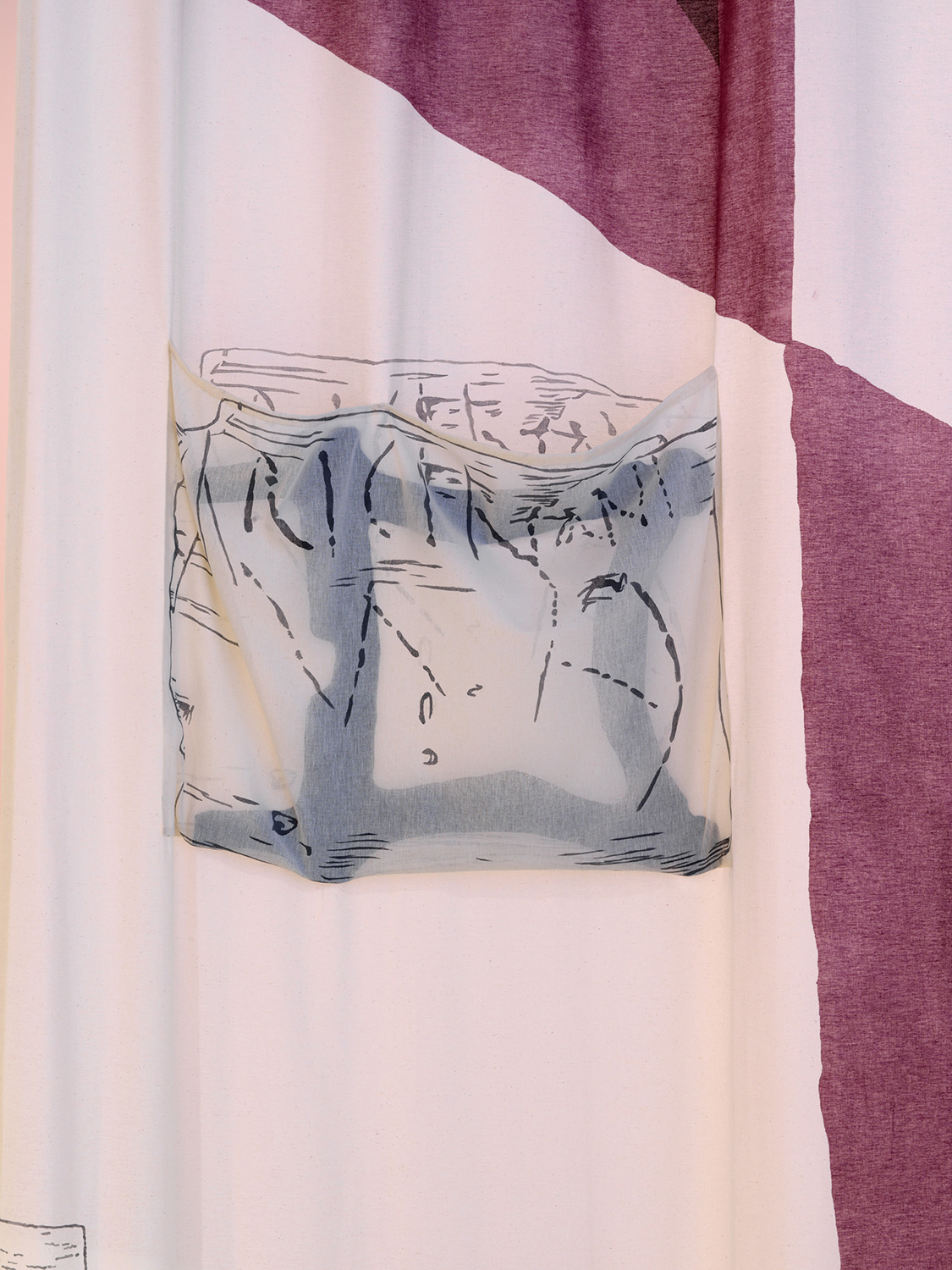
Detail of Rumour, as the future taste, Bloomberg SPACE, London. 2022
Photo: Marcus Leith
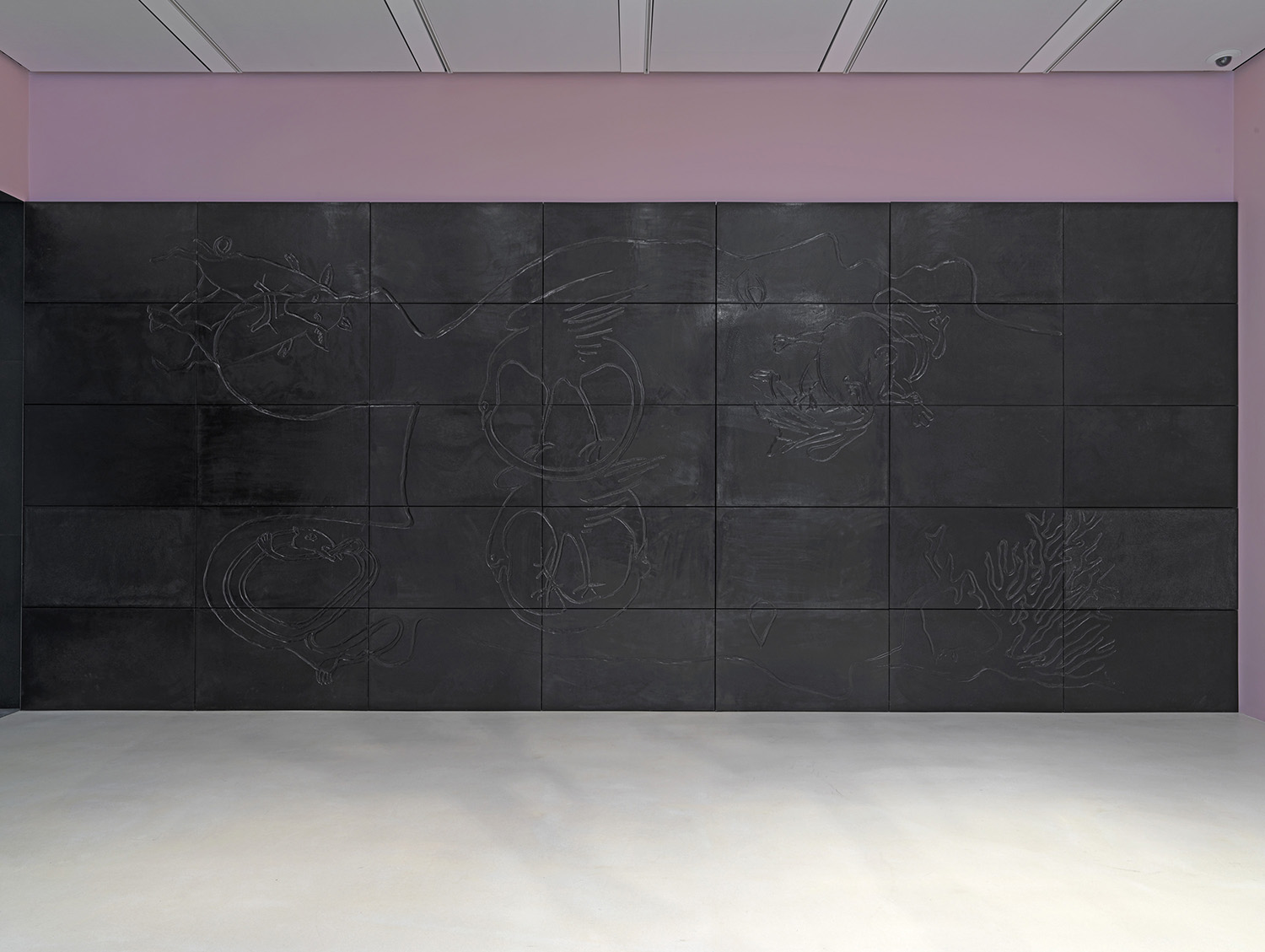
Dense silence swallows the dark black, 2022.
35 wax tiles with black pigment and carved drawing. 353cm ⨉ 845cm. Exhibition view of Roman Rubbish, Bloomberg SPACE, London. 2022
Photo: Marcus Leith
The Roman writing tablets have also inspired a monumental installation, a grid of black wax panels covering the gallery’s end wall into which Castillo Deball has inscribed a fantastical image featuring the profile of a Janus-like figure with two heads, a snake and birds eating their own tails alongside other animals and a bull being slain by Mithras. “Everything else in the exhibition is colourful and playful, so I thought it would be interesting to have a very dark work as a backdrop,” she says. “The image is from a drawing I made in 2011 for a project at the Venice Biennale called The Where I Am Is Vanishing, which was about the story of the Codex Borgia, a pre-Colombian pictorial manuscript from central Mexico that ended up in the Vatican Library. Some of the imagery came from the Warburg Institute, where there is a panel of Aby Warburg’s Mnemosyne Atlas that is dedicated to Mithras. One of these images by chance ended up in my drawing. I didn’t know who Mithras was until I started working on the Roman Rubbish exhibition. Returning to this drawing was probably a work of my unconscious, because I already knew that Mithras was there, but I somehow forgot about him.
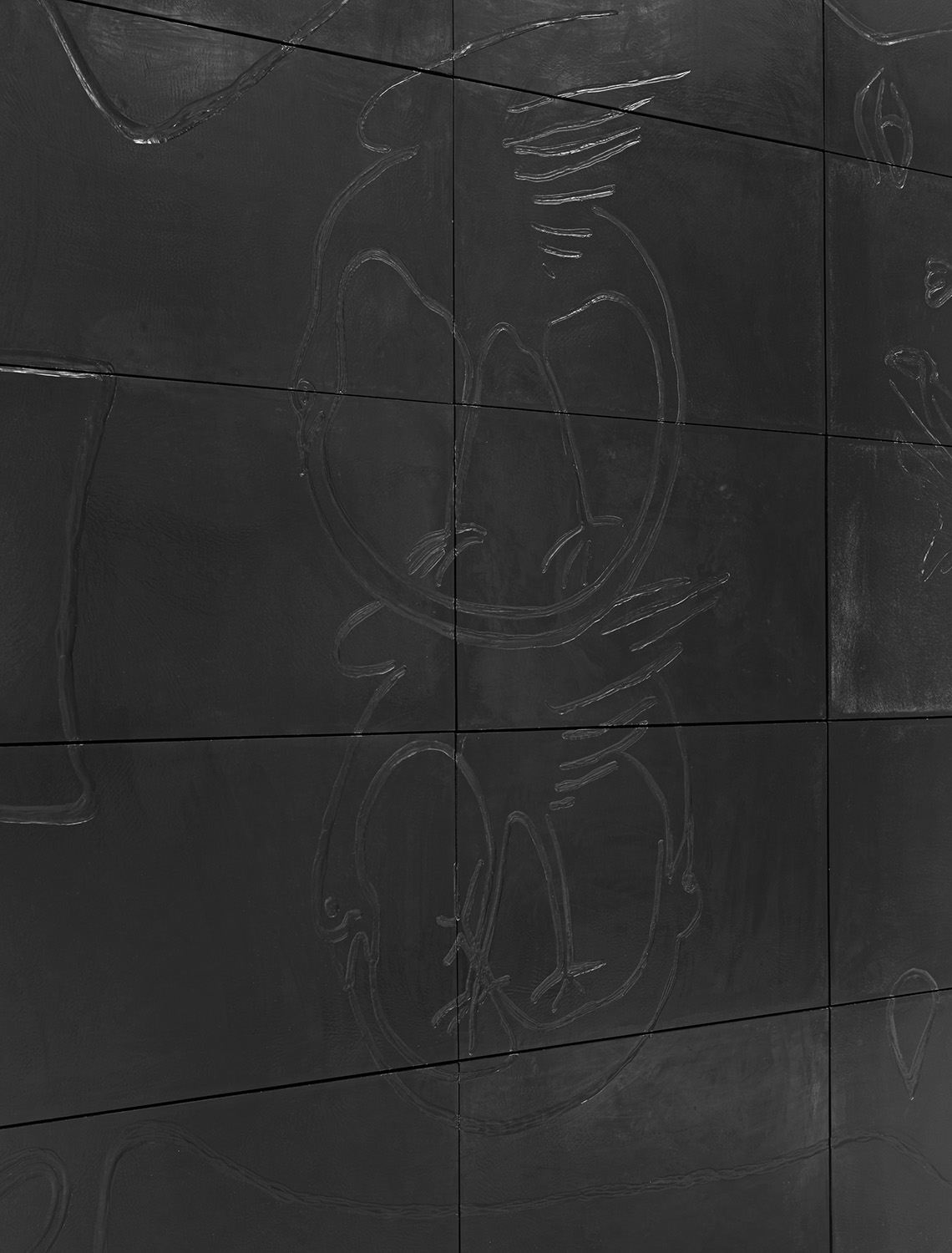
Detail: Dense silence swallows the dark black, 2022.
35 wax tiles with black pigment and carved drawing. 353cm ⨉ 845cm. Exhibition view of Roman Rubbish, Bloomberg SPACE, London. 2022
Photo: Marcus Leith
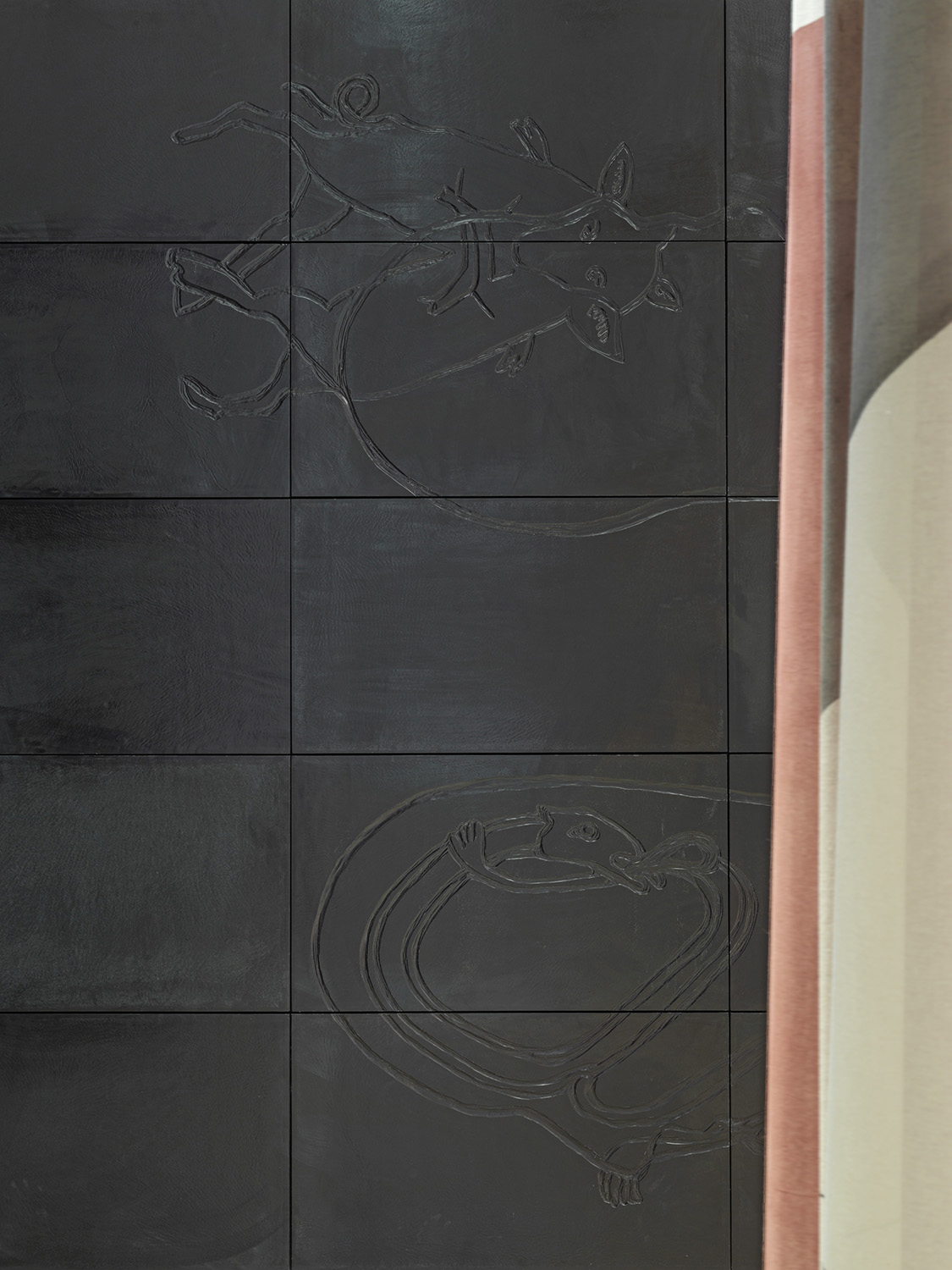
Detail: Dense silence swallows the dark black, 2022.
35 wax tiles with black pigment and carved drawing. 353cm ⨉ 845cm. Exhibition view of Roman Rubbish, Bloomberg SPACE, London. 2022
Photo: Marcus Leith
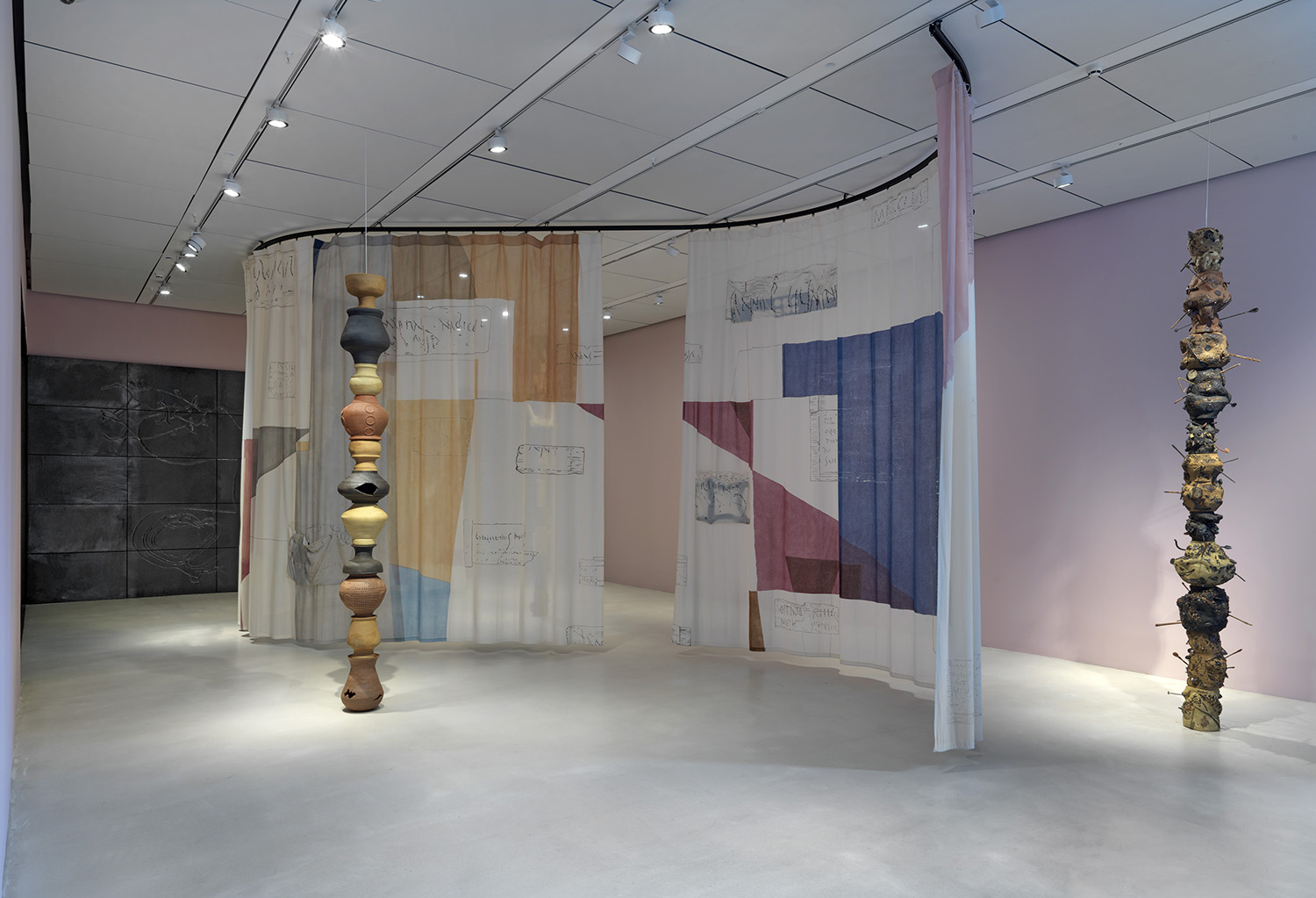
Exhibition view of Roman Rubbish, Bloomberg SPACE, London. 2022
Photo: Marcus Leith
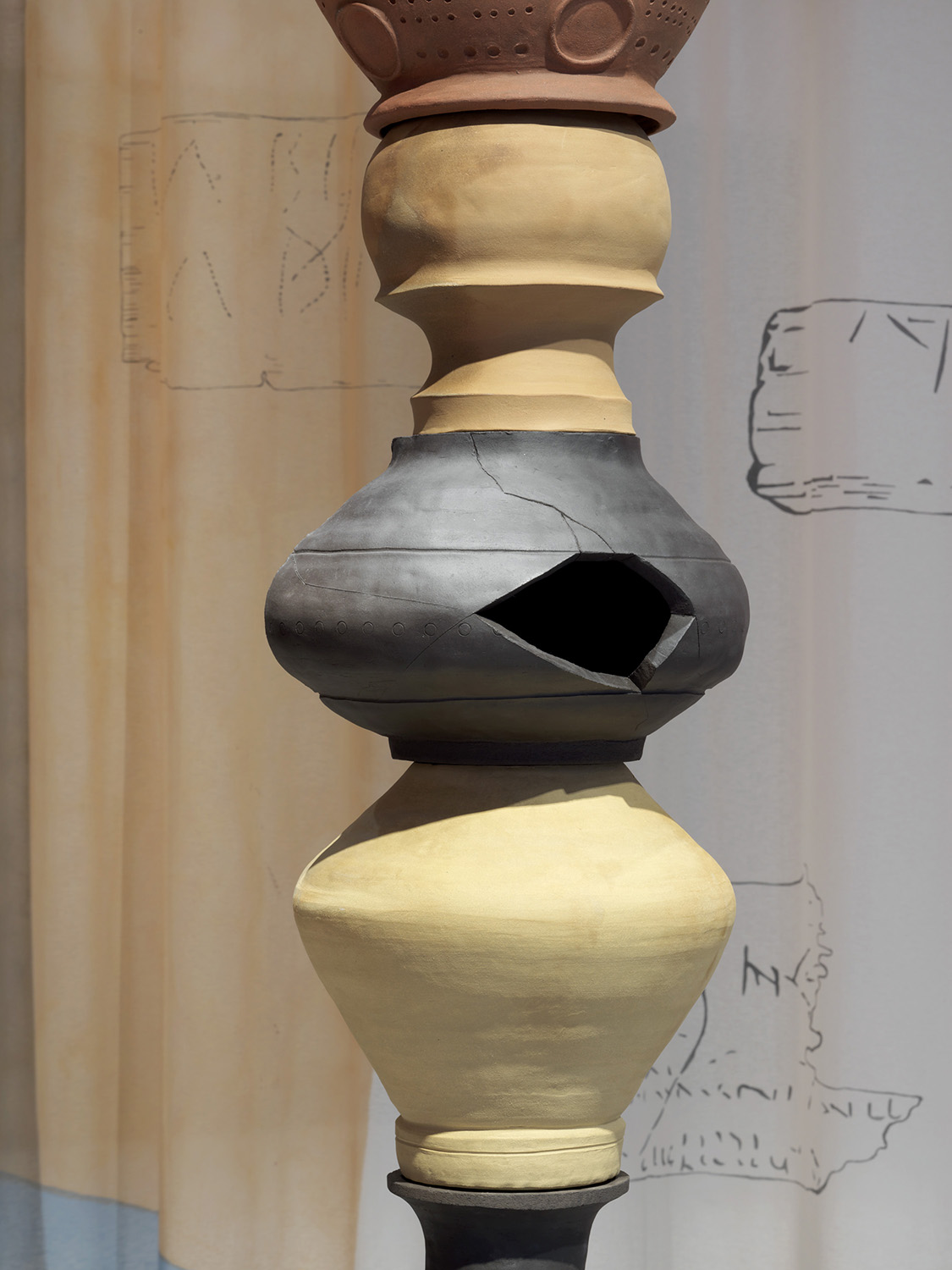
Detail of Column of Vessels, 2022.
ceramic, 50 x 50 x 333cm. View in the exhibition Roman Rubbish, Bloomberg SPACE, London. 2022
Photo: Marcus Leith
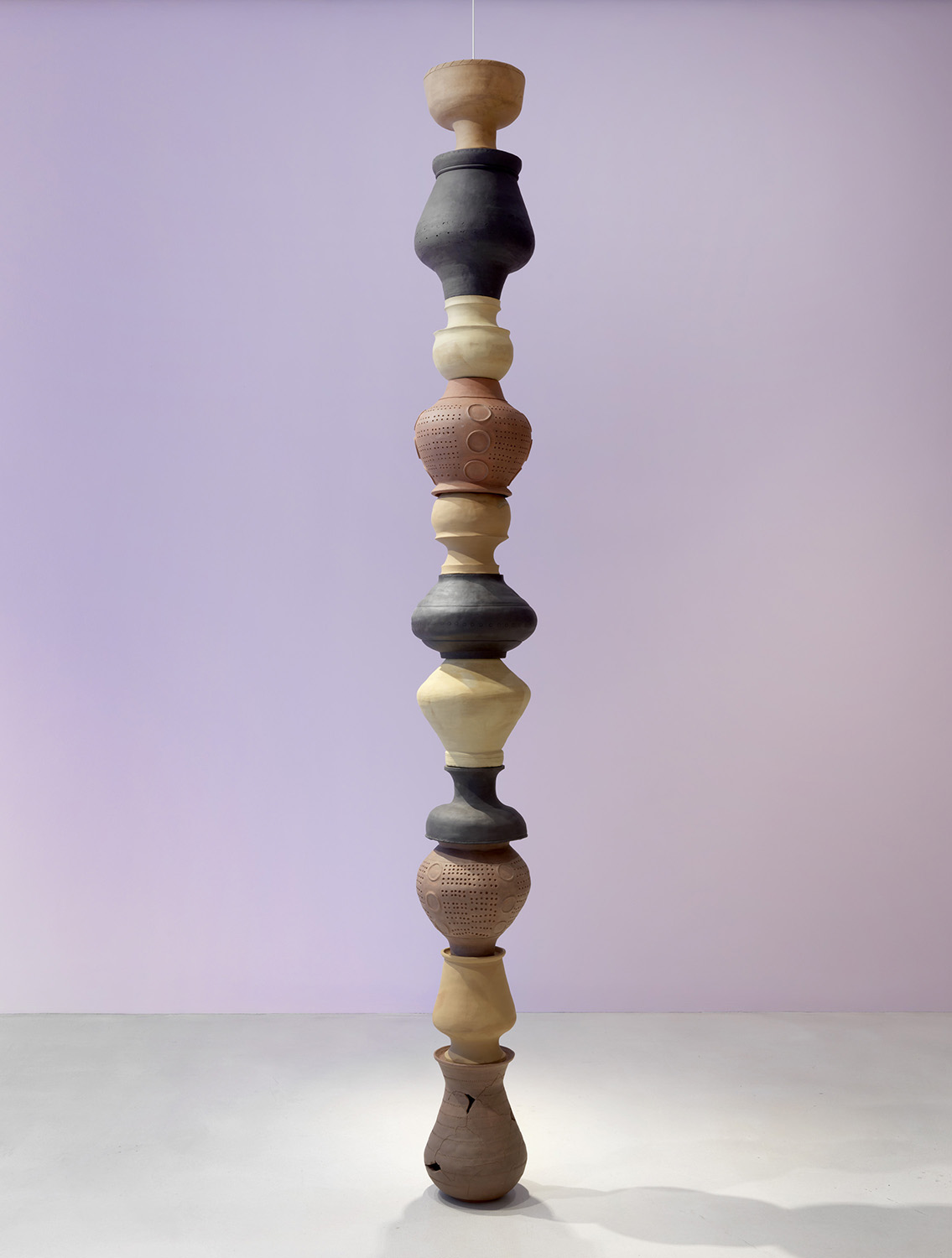
Column of Vessels, 2022.
ceramic, 50 x 50 x 333cm. Exhibition view of Roman Rubbish, Bloomberg SPACE, London. 2022
Photo: Marcus Leith
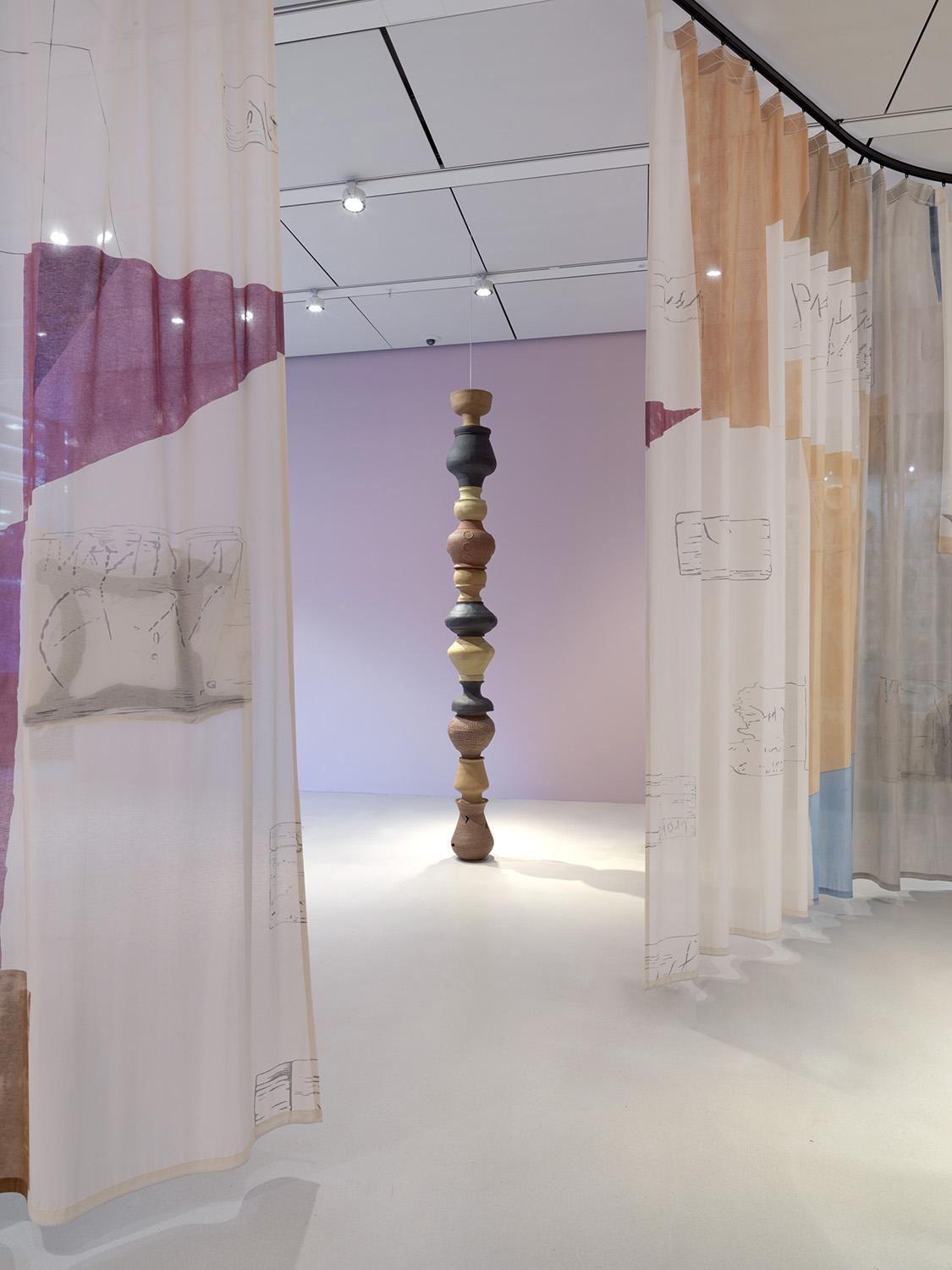
Exhibition view of Roman Rubbish, Bloomberg SPACE, London. 2022
Photo: Marcus Leith